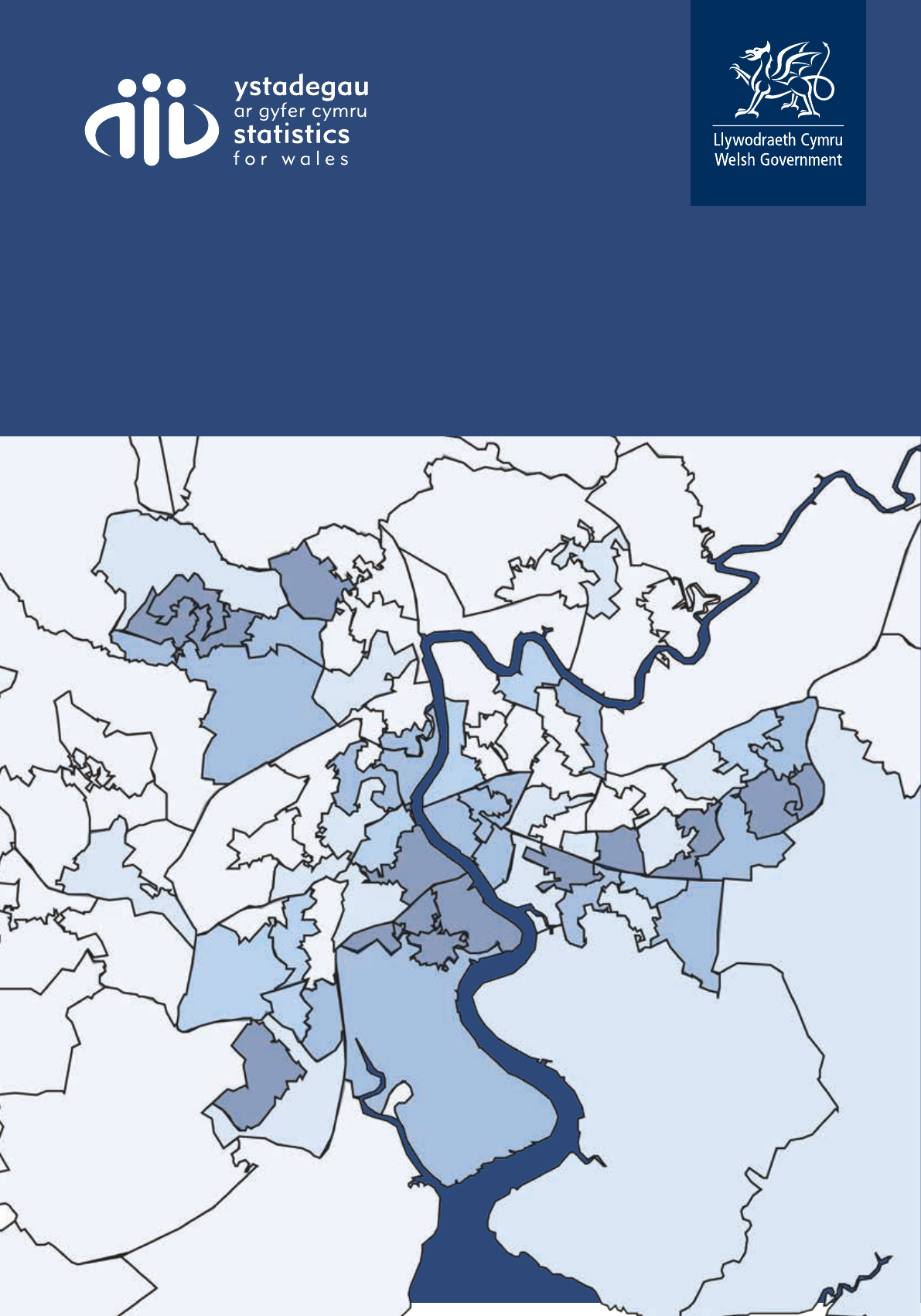
Welsh Index of Multiple Deprivation
(WIMD) 2019
Results report

Contact
Nia Jones
Social Justice Statistics
Knowledge and Analytical Services
Welsh Government
Cathays Park
Cardiff CF10 3NQ
Tel: 0300 025 4088 Email: stats.inclusion@gov.wales
SFR117/2019 © Crown copyright 2019
All content is available under the Open Government Licence v3.0, except where otherwise
stated.
Mae’r ddogfen yma hefyd ar gael yn Gymraeg / This document is also available in Welsh
1
Table of Contents
1. What is WIMD? ............................................................................................................. 2
2 WIMD 2019 Overall Index ............................................................................................. 7
3. Income Domain .......................................................................................................... 30
4. Employment Domain .................................................................................................. 39
5. Health Domain ............................................................................................................ 48
6. Education Domain ...................................................................................................... 57
7. Access to Services Domain ........................................................................................ 65
8. Housing Domain ......................................................................................................... 75
9. Community Safety Domain ......................................................................................... 84
10. Physical Environment Domain .................................................................................... 92
Annex A: Further background to WIMD ........................................................................... 101
Annex B: List of all indicators included in WIMD 2019...................................................... 103
We are grateful for the contributions of many people and organisations who have provided data and
advice for WIMD 2019.

2
1. What is WIMD?
The Welsh Index of Multiple Deprivation (WIMD) is the official measure of relative deprivation for
small areas in Wales. It is a National Statistic produced by statisticians at the Welsh Government.
WIMD identifies areas with the highest concentrations of several different types of deprivation. The
prime purpose of the Index is to provide the evidence needed about the most deprived areas of
Wales to inform a variety of decisions, such as funding or targeting of programmes and services for
local areas. WIMD ranks all small areas in Wales from 1 (most deprived) to 1,909 (least deprived).
1.1 What does WIMD measure?
WIMD is currently made up of eight separate domains (or types) of deprivation. Each domain is
compiled from a range of different indicators. The domains included in WIMD 2019 are:
Income
Employment
Health
Education
Access to Services
Housing
Community Safety
Physical Environment
WIMD is a measure of multiple deprivation that is both an area-based measure and a measure of
relative deprivation. Further explanation of these terms can be found in our WIMD 2019 Guidance,
but the key things to remember are, for WIMD:
‘Multiple’ refers to the multiple domains of the index, and also the way the indicators may
capture both material and social aspects of deprivation.
‘Deprivation’ does not just mean being poor. It refers to unmet need which is caused by a
lack of resources of other kinds, not just financial. It can mean having fewer resources and
opportunities than we might expect in our society, for example in terms of health or
education.
The ranks are calculated for all Lower layer Super Output Areas (LSOAs) in Wales. There
are 1,909 LSOAs in Wales with an average population of 1,600 people each. Further
information on LSOAs is provided in the Technical Report.

3
WIMD provides insight into area-based deprivation by measuring concentrations of
deprivation. However many non-deprived people live in deprived areas, and many deprived
people live in non-deprived areas.
The Index provides a way of identifying areas in the order of most to least deprived. It does
not provide a measure of the level of deprivation in an area, but rather whether an area is
more or less deprived relative to all other areas in Wales.
The Index methodology is designed to reliably distinguish between areas at the most
deprived end of the distribution, but not at the least deprived end. This means that
differences between the least deprived areas in Wales are less well defined than differences
between the more deprived areas.
1.2 How the Index is constructed
The Index has three main components:
The 47 underlying indicator datasets
Ranks for the eight separate domains (or types) of deprivation, created by combining
relevant indicators within each domain
Overall WIMD ranks, created by combining the domain ranks
All of these components are calculated for each of the small areas (LSOAs) in Wales. The indicator
data, domain ranks, and overall ranks are published on StatsWales. A full list of the indicators
included in WIMD 2019 can be found in Annex B. Detailed technical information on the indicators
and WIMD methodology can be found in the Technical Report.
The methodology used within WIMD 2019 is broadly the same as for the last Index, produced in
2014, with the same eight domains of deprivation captured. However there have been some
changes to the Index, including:
changes to individual indicators, or the inclusion of new indicators within the Health,
Education, Access to Services, Physical Environment and Housing domains
small changes to the relative weights applied to the domains (or types) of deprivation.
WIMD is constructed from a weighted sum of the deprivation score for each domain. The weights
reflect the importance of the domain as an aspect of deprivation, and the quality of the indicators
available for that domain.
The domain weights for WIMD 2019 are shown below, alongside the weights used in 2014.
Improvements to data used for the Housing and Health domains led to a decision to make small
increases to their weights. To allow for this, weights for the Income and Employment domains were
reduced slightly. However those domains retain the highest relative weights, since they are strong
determinants of deprivation.

4
Spreading a small amount of the weight previously placed on Income and Employment into other
domains also reflects the wide range of well-being goals set out in the Well-being of Future
Generations Act (Wales) 2015.
WIMD 2019
domain weight
WIMD 2014
domain weight
Income
22%
23.5%
Employment
22%
23.5%
Health
15%
14%
Education
14%
14%
Access to Services
10%
10%
Housing
7%
5%
Community Safety
5%
5%
Physical Environment
5%
5%
1.3 What can WIMD be used for?
Knowing how deprivation is distributed across Wales is important for many organisations when
developing area-based policies, programmes and funding. WIMD can be used (often alongside
other information) to inform these decisions and give a greater understanding of deprivation
patterns within Wales. WIMD can be used for:
Identifying the most deprived small areas
Comparing relative deprivation of small areas
Exploring the 8 domains (types) of deprivation for small areas
Comparing the proportion of small areas within a larger area (e.g. local authority) that are
very deprived
Using indicator data (but not the ranks) to compare absolute change over time
WIMD can also be used to look at the change in relative deprivation ranks between iterations, for
example which areas have left, joined or remained in the most deprived group. However care
should be taken in interpreting this for WIMD 2019. In order to produce the best possible snapshot
of relative deprivation, using the latest available data, we have changed some of the indicators,
domain weights, and the ONS have revised population estimates underlying some WIMD 2014
indicators. These refinements to the measurement of deprivation may have contributed to an area
becoming more (or less) deprived relative to others, rather than underlying shifts in relative
deprivation of areas since WIMD 2014.

5
Government programmes – national and local – aiming to tackle deprivation often use WIMD to
target activity on the most deprived areas. It is also used widely by local authorities, other public
bodies, the voluntary sector, academics and students, and the private sector. Examples of known
uses of the Index include:
targeting policies, and locating services or pilot areas
building area profiles
making and assessing funding bids and grant applications
measuring the effect of deprivation on outcomes like health inequalities
linking indicators of area deprivation to surveys for use in analysis
modelling likely demands e.g. on police forces and other emergency services
informing widening access schemes
evidencing local wellbeing and needs assessments
designing sample surveys or other studies
The WIMD 2019 Guidance document provides further details on where to start if you want to use
WIMD to provide an area profile, or to target activity.
The Index is most useful when used with other information, either from the underlying indicators,
other published sources or local information. References to useful contextual information are
included at the end of each domain chapter. There are a number of sources of information on local
areas that may be useful to users. These include:
Data on certain Welsh towns and communities made available through the Understanding
Welsh Places resource
Data on local authorities made available through the Thriving Places Wales resource
Labour Market and Census statistics for local areas made available through the Office for
National Statistics’ Nomis website
1.4 Limitations of WIMD
It is important to remember that WIMD is not the only way to measure deprivation. WIMD has been
developed for a particular purpose - to measure concentrations of deprivation at a small area level.
Below are some of the limitations of WIMD, and further details can be found in the WIMD 2019
Guidance. WIMD can’t be used for:
Quantifying how deprived a small area is
Saying how much more deprived one area is than another – the difference between two
ranks can be tiny or large

6
Using ranks to infer absolute change over time (as they are relative measures)
Identifying deprived people – not everyone who is deprived lives in a deprived area
Comparing with other UK countries - each country measures deprivation slightly differently
Measuring affluence (lack of deprivation is not the same as being affluent)
1.5 Further details
A package of products is available relating to WIMD 2019, including Guidance materials, a
Technical Report and an interactive website. Details of other current and planned publications are
available on the WIMD website. The WIMD 2019 overall ranks, domain ranks and underlying
indicator data are published on StatsWales.
For further information please contact stats.inclusi[email protected]ales.
1.6 Next update
WIMD is typically updated every 3 to 5 years, but the dates of publication for future Indices have not
yet been scheduled. Users can be kept informed of future developments by registering for e-mail
updates. To register, please e-mail stats.inclusion@gov.wales with ‘subscribe’ in the subject
heading.

7
2 WIMD 2019 Overall Index
2.1 Methodology: Overall Index
For a complete description of the construction of the Index, its domains, and the underlying
indicators, please see the WIMD 2019 Technical Report.
Domains
WIMD 2019 is made up of eight separate domains (or types) of deprivation. Each domain is
compiled from a range of different indicators. The weights for the eight domains are given below:
Methodological changes between WIMD 2014 and WIMD 2019
As explained in the introduction, the methodology used within WIMD 2019 is broadly the same as
for the last Index, produced in 2014, with the same eight domains of deprivation captured. However
there have been some changes to the Index, including:
changes to individual indicators, and the inclusion of new indicators within the Health,
Education, Access to Services, Physical Environment and Housing domains
small changes to the relative weights applied to the domains (or types) of deprivation.
These changes are described in more details in the relevant domain chapters, and in the WIMD
2019 Technical Report.
2.2 Overall Index key results
In WIMD 2019, there were pockets of high relative deprivation in the South Wales cities and
valleys, and in some North Wales coastal and border towns. This is shown in the map that
follows.
The overall picture is similar to that of WIMD 2014. Seven of the ten most deprived areas
from WIMD 2014 remained in the ten most deprived areas in WIMD 2019.
The most deprived small area in Wales in WIMD 2019 was Rhyl West 2 (the area around
Rhyl High Street) in Denbighshire, which was ranked second most deprived in WIMD 2014.
The neighbouring area of Rhyl West 1 is now ranked second most deprived.
8
The former most deprived area in WIMD 2014, St James 3 (which contains a large part of
the Lansbury Park estate in Caerphilly) is now ranked third most deprived.
The local authority with the highest proportion of small areas in the most deprived 10% in
Wales in WIMD 2019 was Newport (24.2%). Blaenau Gwent had the highest percentage of
areas in the most deprived 50% in Wales (85.1%).
Monmouthshire had no areas in the most deprived 10%, and Powys only 1.3% (or 1 area).
Analysis of deep-rooted deprivation looks at areas that have remained in the top 50 most
deprived for all WIMD iterations in the past 15 years. There are 26 small areas in deep-
rooted deprivation, spread across ten Local Authorities.

9

10
2.3 Comparison between WIMD 2014 and WIMD 2019
The full set of domain ranks from WIMD 2019 and the underlying indicators can be downloaded
from the Welsh Government’s StatsWales web pages.
WIMD cannot be used to compare deprivation for one area with its deprivation in a previous
iteration of the Index. However, the following analysis provides an illustration of how the deprivation
groups of WIMD 2019 compare with WIMD 2014. A similar approach has been used in the other
analysis sections.
The table below shows the number of small areas (LSOAs) in each of the WIMD deprivation groups
for WIMD 2014 and WIMD 2019. The deprivation groups are used within the main WIMD analyses,
including maps. They are designed to have smaller groups at the more deprived end, where the
difference between areas is greater than at the less deprived end.
The diagonal, in bold, shows the number of areas which have remained in the same deprivation
group. Above the diagonal are numbers of areas which have moved from a more to a less deprived
group. Below the diagonal are the numbers of areas which have moved from a less to a more
deprived group.
Table 1: Deprivation group movements for the Overall Index, between WIMD 2014
and WIMD 2019
Most areas have remained in the same deprivation group between WIMD 2014 and WIMD 2019 (on
the diagonal). Only three areas have changed by more than one deprivation group. However the
10% most
deprived
(ranks
1-191)
10-20%
most
deprived
(ranks
192-382)
20-30%
most
deprived
(ranks
383-573)
30-50%
most
deprived
(ranks
574-955)
50% least
deprived
(ranks
956-1909)
Total
(ranks
1-1909)
10% most
deprived
(ranks 1-191)
165 25 1 0 0 191
10-20% most
deprived
(ranks 192-382)
25 130 35 1 0 191
20-30% most
deprived
(ranks 383-573)
1 36 112 42 0 191
30-50% most
deprived
(ranks 574-955)
0 0 43 284 55 382
50% least
deprived
(ranks 956-1909)
0 0 0 55 899 954
Total
(ranks 1-1909)
191 191 191 382 954 1909
WIMD domain 2019
WIMD domain 2014
11
ranks are relative, and no conclusion about changes to the levels of deprivation can be drawn from
changes to the Index ranks. The underlying indicators, which measure various types of deprivation,
can be analysed in order to understand how levels of deprivation have changed in individual areas.
Of the three areas that have moved by two deprivation groups, one moved from the 20-30% most
deprived in WIMD 2014 to the top 10% most deprived in 2019. This area is Colwyn 2, which is
located around the Tan-y-Lan and Penmaen Head area of Old Colwyn in Conwy, and its overall
rank changed from 522 in 2014 to 190 in 2019. It became relatively more deprived in five domains,
in the following order of greatest to smallest change: Health, Income, Employment, Community
Safety and Education.
The other two areas that moved a notable amount became relatively less deprived.
Blackmill 2, in the Ogmore Valley (Bridgend), moved from the top 10% most deprived group
in WIMD 2014 to the 20-30% most deprived group in WIMD 2019. Its overall Index rank
changed from 171 in 2014 to 392 in 2019. This area became relatively less deprived in
seven of the domains, in the following order of greatest to smallest change: Community
Safety, Education, Health, Access to Services, Employment, Physical Environment and
Income. However, it became relatively more deprived in Housing (note that the
measurement of housing deprivation has changed).
Tonyrefail West 1 covers Edmondstown and part of Penrhiwfer, south of Tonypandy in
Rhondda Cynon Taf. It moved from the 10-20% most deprived group in WIMD 2014 to the
30-50% most deprived group in WIMD 2019, and its overall Index rank changed from 280 to
577. This area became relatively less deprived in seven domains, in the following order of
greatest to smallest change: Community Safety, Physical Environment, Education, Health,
Employment, Access to Services and Income.

12
2.4 Analysis of the most deprived areas in WIMD 2019
The table below lists the ten most deprived areas in Wales, as determined by WIMD 2019, together
with three areas that were ranked between 1 and 10 in WIMD 2014, but have moved out of that
group in WIMD 2019.
Note that WIMD does not measure the level of deprivation in a small area, but rather whether an
area is more or less deprived relative to all other small areas in Wales. It is not possible to
determine from a change in rank alone whether deprivation has improved or not in an area, but the
underlying indicators may be used for this.
For example, most areas have seen decreases in the rate of employment deprivation between
indices. Overall, the rate of employment deprivation
1
decreased from 13% in WIMD 2014 to 10% in
WIMD 2019. Areas that rank highly compared to other areas may have seen decreases in absolute
deprivation since WIMD 2014.
Table 2: WIMD 2019 most deprived areas
1
The employment deprivation indicator measures the rate of working age people in receipt of Jobseekers
Allowance, Employment Support Allowance, or on Universal Credit and not in work. Changes to the welfare
system since WIMD 2014 mean that eligibility thresholds and criteria for some benefits have changed.
LSOA Local authority LSOA name
WIMD 2014
Rank
WIMD 2019
Rank
W01000240 Denbighshire Rhyl West 2 2 1
W01000239 Denbighshire Rhyl West 1 11 2
W01001421 Caerphilly St. James 3 1 3
W01001274 Rhondda Cynon Taf Tylorstown 1 5 4
W01000991 Bridgend Caerau (Bridgend) 1 6 5
W01001209 Rhondda Cynon Taf Penrhiwceiber 1 15 6
W01001308 Merthyr Tydfil Penydarren 1 14 7
W01001428 Caerphilly Twyn Carno 1 7 8
W01000413 Wrexham Queensway 1 3 9
W01001662 Newport Pillgwenlly 4 10 10
W01001874 Cardiff Splott 6 4 12
W01001303 Merthyr Tydfil Merthyr Vale 2 8 34
W01001222 Rhondda Cynon Taf Pen-y-waun 2 9 15

13
Rhyl West 2, Denbighshire was the most deprived small area in Wales (it was ranked 2 in
WIMD 2014).
Seven of the ten most deprived areas in WIMD 2014 remained in the most deprived ten
areas in WIMD 2019.
Three areas have moved out of the most deprived ten areas since WIMD 2014.
We look at the ten most deprived areas (and those that have left the top 10) in greater detail below,
providing additional context about the areas.
As part of these descriptions we make reference to “area classifications” published by the Office for
National Statistics (ONS), which use socio-economic and demographic data from each census to
identify areas of the country with similar characteristics, and place them into groups based on
statistical techniques. After the 2011 Census, super output areas were classified into supergroups,
and beneath them, groups. Some examples of supergroups are “hard-pressed communities” or
“countryside living”. Data on super output area cluster membership are published on the ONS
website, as well as pen portraits of the different groups.
We also make reference to the following sources:
2017 LSOA Population estimates on StatsWales
Key statistics from the 2011 Census
WIMD 2019 indicator data on income deprivation
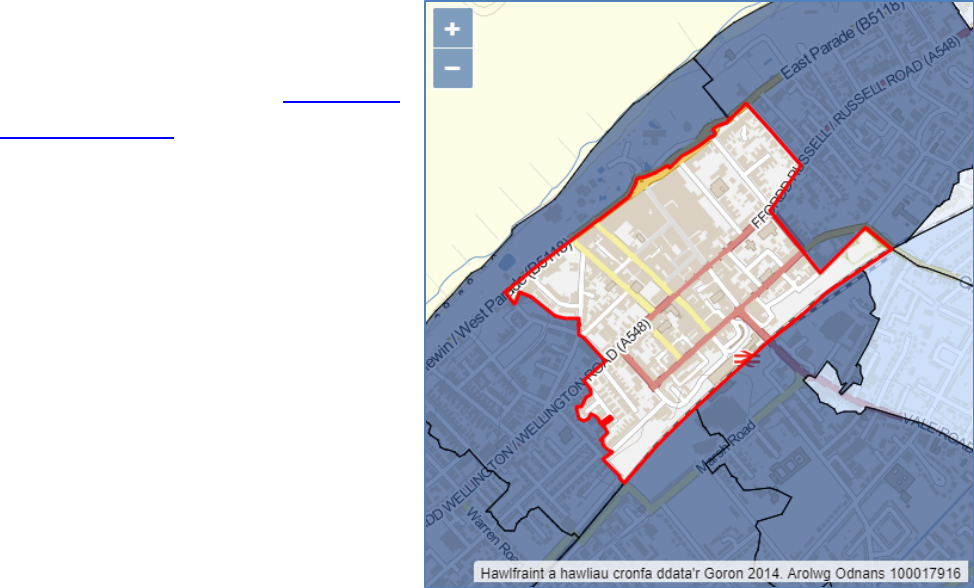
14
1. Rhyl West 2, Denbighshire
Rhyl West 2, around Rhyl High Street, is
the most deprived small area in Wales
according to WIMD 2019. Its WIMD 2019
deprivation profile shows that Rhyl West
2 lies within the 10 most deprived areas
for the Income, Employment, Health,
Education and Community Safety
domains. It also lies within the 10% most
deprived (the top 191 areas) in terms of
Housing. WIMD indicator data shows that
61% of people in Rhyl West 2 were in
income deprivation in 2016-17.
The area was previously ranked 2
(second most deprived) in WIMD 2014. It
is one of the areas of “deep-rooted”
deprivation described in section 2.6,
which identifies areas that have
consistently been in the top 50 most deprived areas since WIMD 2005. Rhyl West 2 has been
ranked 1 or 2 (first or second most deprived area) in each iteration of the Index since WIMD 2005.
Population estimates for 2017 show that 20% of the area’s population are aged under 16, and a
further 67% aged 16-64 (higher than the Wales average of 18% and 62%, respectively). The 2011
Census showed:
nearly 80% of housing was rented: 49% private rented and 30% social rented households
(compared to 14% and 16% for Wales, respectively)
a higher than average proportion of one person households (60% compared to 31% for
Wales)
77% of dwellings were flats, maisonettes or apartments (13% for Wales), as opposed to a
whole house
a higher than average percentage of people from a non-white ethnic group (6.2% compared
to 4.4% across Wales)
nearly 10% of residents were born outside the UK (5.5% across Wales)
Census area classifications place Rhyl West 2 in the “hard-pressed communities” category
(and the “constrained renters” group), which has the highest rate of unemployment across
categories
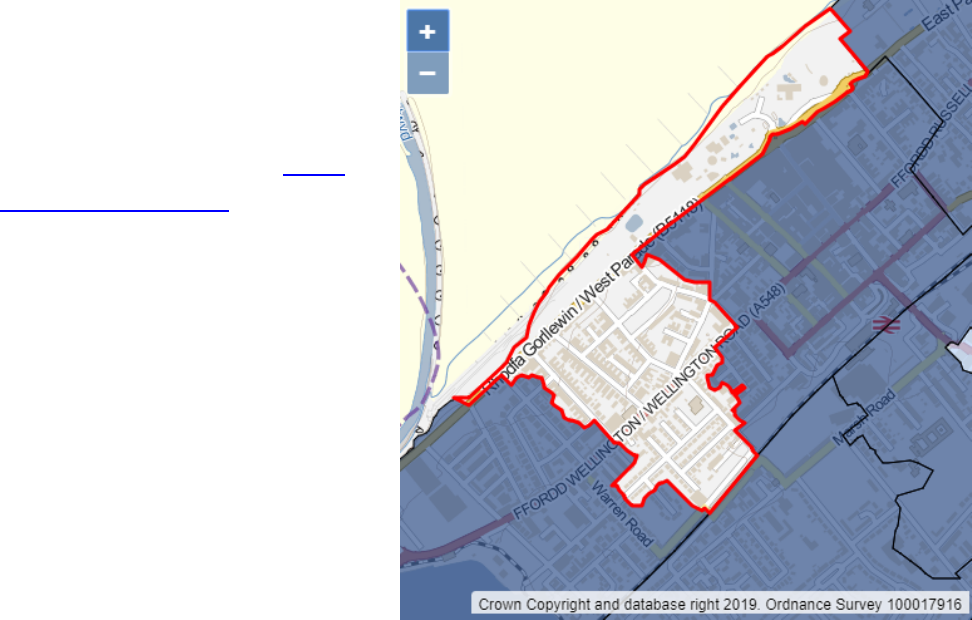
15
2. Rhyl West 1, Denbighshire
Rhyl West 1, the central terraced
housing area which neighbours Rhyl
West 2 (above), is the second most
deprived small area in Wales
according to WIMD 2019. Its WIMD
2019 deprivation profile shows that
Rhyl West 1 lies within the 10 most
deprived areas for the Income,
Employment, and Health domains. It
also lies within the 10% most deprived
(the top 191 areas) in terms of
Education, Housing and Community
Safety. WIMD indicator data shows
that 50% of people in Rhyl West 1
were in income deprivation in 2016-17.
The area was previously ranked 11 in
WIMD 2014. It is one of the areas of
“deep-rooted” deprivation described in section 2.6, which identifies areas that have consistently
been in the top 50 most deprived areas since WIMD 2005. Rhyl West 1 has been ranked within the
12 most deprived areas for each iteration of the Index since WIMD 2005.
Population estimates for 2017 show that over 20% of the area’s population are aged under 16, and
a further 66% aged 16-64 (higher than the Wales average of 18% and 62%, respectively). The 2011
Census showed:
70% of housing was rented: 44% private rented and 26% social rented households
(compared to 14% and 16% for Wales, respectively)
a higher than average proportion of one person households (53% compared to 31% for
Wales)
64% of dwellings were flats, maisonettes or apartments (13% for Wales), as opposed to a
whole house
a higher than average percentage of people from a non-white ethnic group (8.6% compared
to 4.4% across Wales)
nearly 11% of residents were born outside the UK (5.5% across Wales)
Census area classifications place Rhyl West 1 in the “hard-pressed communities” category
(and the “constrained renters” group), which has the highest rate of unemployment across
categories.
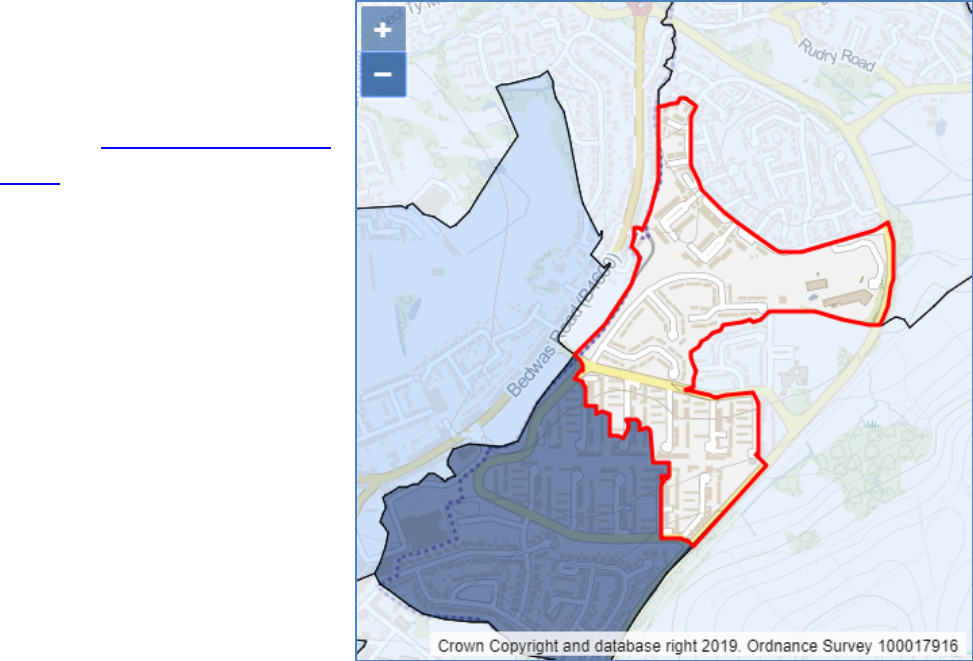
16
3. St. James 3, Caerphilly
St James 3 in Caerphilly contains
a large part of the Lansbury Park
estate. Its WIMD 2019 deprivation
profile shows that St James 3 lies
within the 10 most deprived areas
for the Income, Employment and
Health domains. It also lies within
the 10% most deprived (the top
191 areas) in terms of Education,
Community Safety and Physical
Environment. WIMD indicator data
shows that 47% of people in St
James 3 were in income
deprivation in 2016-17.
The area was previously ranked 1
(most deprived) in WIMD 2014. It
is one of the areas of “deep-
rooted” deprivation described in section 2.6, which identifies areas that have been in the top 50
most deprived consistently since WIMD 2005. St James 3 has been in the top 9 most deprived
areas since WIMD 2008 (in WIMD 2005 it was ranked 18).
Population estimates for 2017 show that 24% of the area’s population are aged under 16, higher
than the Wales average of 18%. The 2011 Census showed:
77% of housing was rented, mostly social rented which accounted for 70% of housing
(compared to 16% social rented across Wales)
slightly higher than average proportions of one person households (38% compared to 31%
for Wales) and of households with dependent children (35% compared to 28% for Wales)
34% of dwellings were flats, maisonettes or apartments (13% for Wales), as opposed to a
whole house
Census area classifications place St James 3 in the “hard-pressed communities” category
(and “challenged white communities” group), which has the highest rate of unemployment
across categories
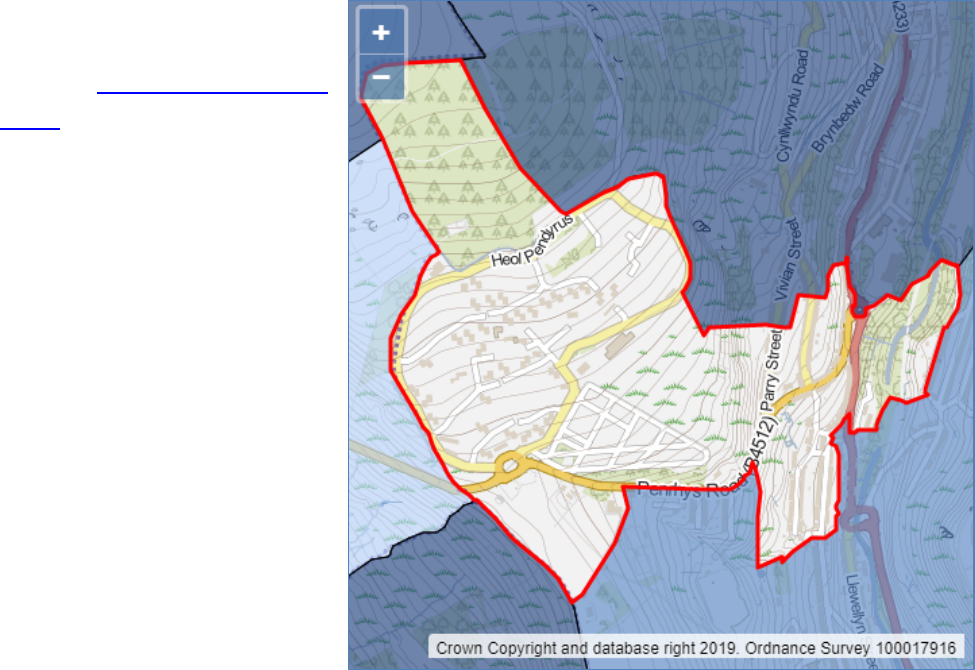
17
4. Tylorstown 1, Rhondda Cynon Taf
Tylorstown 1, is around the
Penrhys area of the Rhondda
valley. Its WIMD 2019 deprivation
profile shows that Tylorstown 1
lies within the 10 most deprived
areas for the Income and Health
domains. It also lies within the
10% most deprived (the top 191
areas) in terms of Employment,
Education and Community
Safety. WIMD indicator data
shows that 47% of people in
Tylorstown 1 were in income
deprivation in 2016-17.
The area was previously ranked
5 in WIMD 2014. It is one of the
areas of “deep-rooted”
deprivation described in section
2.6, which identifies areas that
have consistently been in the top 50 most deprived areas since WIMD 2005. Tylorstown 1 has
become relatively more deprived with each iteration of the Index since WIMD 2005.
Population estimates for 2017 show that 26% of the area’s population are aged under 16, higher
than the Wales average of 18%. The 2011 Census showed:
57% of housing was rented, mostly social rented which accounted for 42% of housing
(compared to 16% social rented across Wales)
slightly higher than average proportions of one person households (36% compared to 31%
for Wales) and of households with dependent children (34% compared to 28% for Wales)
Census area classifications place Tylorstown 1 in the “hard-pressed communities” category
(and “challenged white communities” group), which has the highest rate of unemployment
across categories

18
5. Caerau (Bridgend) 1, Bridgend
Caerau (Bridgend) 1, covers
Caerau Park and the Tudor
Estate. Its WIMD 2019
deprivation profile shows that
the area lies within the 10 most
deprived areas for the
Employment and Health
domains, it is ranked 1 (most
deprived) on Health. It also lies
within the 10% most deprived
(the top 191 areas) in terms of
Income, Education and
Community Safety. WIMD
indicator data shows that 46% of
people in Caerau 1 were in
income deprivation in 2016-17.
The area was previously ranked
6 in WIMD 2014. It is one of the
areas of “deep-rooted”
deprivation described in section
2.6, which identifies areas that have consistently been in the top 50 most deprived areas since
WIMD 2005. Caerau 1 has become relatively more deprived with each iteration of the Index since
WIMD 2005.
Population estimates for 2017 show that 26% of the area’s population are aged under 16, higher
than the Wales average of 18%. The 2011 Census showed:
49% of housing was rented, mostly social rented which accounted for 39% of housing
(compared to 16% social rented across Wales)
a slightly higher than average proportion of households with dependent children (32%
compared to 28% for Wales)
Census area classifications place Caerau (Bridgend) 1 in the “hard-pressed communities”
category (and “challenged white communities” group), which has the highest rate of
unemployment across categories

19
6. Penrhiwceiber 1, Rhondda Cynon Taf
Penrhiwceiber 1 spans the
village of Perthcelyn and part of
Penrhiwceiber. Its WIMD 2019
deprivation profile shows that
Penrhiwceiber 1 lies within the 10
most deprived areas for the
Health and Education domains. It
also lies within the 10% most
deprived (the top 191 areas) in
terms of Income and
Employment. WIMD indicator
data shows that 45% of people in
Penrhiwceiber 1 were in income
deprivation in 2016-17.
The area was previously ranked
15 in WIMD 2014. It is one of the
areas of “deep-rooted”
deprivation described in section
2.6, which identifies areas that
have consistently been in the top 50 most deprived areas since WIMD 2005. Penrhiwceiber 1 has
been ranked within the top 15 most deprived areas since WIMD 2005.
Population estimates for 2017 show that 24% of the area’s population are aged under 16, higher
than the Wales average of 18%. The 2011 Census showed:
48% of housing was rented, mostly social rented which accounted for 35% of housing
(compared to 16% social rented across Wales)
a higher than average proportion of households with dependent children (37% compared to
28% for Wales)
Census area classifications place Penrhiwceiber 1 in the “hard-pressed communities”
category (and “challenged white communities” group), which has the highest rate of
unemployment across categories

20
7. Penydarren 1, Merthyr Tydfil
Penydarren 1 is the Galon Uchaf
area of Merthyr Tydfil. Its WIMD
2019 deprivation profile shows that
Penydarren 1 lies within the 10
most deprived areas for the
Income and Education domains. It
also lies within the 10% most
deprived (the top 191 areas) in
terms of Employment, Health and
Housing. WIMD indicator data
shows that 46% of people in
Penydarren 1 were in income
deprivation in 2016-17.
The area was previously ranked 14
in WIMD 2014. It is one of the
areas of “deep-rooted” deprivation
described in section 2.6, which
identifies areas that have
consistently been in the top 50
most deprived areas since WIMD 2005. Penydarren 1 has been ranked within the top 14 most
deprived areas since WIMD 2005.
Population estimates for 2017 show that 27% of the area’s population are aged under 16, higher
than the Wales average of 18%. The 2011 Census showed:
57% of housing was rented, mostly social rented which accounted for 50% of housing
(compared to 16% social rented across Wales)
a much higher than average proportion of households with dependent children (48%
compared to 28% for Wales)
nearly all dwellings were whole houses (98%, mainly semi-detached) as opposed to flats etc,
a higher proportion than across Wales (87%)
Census area classifications place Penydarren 1 in the “hard-pressed communities” category
(and “challenged white communities” group), which has the highest rate of unemployment
across categories
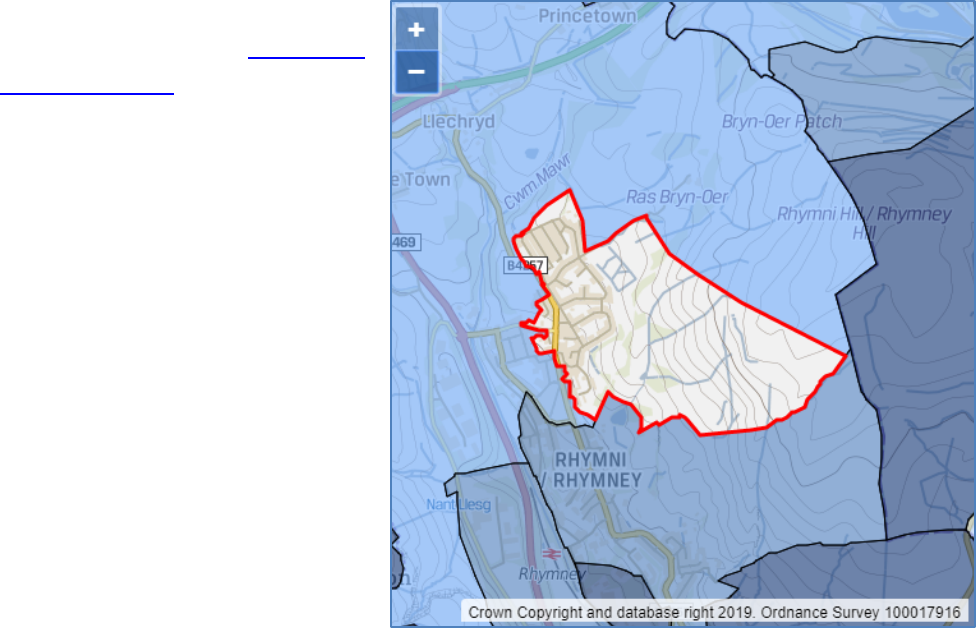
21
8. Twyn Carno 1, Caerphilly
Twyn Carno 1, is at the North end of
the town of Rhymney. Its WIMD 2019
deprivation profile shows that Twyn
Carno 1 lies within the 10 most
deprived areas for the Employment
and Education domains. It also lies
within the 10% most deprived (the top
191 areas) in terms of Income,
Health, and Community Safety.
WIMD indicator data shows that 43%
of people in Twyn Carno 1 were in
income deprivation in 2016-17.
The area was previously ranked 7 in
WIMD 2014. It is one of the areas of
“deep-rooted” deprivation described
in section 2.6, which identifies areas
that have consistently been in the top
50 most deprived areas since WIMD
2005. Twyn Carno 1 has been ranked within the top 8 most deprived areas since WIMD 2005.
Population estimates for 2017 show that 24% of the area’s population are aged under 16, higher
than the Wales average of 18%. The 2011 Census showed:
61% of housing was rented, mostly social rented which accounted for 57% of housing
(compared to 16% social rented across Wales)
a higher than average proportion of households with dependent children (38% compared to
28% for Wales)
a slightly higher proportion of dwellings were flats, maisonettes or apartments, as opposed to
a whole house (18% compared to 13% for Wales)
Census area classifications place Twyn Carno 1 in the “hard-pressed communities” category
(and “challenged white communities” group), which has the highest rate of unemployment
across categories

22
9. Queensway 1, Wrexham
Queensway 1 is an area of the Caia
Park Community in Wrexham. Its
WIMD 2019 deprivation profile shows
that Queensway 1 lies within the 10
most deprived areas for the Income,
Education and Community Safety
domains. It also lies within the 10%
most deprived (the top 191 areas) in
terms of Employment and Health.
WIMD indicator data shows that 47%
of people in Queensway 1 were in
income deprivation in 2016-17.
The area was previously ranked 3
(third most deprived) in WIMD 2014. It
is one of the areas of “deep-rooted”
deprivation described in section 2.6,
which identifies areas that have
consistently been in the top 50 most deprived areas since WIMD 2005. Queensway 1 has been
ranked within the top 9 most deprived areas since WIMD 2005.
Population estimates for 2017 show that 36% of the area’s population are aged under 16, much
higher than the Wales average of 18%. The 2011 Census showed:
86% of housing was rented, mostly social rented which accounted for 85% of housing
(compared to 16% social rented across Wales)
half of households had dependent children in them, which is much higher than average (28%
for Wales)
24% of dwellings were flats, maisonettes or apartments (13% for Wales), as opposed to a
whole house
a slightly higher than average percentage of residents were born outside the UK (6.7%
compared to 5.5% across Wales)
Census area classifications place Queensway 1 in the “hard-pressed communities” category
(and “challenged white communities” group), which has the highest rate of unemployment
across categories

23
10. Pillgwenlly 4, Newport
Pillgwenlly 4 is a densely populated
area to the south of Cardiff Road in
the Pillgwenlly Community of Newport.
Its WIMD 2019 deprivation profile
shows that the area lies within the 10
most deprived areas for the
Community Safety domain. It also lies
within the 10% most deprived (the top
191 areas) in terms of Income,
Employment, and Health domains.
WIMD indicator data shows that 44%
of people in Pillgwenlly 4 were in
income deprivation in 2016-17.
The area was also ranked 10 in WIMD
2014. However, it is not one of the
areas of “deep-rooted” deprivation
described in section 2.6, which
identifies areas that have consistently been in the top 50 most deprived areas since WIMD 2005.
This is because its rank was 65 in WIMD 2005. Since WIMD 2008, it has ranked within the top 27
most deprived areas.
Population estimates for 2017 show that 24% of the area’s population are aged under 16, higher
than the Wales average of 18%. The 2011 Census showed:
74% of housing was rented, mostly social rented which accounted for 60% of housing
(compared to 16% social rented across Wales)
a higher than average proportion of one person households (50% compared to 31% for
Wales), and slightly higher proportion where all residents were aged 65+ (24% compared to
23% across Wales)
53% of dwellings were flats, maisonettes or apartments (13% for Wales), as opposed to a
whole house
a much higher than average percentage of people from a non-white ethnic group (46.9%
compared to 4.4% across Wales)
27% of residents were born outside the UK (5.5% across Wales)
Census area classifications place Pillgwenlly 4 in the “multicultural living” category (and the
“urban cultural mix” group)

24
Areas that have moved out of the 10 most deprived since WIMD 2014
Splott 6, Cardiff
Splott 6 covers the area around East Tyndall Street and Ocean Way in south-east Cardiff. The area
now ranks at 12, but was previously ranked 4 in WIMD 2014. This change was driven by a decrease
in relative deprivation on Income and Education, amongst other domains.
Its WIMD 2019 deprivation profile shows that Splott 6 still lies within the 10% most deprived areas
for all domains except Access to Services. Although it is not one of the areas of “deep-rooted”
deprivation described in section 2.6 (those areas consistently in the 50 most deprived), this is
because it ranked just outside the 50 most deprived areas in WIMD 2005 (at 54) and WIMD 2008
(at 51).
Merthyr Vale 2, Merthyr Tydfil
Merthyr Vale 2 covers the majority of the village of Merthyr Vale on the banks of the river Taff. The
area now ranks 34, but was previously ranked 8 in WIMD 2014. This change was driven by a
decrease in relative deprivation on all five of the highest weighted domains (Income, Employment,
Health, Education and Access to Services), as well as on Community safety.
Its WIMD 2019 deprivation profile shows that Merthyr Vale 2 still lies within the 10% most deprived
areas for all domains except Access to Services and Community Safety. It is one of the areas of
“deep-rooted” deprivation described in section 2.6, which identifies areas that have consistently
been in the top 50 most deprived areas since WIMD 2005. WIMD 2014 was the only instance where
the area fell within the 10 most deprived areas.
Pen-y-waun 2, Rhondda Cynon Taf
Pen-y-waun 2 is in the Pen-y-waun community at the top of the Cynon valley. The area now ranks
15, but was previously ranked 9 in WIMD 2014. This change was driven by a decrease in relative
deprivation on Income, Employment, and Health.
Its WIMD 2019 deprivation profile shows that Pen-y-waun 2 ranks third on the Education domain,
and also still within the 10% most deprived areas for the Income, Employment, and Health domains.
It is one of the areas of “deep-rooted” deprivation described in section 2.6, which identifies areas
that have consistently been in the top 50 most deprived areas since WIMD 2005. Pen-y-waun 2 has
been ranked within the top 19 most deprived areas since WIMD 2005.
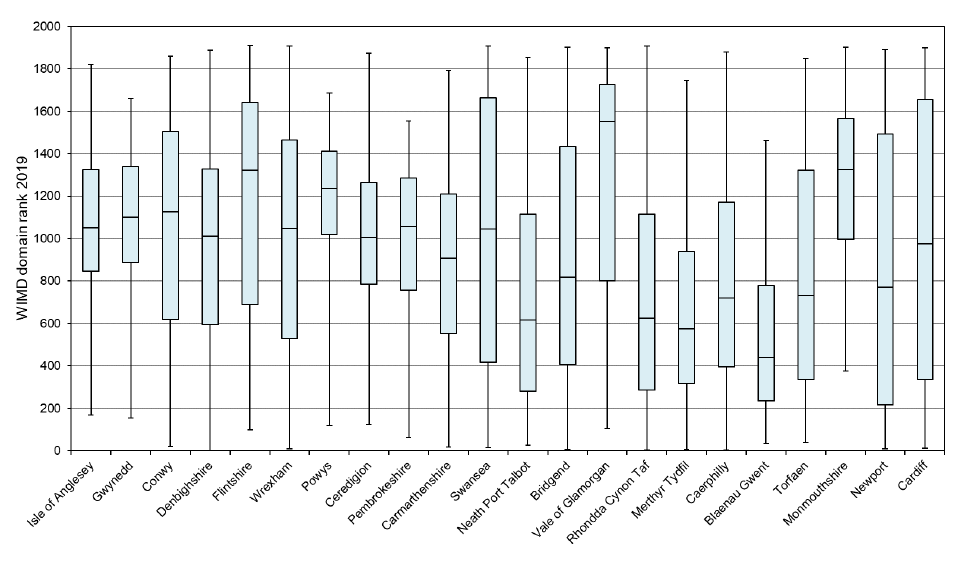
25
2.5 WIMD 2019 local authority analysis
The chart below shows the spread of WIMD 2019 ranks for each local authority in Wales. The blue
boxes contain half the total number of small areas in each local authority, centred on the median
(middle) rank for each local authority and the ‘whiskers’ show the full range of ranks. Deprivation
increases with decreasing rank (that is, towards the bottom of the plot).
Chart 1: Box plot of WIMD 2019 Overall ranks, by local authority

26
The table below shows, for the WIMD 2019 overall Index, the percentage of small areas (LSOAs) in
each local authority which were in the most deprived 10%, 20%, 30% and 50% areas in Wales.
Table 3: Concentrations of WIMD 2019 deprived areas, by local authority
One way of considering WIMD data at the local authority level is to look at the proportion of areas
within the local authority that are in the most deprived 10% (or 20% etc.) of all areas in Wales. This
method can be seen as identifying the concentration of the most deprived areas in a local authority,
rather than an average level of deprivation.
The local authority with the highest proportion of areas in the most deprived 10% in Wales in WIMD
2019 was Newport (24.2% or 23 areas).
Local authority
Number of
LSOAs in
local
authority
% LSOAs in
most-
deprived
10%
ranks 1-191
% LSOAs in
most-
deprived
20%
ranks 1-382
% LSOAs in
most-
deprived
30%
ranks 1-573
% LSOAs in
most-
deprived
50%
ranks 1-955
Isle of Anglesey 44 2.3 13.6 18.2 38.6
Gwynedd 73 2.7 5.5 8.2 34.2
Conwy 71 5.6 12.7 19.7 40.8
Denbighshire 58 12.1 15.5 22.4 46.6
Flintshire 92 3.3 10.9 19.6 31.5
Wrexham 85 7.1 11.8 28.2 41.2
Powys 79 1.3 6.3 11.4 24.1
Ceredigion 46 2.2 4.3 6.5 45.7
Pembrokeshire 71 5.6 11.3 15.5 42.3
Carmarthenshire 112 4.5 10.7 26.8 54.5
Swansea 148 11.5 23.6 31.1 45.9
Neath Port Talbot 91 15.4 33.0 45.1 69.2
Bridgend 88 6.8 20.5 39.8 55.7
Vale of Glamorgan 79 3.8 12.7 19.0 35.4
Rhondda Cynon Taf 154 17.5 28.6 45.5 71.4
Merthyr Tydfil 36 22.2 30.6 50.0 77.8
Caerphilly 110 10.0 23.6 38.2 62.7
Blaenau Gwent 47 12.8 44.7 63.8 85.1
Torfaen 60 5.0 31.7 41.7 56.7
Monmouthshire 56 0.0 1.8 5.4 19.6
Newport 95 24.2 34.7 40.0 60.0
Cardiff 214 18.2 27.6 34.6 49.1
Wales 1909 10 20 30 50

27
Monmouthshire had none of its areas in the most deprived 10% and only 19.6% (or 11 areas) in the
most deprived 50% in Wales.
Blaenau Gwent had the highest percentage of areas in the most deprived 50% in Wales (85.1% or
40 areas). The next highest was Merthyr Tydfil, with 77.8% (or 28) of its areas in the most deprived
half of Wales.
In general, the valleys and urban local authorities have higher concentrations of multiple
deprivation. This is discussed further in the WIMD 2014 article on analysing deprivation in rural
areas, due to be updated with WIMD 2019 analysis in early 2020.
2.6 Deep-Rooted Deprivation
Small areas (lower layer super output areas or LSOAs) of ‘deep-rooted’ deprivation are those that
have remained within the top 50 most deprived, roughly equal to the top 2.6% of small areas in
Wales for the last five publications of WIMD rankings (WIMD 2005, 2008, 2011, 2014 and 2019).
This means that across a period of 15 years, the small areas that fall into this category are
considered the most deprived, as they have consistently ranked in the top 50 out of 1,909 small
areas in Wales. The analysis only looks at rankings as far back as WIMD 2005 as this was the first
Index based on the current geography of LSOAs.
Since WIMD is a measure of relative deprivation, it doesn’t give an indication of the level of
deprivation in these small areas. The small areas that fall into the deep-rooted deprivation category
may have seen a decrease in levels of deprivation since WIMD 2005, but are still some of the most
deprived when compared against other small areas in Wales.
In total, there are 26 small areas that are in deep-rooted deprivation, representing roughly 1.4% of
all small areas in Wales. These are listed in the table below, ordered by their WIMD 2019 Overall
rank, and also shown in the map below.
Of the small areas listed, three have been ranked within the top 10 most deprived since WIMD 2005
(Rhyl West 2, Twyn Carno 1, Queensway 1). In addition to these three small areas, a further five
(Rhyl West 1, St. James 3, Penrhiwceiber 1, Penydarren 1, Pen-y-waun 2) make up the eight small
areas that have consistently been ranked within the top 20 most deprived.
The 26 small areas of deep-rooted deprivation are spread across ten Local Authorities; the highest
number of which are found in Swansea. These eight small areas located in Swansea account for
almost a third (31%) of those consistently ranking within the top 50 most deprived, twice as many as
the Local Authorities with the next highest number (Rhondda Cynon Taf and Caerphilly, with four
small areas each).

28
Table 4: Small areas of Deep-Rooted Deprivation
There are 12 Local Authorities with no small areas of deep-rooted deprivation (Isle of Anglesey,
Gwynedd, Conwy, Flintshire, Powys, Ceredigion, Pembrokeshire, Carmarthenshire, Vale of
Glamorgan, Torfaen, Newport, and Monmouthshire). This does not mean that there aren’t currently
any very deprived areas in these Local Authorities.
Twenty-two of the small areas identified as being in deep-rooted deprivation are classed as being in
Urban (City and Town) areas, representing 85% of the total. The remaining 4 (15%) are classed as
Rural (Town and Fringe) areas.
All but one of the 26 are located within a named Built Up Area, with the most being found in
Swansea (8) followed by Rhyl (3) and Caerphilly (2). Other Built Up Areas with one small area of
deep-rooted deprivation each are Abercynon, Aberfan, Bargoed, Cardiff, Hirwaun, Maesteg, Merthyr
Tydfil, Mountain Ash, Rhymney, Tredegar, Tylorstown and Wrexham. The area in deep-rooted
deprivation but not in a Built Up Area is Cymmer 2 in Neath Port Talbot, centred around the village
of Croeserw.
LSOA Local Authority LSOA Name WIMD 2019 Rank
W01000240 Denbighshire Rhyl West 2 1
W01000239 Denbighshire Rhyl West 1 2
W01001421 Caerphilly St. James 3 3
W01001274 Rhondda Cynon Taf Tylorstown 1 4
W01000991 Bridgend Caerau (Bridgend) 1 5
W01001209 Rhondda Cynon Taf Penrhiwceiber 1 6
W01001308 Merthyr Tydfil Penydarren 1 7
W01001428 Caerphilly Twyn Carno 1 8
W01000413 Wrexham Queensway 1 9
W01001222 Rhondda Cynon Taf Pen-y-waun 2 15
W01000863 Swansea Townhill 2 16
W01000862 Swansea Townhill 1 18
W01000237 Denbighshire Rhyl South West 2 19
W01000832 Swansea Penderry 3 22
W01000742 Swansea Castle 1 23
W01001739 Cardiff Ely 3 24
W01001339 Caerphilly Bargoed 4 29
W01000830 Swansea Penderry 1 31
W01000864 Swansea Townhill 3 32
W01001144 Rhondda Cynon Taf Abercynon 2 33
W01001303 Merthyr Tydfil Merthyr Vale 2 34
W01001479 Blaenau Gwent Tredegar Central and West 2 35
W01000817 Swansea Mynyddbach 1 37
W01000921 Neath Port Talbot Cymmer (Neath Port Talbot) 2 38
W01001345 Caerphilly Bedwas Trethomas and Machen 6 43
W01000833 Swansea Penderry 4 48
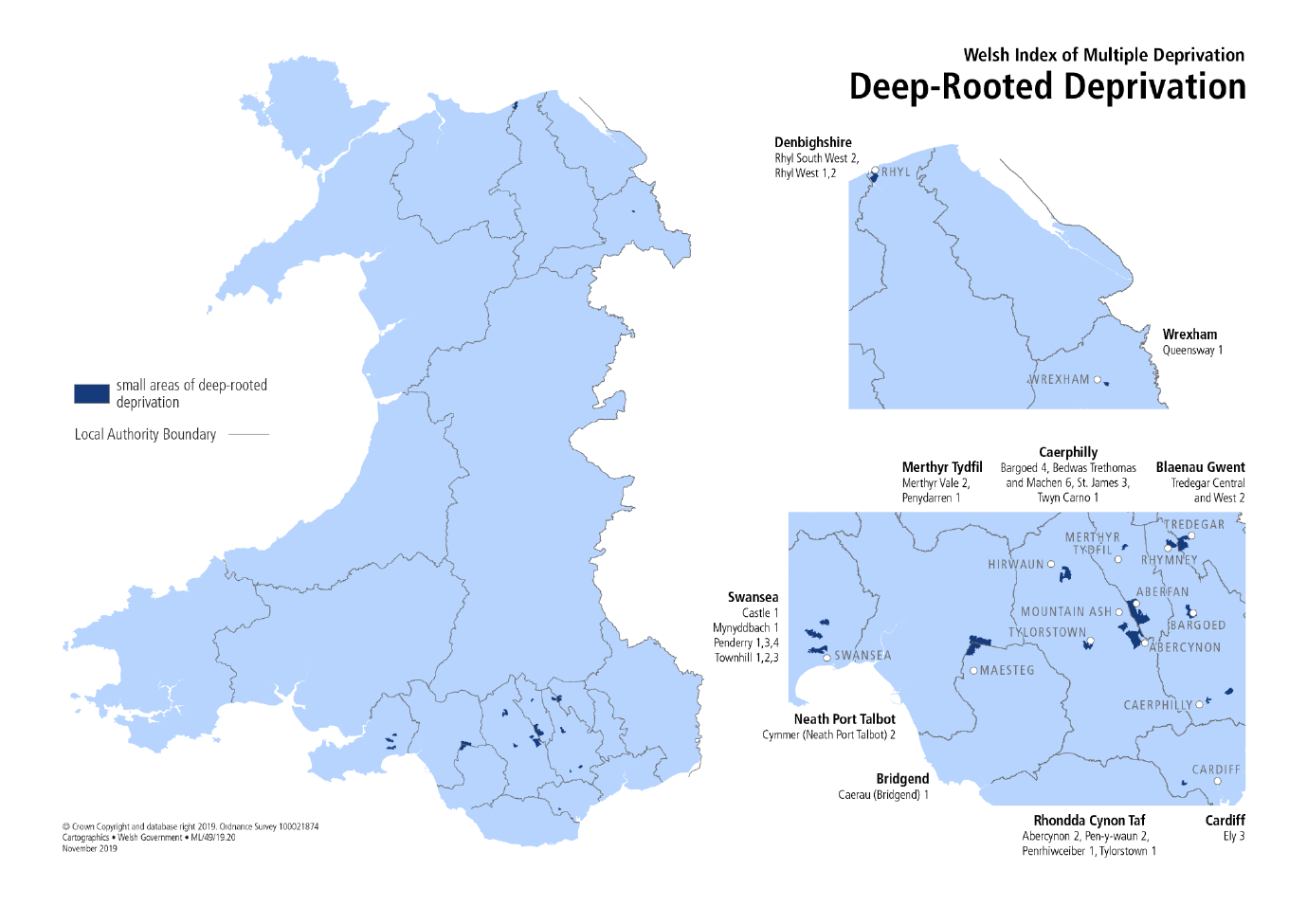
29
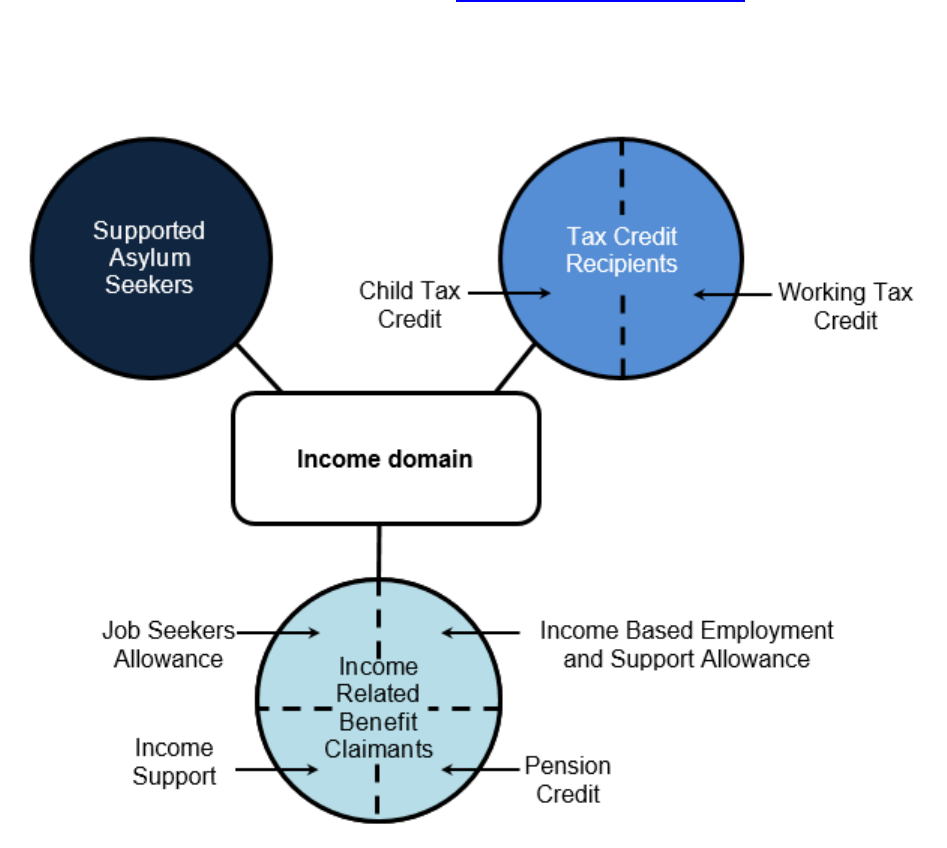
30
3. Income domain
3.1. Introduction
The purpose of this domain is to measure the proportion of people with income below a defined
level. The domain has a relative weight of 22% in the overall index. For a complete description of
the construction of the domain, please see the WIMD 2019 Technical Report.
3.2. Indicator
The domain contains a single composite indicator, income deprivation, made up of four elements:
Income related benefit claimants; this includes Income Support claimants, Jobseeker's
Allowance claimants, Pension Credit claimants, and Income Based Employment and
Support Allowance claimants; and their dependent children. Sourced from the Department
for Work and Pensions (DWP). The data are based on an average of the individuals who
were in receipt of these benefits during the financial year 2016-17. Individuals who are in
receipt of multiple benefits are only counted once within this element.
The number of children and adults within families that are in receipt of Working Tax Credits
and Child Tax Credits with an income which is less than 60% of the median income for

31
Wales (Before Housing Costs). Sourced from Her Majesty’s Revenue & Customs (HMRC),
using 2015/16 tax credits data as at 31
st
August 2015.
Supported Asylum Seekers i.e. those who were supported under Section 95 of the
Immigration and Asylum Act, and their dependent children. Sourced from the Home Office,
as at 30
th
June 2017.
People on Universal Credit and their dependent children. We exclude those who are
"working with no requirements" according to the dataset's "conditionality" marker. Sourced
from DWP, as at 2016-17.
The indicators are summed and expressed as a percentage of the residential population of the area.
The residential population estimates are sourced from the Mid-2016 Small Area Population
Estimates, published by the Office for National Statistics. We subtract the prison population as at
mid-2016 (sourced from Ministry of Justice) from the population estimates, for the four areas
containing prisons.
The resulting composite indicator is a cross-sectional snapshot of people in income deprivation,
measured by receipt of certain income-related benefits or tax credits.
The weight of the domain has reduced from 23.5% to 22% for WIMD 2019. This reflects the
increased lag in the currency of the data we are able to use (due to the impact of introducing
Universal Credit on a staggered basis), and a desire to slightly increase weights of other key
domains now with improved data (health and housing).
Full technical information on the indicator is available in the WIMD 2019 Technical Report.
3.3. Income domain key results
In the WIMD 2019 income domain, there were pockets of high income deprivation in the
South Wales valleys and large cities, and in some North Wales coastal towns. This is shown
in the map below.
All local authorities except Monmouthshire had at least some areas with over 30% of people
in income deprivation (equivalent to being in the most deprived 10% of areas).
The local authorities with the highest proportion of areas in the most deprived 10% were
Newport, Merthyr Tydfil and Cardiff, all at around 20%. Monmouthshire had no areas in the
most deprived 10%.
For the income domain, the most deprived area in Wales was Rhyl West 2, Denbighshire
(around Rhyl High Street), the same as for WIMD 2014. Eight of the 10 most deprived areas
in WIMD 2019 were also in the 10 most deprived areas in WIMD 2014.
The overall patterns of income deprivation in WIMD 2019 are similar to those for WIMD
2014.
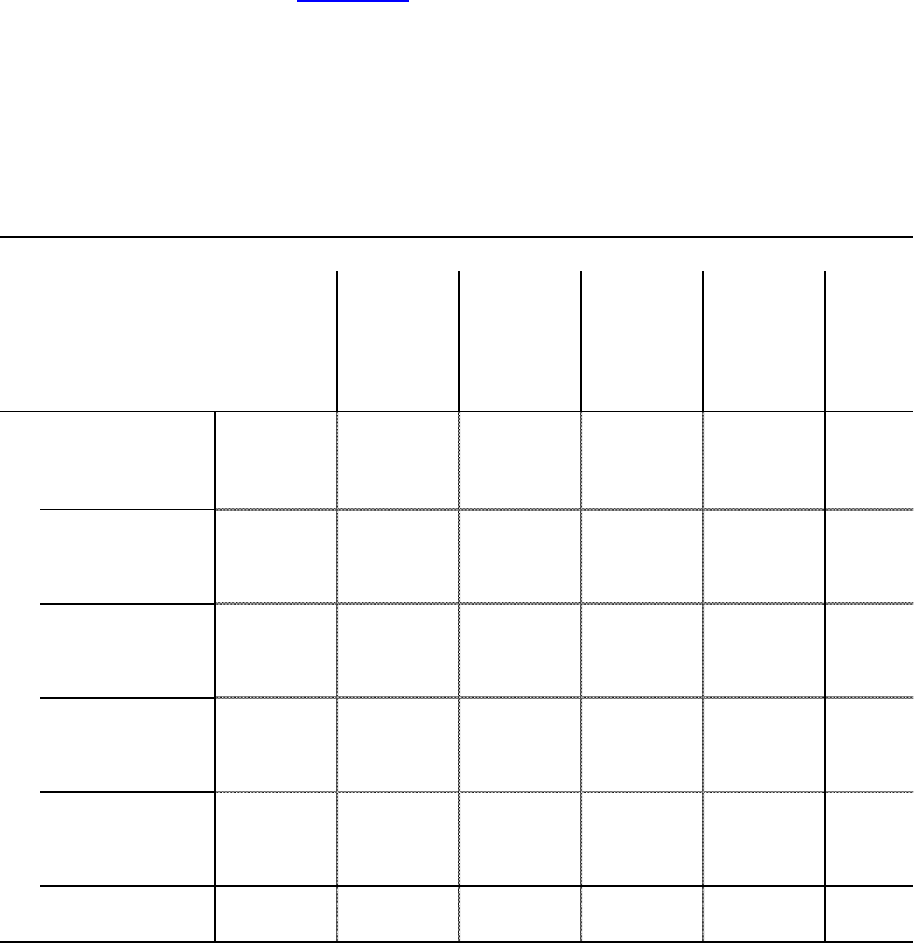
32
21.6% of people who are income deprived are in the most deprived 10% of small areas for
the income domain (the areas ranked 1-191).
Just over half of those who are income deprived are in the most deprived 28.6% of areas for
the income domain.
Overall, the rate of income deprivation for WIMD 2019 was slightly lower than for WIMD
2014 (16 compared to 17%). Although the majority of small areas saw a decrease in the rate
of income deprivation, many saw stagnation or small increases.
3.4. Income domain comparison between WIMD 2014 and WIMD 2019
The full set of domain ranks from WIMD 2019 and the underlying indicators can be downloaded
from the Welsh Government’s StatsWales web pages.
The table below shows the number of small areas (LSOAs) in each of the WIMD deprivation groups
for WIMD 2014 and WIMD 2019. The diagonal, in bold, shows the number of areas which have
remained in the same deprivation group. Above the diagonal are numbers of areas which have
moved from a more to a less deprived group. Below the diagonal are the numbers of areas which
have moved from a less to a more deprived group.
Table 5: Movement between income deprivation group between WIMD 2014 and 2019
10% most
deprived
(ranks
1-191)
10-20%
most
deprived
(ranks
192-382)
20-30%
most
deprived
(ranks
383-573)
30-50%
most
deprived
(ranks
574-955)
50% least
deprived
(ranks
956-1909)
Total
(ranks
1-1909)
10% most
deprived
(ranks 1-191)
166 23 1 1 0 191
10-20% most
deprived
(ranks 192-382)
24 135 30 2 0 191
20-30% most
deprived
(ranks 383-573)
1 33 109 48 0 191
30-50% most
deprived
(ranks 574-955)
0 0 51 281 50 382
50% least
deprived
(ranks 956-1909)
0 0 0 50 904 954
Total
(ranks 1-1909)
191 191 191 382 954 1909
Income domain 2019
Income domain 2014
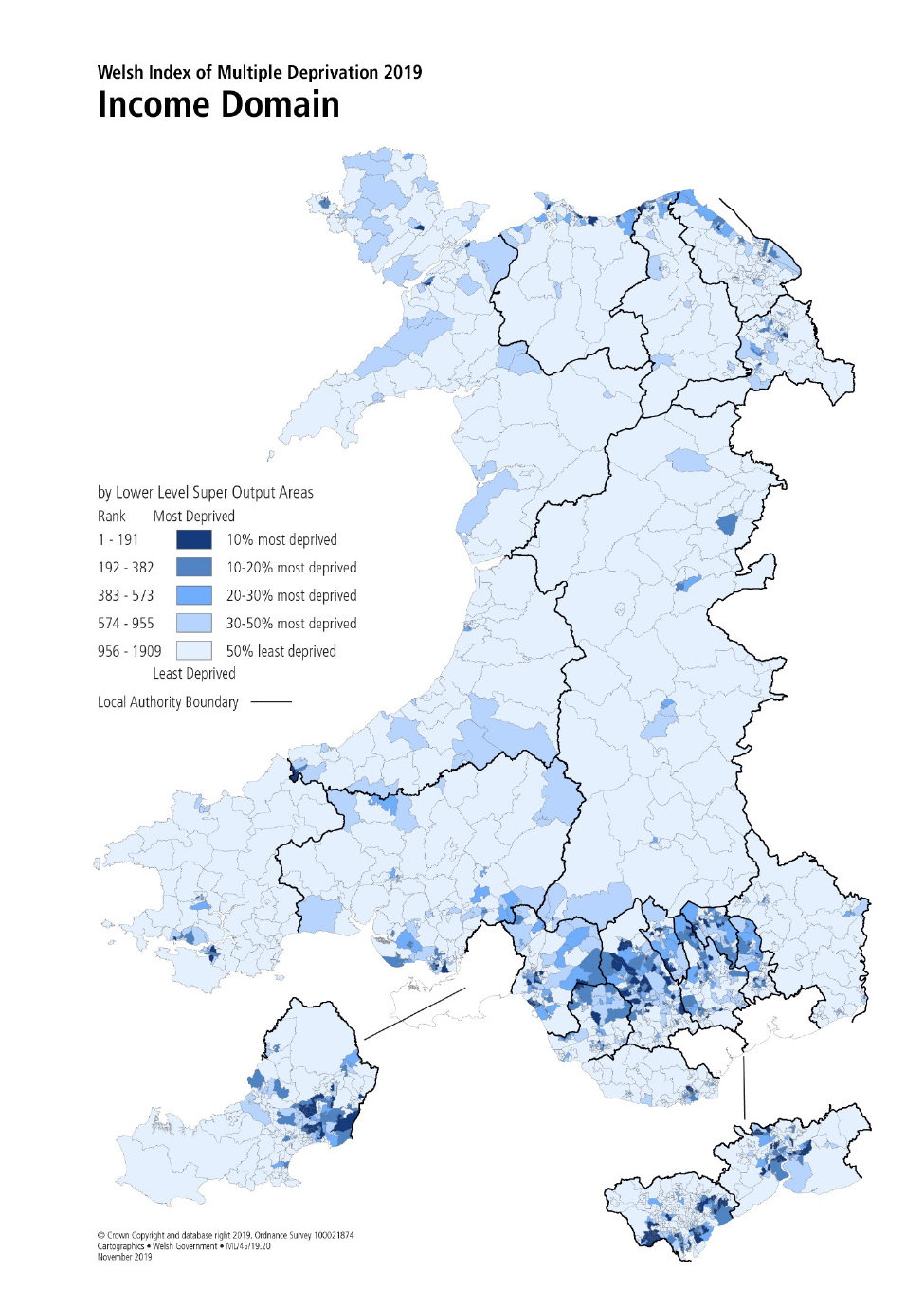
33
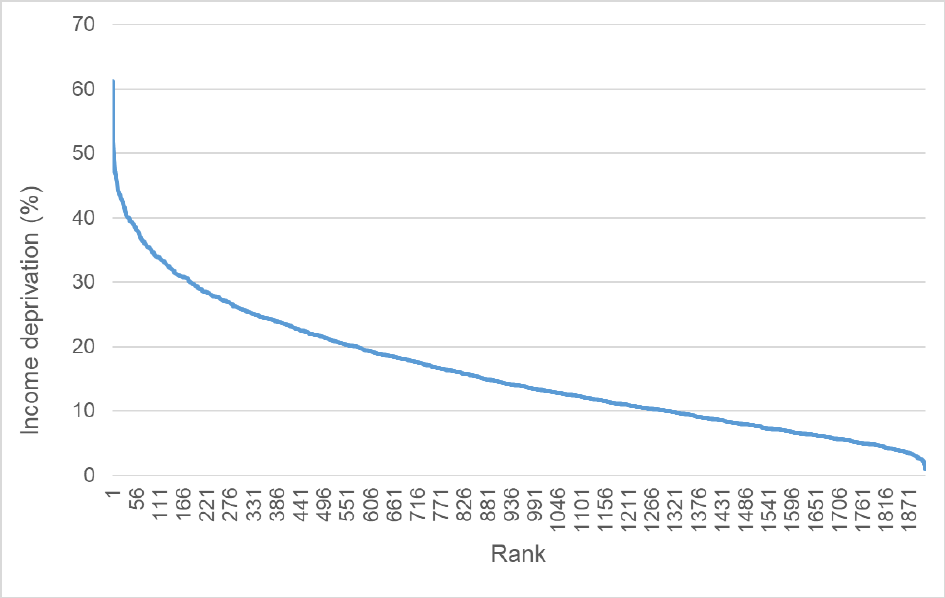
34
Relatively more deprived: One area has moved from the 20-30% most deprived group to the 10%
most deprived group in WIMD 2019. This was Colwyn 2 in Old Colwyn (Conwy), where 35% of
people were in income deprivation in the latest figures (for 2016-17).
Relatively less deprived: Four areas have become relatively less deprived by more than one
deprivation group, between WIMD 2014 and WIMD 2019. Two of these were in Llanrumney
(Cardiff), one in Barry and one in Mold.
Distribution of the Income deprived population in WIMD 2019
The chart below shows the ranks and indicator values for the income domain in WIMD 2019.
Chart 2: WIMD 2019 Income domain distribution
The plot shows that, at the most deprived end of the distribution, there is a steep increase in the
percentage of people that are income deprived. There is a wide range in the percentage of people
who are income deprived within the most deprived 10% of areas. The percentages range from 61%
for Rhyl West 2, Denbighshire (the area ranked 1), to 30% for Sandfields West 4, Port Talbot (the
area ranked 191).
The table below puts these numbers into context. The most deprived 10% of areas contains 21.6%
of people who are income deprived within Wales. Just over half of people who are income deprived
can be found in the most deprived 28.6% of areas for the income domain.
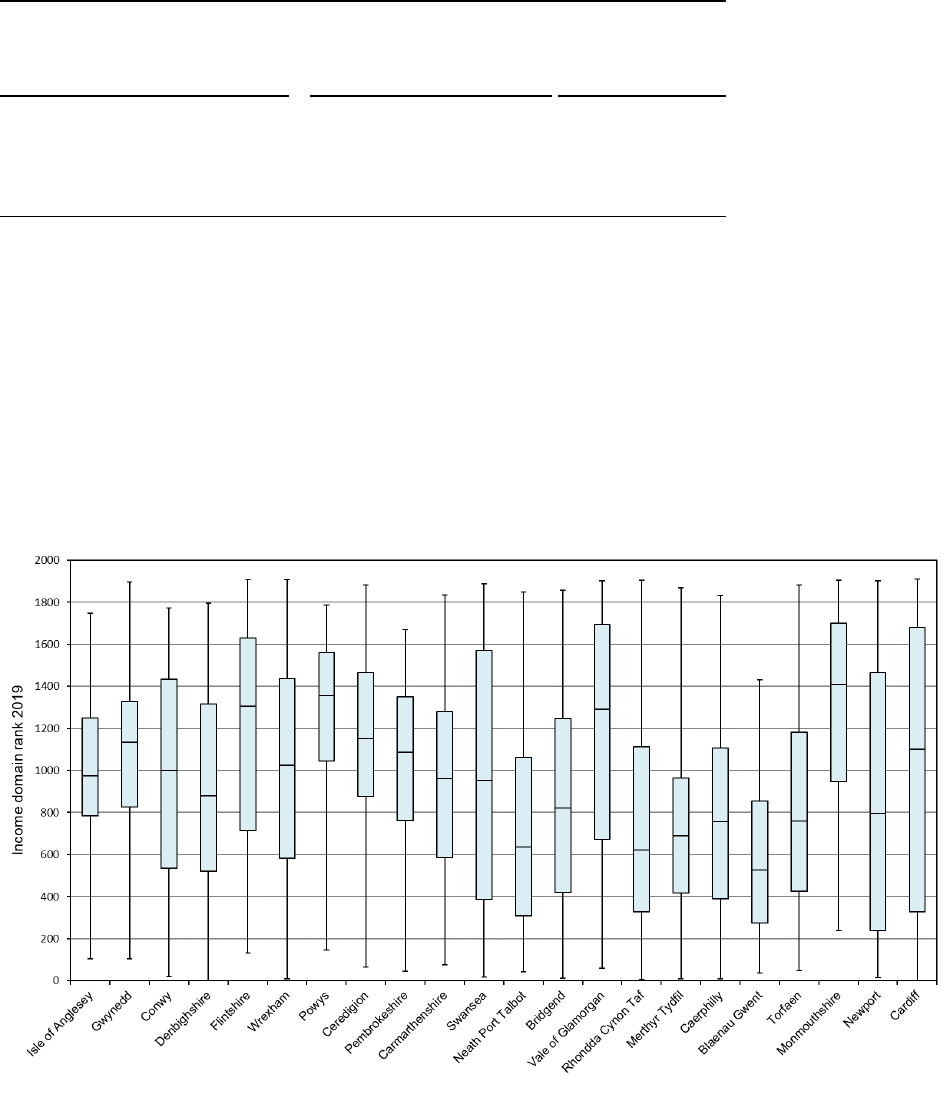
35
Table 6: Distribution of the Income deprived population, WIMD 2019
3.5. Income domain local authority analysis
The chart below shows the spread of income domain ranks for each local authority in Wales. The
blue boxes contain half the total number of areas in each local authority, centred on the median
(middle) rank for each local authority and the ‘whiskers’ show the full range of ranks. Deprivation
increases with decreasing rank (that is, towards the bottom of the plot).
Chart 3: Box plot of WIMD 2019 income domain ranks, by local authority
Percentage of all
income deprived people
Percentage of
Welsh LSOAs
Income
domain ranks
21.6 most-deprived 10% 1 - 191
38.2 most-deprived 20% 1 - 382
50.0 most-deprived 28.6% 1 - 546
6.7 least-deprived 20% 1529 - 1909

36
The table below shows, for the income domain of WIMD 2019, the percentage of small areas
(LSOAs) in each local authority which were in the most deprived 10%, 20%, 30% and 50% areas in
Wales.
Table 7: Concentrations of WIMD 2019 income deprived areas, by local authority
One way of considering WIMD data at the local authority level is to look at the proportion of areas
within the local authority that are in the most deprived 10% (or 20% etc) of all areas in Wales. This
method can be seen as identifying the concentration of the most deprived areas in a local authority,
rather than an average level of deprivation.
Local authority
Number of
LSOAs in
local
authority
% LSOAs in
most-
deprived
10%
ranks 1-191
% LSOAs in
most-
deprived
20%
ranks 1-382
% LSOAs in
most-
deprived
30%
ranks 1-573
% LSOAs in
most-
deprived
50%
ranks 1-955
Isle of Anglesey 44 4.5 15.9 18.2 45.5
Gwynedd 73 4.1 5.5 5.5 34.2
Conwy 71 7.0 11.3 26.8 47.9
Denbighshire 58 12.1 17.2 31.0 56.9
Flintshire 92 2.2 12.0 18.5 34.8
Wrexham 85 5.9 16.5 24.7 47.1
Powys 79 1.3 5.1 11.4 20.3
Ceredigion 46 2.2 4.3 8.7 32.6
Pembrokeshire 71 5.6 12.7 16.9 38.0
Carmarthenshire 112 3.6 13.4 24.1 49.1
Swansea 148 12.8 25.0 33.1 50.0
Neath Port Talbot 91 15.4 28.6 45.1 67.0
Bridgend 88 6.8 19.3 39.8 56.8
Vale of Glamorgan 79 6.3 16.5 21.5 38.0
Rhondda Cynon Taf 154 16.2 29.9 44.8 69.5
Merthyr Tydfil 36 19.4 25.0 36.1 72.2
Caerphilly 110 10.0 24.5 37.3 64.5
Blaenau Gwent 47 10.6 36.2 57.4 80.9
Torfaen 60 8.3 23.3 40.0 60.0
Monmouthshire 56 0.0 3.6 5.4 26.8
Newport 95 20.0 32.6 41.1 57.9
Cardiff 214 19.2 27.6 35.5 44.4
Wales 1909 10 20 30 50

37
The local authority with the highest proportion of areas in the most deprived 10% in Wales was
Newport (20%, or 19 areas), followed by Merthyr Tydfil and Cardiff (19.4% and 19.2% respectively).
Monmouthshire had no small areas in the most deprived 10% in Wales, followed by Powys with only
1.3% of its areas in that group. These were also the local authorities with the lowest concentrations
of areas in the most deprived half of Wales, at 20.3% for Powys and 26.8% for Monmouthshire.
Blaenau Gwent had the highest percentage of areas in the most deprived 50% in Wales, at 80.9%.
3.6. Income domain methodological changes between WIMD 2014 and WIMD 2019
The introduction of Universal Credit has had a significant impact on the measurement of the income
domain of WIMD. Universal Credit is replacing most benefits and tax credits inputting to this domain.
Once fully rolled out in all areas, those areas become directly comparable and can be ranked
against one another even if eligibility conditions and levels of benefit differ from those relating to
benefits currently within WIMD.
However, given the geographical nature and lengthy timescale of implementation, differences
between Universal Credit and legacy benefits means we may not be comparing like with like at a
given point during the rollout.
Although rollout of Universal Credit full service did not begin in Wales until April 2017, there had
previously been implementation of Universal Credit for (mainly) single, new claimants of Job-
Seekers Allowance.
To ensure consistency of data across areas, for WIMD 2019 we have used data at a point in time
before the start of rollout of Universal Credit full service in Wales, which is the 2016-17 financial
year. This does not impact much on the currency of the data compared to previous indices. Early,
straightforward cases of Universal Credit claimants have been included.
Since WIMD 2014, other changes to the welfare system may mean that eligibility thresholds and
criteria for some benefits have changed.
We will continue to work with the Department for Work and Pensions (DWP) on options for a
suitable indicator using data on Universal Credit claimants in future indices.
3.7. Income domain background information
DWP benefit statistics
The Department for Work and Pensions (DWP) publish a range of tools to allow you to download
and customise benefit statistics, including local area data and time series.
Data for England and Wales
We will continue to work with the Ministry of Housing, Communities and Local Government
(MHCLG) to publish a consistent set of income deprivation data for areas across England and
Wales during 2020.

38
Modelled Income estimates
The ONS currently produces small area model-based income estimates, modelled down to Middle-
layer Super Output Area (MSOA) level from survey estimates.
Households Below Average Income data
The Department for Work and Pensions (DWP) publish a dataset on Households Below Average
Income (HBAI). Based on that data, the Welsh Government publish analysis of poverty in Wales,
with various breakdowns. The data cannot be broken down below Wales level due to limitations in
sample size.
Experimental Statistics on Income
The Office for National Statistics have published new experimental statistics on income, which are
based on linked administrative data, as part of work on the Administrative Data Census. They bring
together data from the Pay As You Earn and benefits systems (but not yet including income from
self-employment) to derive experimental estimates of gross and net income. The outputs include
small area level data on proportion of people and households in certain income bands for the tax
year 2015/16.
We will review this data source’s quality and coverage ahead of autumn 2020, for the possible
publication of contextual information alongside our first set of WIMD 2019 indicator updates.
Employee earnings estimates
The Office for National Statistics publishes estimates of employee earnings based on data from the
Annual Survey of Hours and Earnings (ASHE). These are the most robust and comprehensive
source of earnings data for the UK, however estimates are not available below local authority level,
the data are only a subset of all sources of income and they do not cover the self-employed.
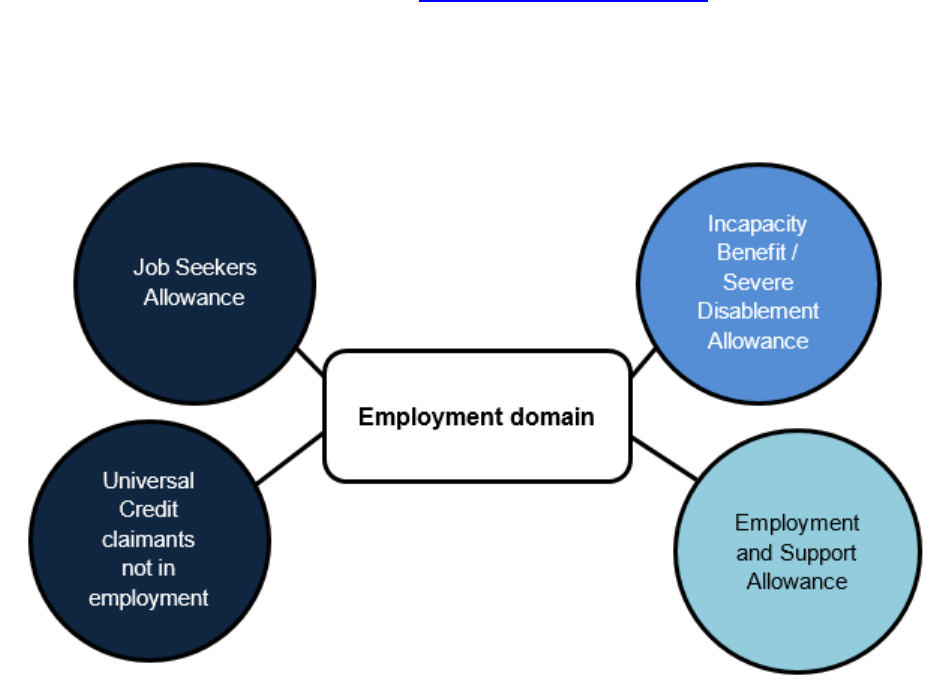
39
4. Employment domain
4.1. Introduction
The purpose of this domain is to capture lack of employment. This covers involuntary exclusion of
the working-age population from work, including those who cannot work due to ill-health or who are
unemployed but are actively seeking work.
The domain has a relative weight of 22% in the overall Index. For a complete description of the
construction of the domain, please see the WIMD 2019 Technical Report.
4.2. Indicator
The employment domain contains one single composite indicator, employment related benefits,
made up of four elements:
• Jobseeker's Allowance (JSA) claimants
• Employment and Support Allowance (ESA) claimants
• Incapacity Benefit (and Severe Disablement Allowance) claimants
• Universal Credit (UC) claimants who are not in employment
The data are based on an average of the individuals who were in receipt of these benefits during
the financial year 2016-17, sourced from the Department for Work and Pensions. Individuals who
claim multiple benefits are only counted once. Each element of this indicator is summed together,
and then divided by the working-age (aged 16-64) population of the area, to form a single indicator.

40
The population estimates are sourced from the Mid-2016 Small Area Population Estimates,
published by the Office for National Statistics. We subtract the prison population as at mid-2016
(sourced from Ministry of Justice) from the population estimates, for the four areas containing
prisons.
The resulting composite indicator is a cross-sectional snapshot of people in employment
deprivation, measured by receipt of unemployment-related benefits.
The weight of the domain has reduced from 23.5 to 22% for WIMD 2019. This reflects the increased
lag in the currency of the data we are able to use (due to the impact of introducing Universal Credit
on a staggered basis), and a desire to slightly increase weights of other key domains now with
improved data (health and housing).
Full technical information on the indicator is available in the WIMD 2019 Technical Report.
4.3. Employment domain key results
In the WIMD 2019 employment domain, there were pockets of high employment deprivation
in the South Wales valleys and large cities, and in some North Wales coastal towns. This is
shown in the map below.
All local authorities except Monmouthshire had at least some areas with over 19% of people
in employment deprivation (equivalent to being in the most deprived 10% of areas).The local
authority with the highest proportion of areas in the most deprived 10% in Wales for the
employment domain was Blaenau Gwent (23.4%), followed by Merthyr Tydfil (22.2%).
Monmouthshire had no areas in the most deprived 10%.
For the employment domain, the most deprived area in Wales was Rhyl West 2,
Denbighshire (around Rhyl High Street), the same as for WIMD 2014. Seven of the 10 most
deprived areas in WIMD 2019 were also in the 10 most deprived areas in WIMD 2014.
The overall patterns of employment deprivation in WIMD 2019 are similar to those for WIMD
2014.
20.8% of people who are employment deprived are in the most deprived 10% of small areas
for the employment domain (the areas ranked 1-191).
Just over half of those who are employment deprived are in the most deprived 29.6% of
areas for the employment domain.
Overall, the rate of employment deprivation for WIMD 2019 was lower than for WIMD 2014
(10% compared to 13%). Although the vast majority of small areas saw a decrease in the
rate of employment deprivation, some saw stagnation or small increases.

41
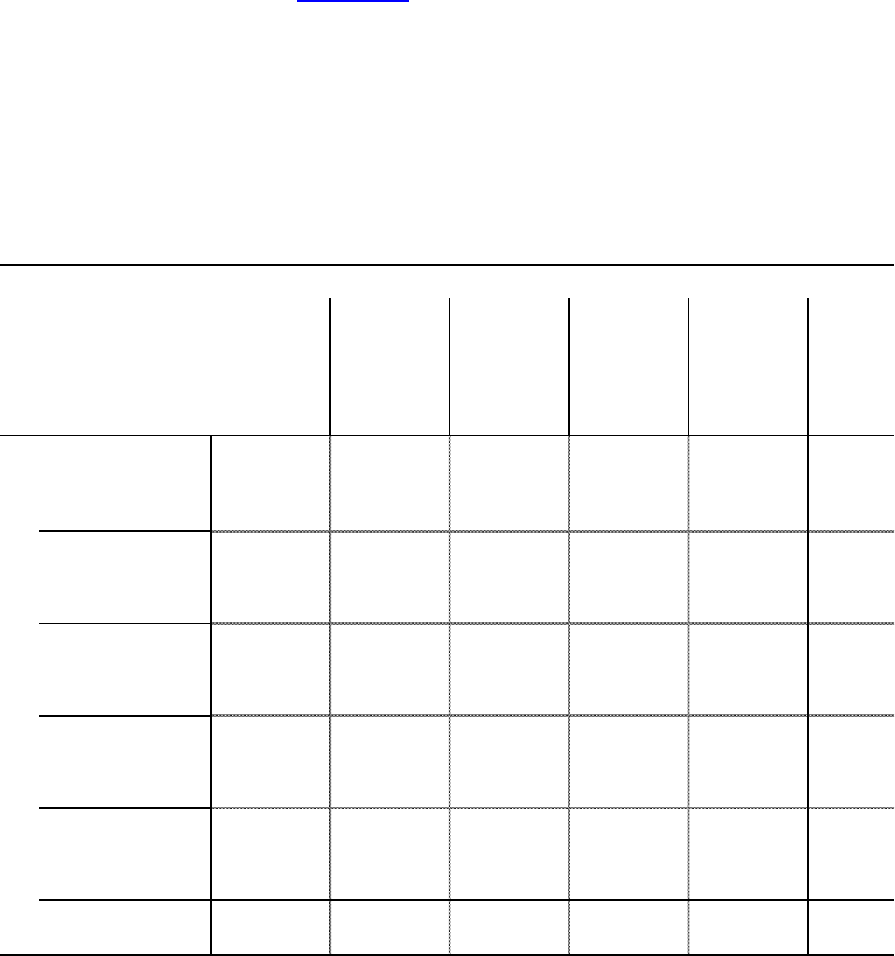
42
4.4. Employment domain comparison between WIMD 2014 and WIMD 2019
The full set of domain ranks from WIMD 2019 and the underlying indicators can be downloaded
from the Welsh Government’s StatsWales web pages.
The table below shows the number of small areas (LSOAs) in each of the WIMD deprivation groups
for WIMD 2014 and WIMD 2019. The diagonal, in bold, shows the number of areas which have
remained in the same deprivation group. Above the diagonal are numbers of areas which have
moved to a less deprived group. Below the diagonal are the numbers of areas which have moved to
a more deprived group.
Table 8: Movement between employment deprivation group between WIMD 2014 and
2019
Relatively more deprived: Six areas have become relatively more deprived in WIMD 2019 compared
to WIMD 2014, by more than one deprivation group. Three of these areas (in Port Talbot, Cardigan
and Milford Haven) moved from the 20-30% most deprived group into the 10% most deprived, and
the other 3 areas (in Colwyn Bay, Caerleon and Swansea) moved from the 30-50% most deprived
group into the 10-20% most deprived.
Relatively less deprived: Five areas have become relatively less deprived between WIMD 2014 and
WIMD 2019, by more than one deprivation group. Two of these areas were in Cardiff, two in
Treharris, and one in Bridgend, with all moving from the 10-20% most deprived group into the 30-
50% most deprived grouping.
10% most
deprived
(ranks
1-191)
10-20%
most
deprived
(ranks
192-382)
20-30%
most
deprived
(ranks
383-573)
30-50%
most
deprived
(ranks
574-955)
50% least
deprived
(ranks
956-1909)
Total
(ranks
1-1909)
10% most
deprived
(ranks 1-191)
165 26 0 0 0 191
10-20% most
deprived
(ranks 192-382)
23 124 39 5 0 191
20-30% most
deprived
(ranks 383-573)
3 38 109 41 0 191
30-50% most
deprived
(ranks 574-955)
0 3 43 282 54 382
50% least
deprived
(ranks 956-1909)
0 0 0 54 900 954
Total
(ranks 1-1909)
191 191 191 382 954 1909
Employment domain 2019
Employment domain 2014
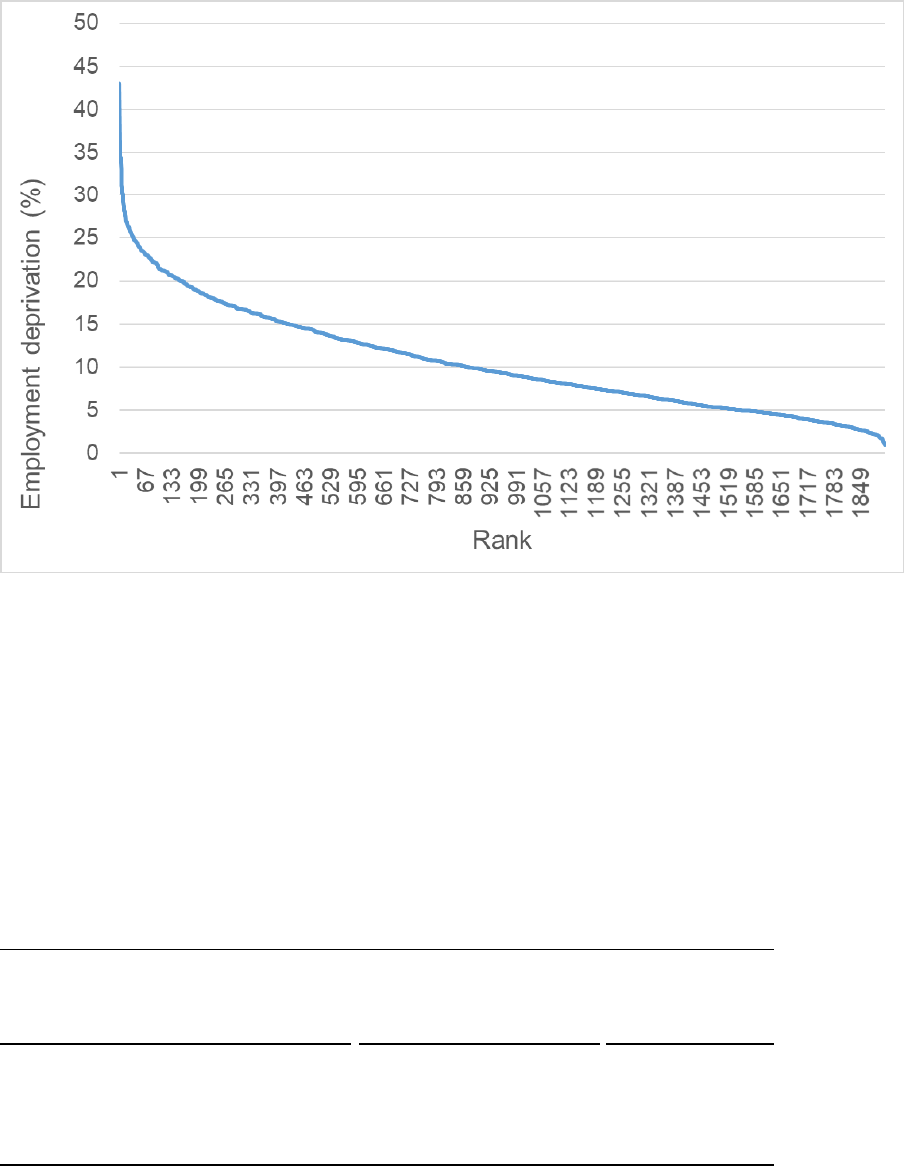
43
Distribution of the Employment deprived population in WIMD 2019
The chart below shows the ranks and indicator values for the employment domain in WIMD 2019.
Chart 4: WIMD 2019 Employment domain distribution
The plot shows that, at the most deprived end of the distribution, there is a steep increase in the
percentage of working-age people that are employment deprived. There is a wide range in the rate
of employment deprivation within the most deprived 10% of areas. The percentages range from
43% for Rhyl West 2, Denbighshire (the area ranked 1), to 19% for Gurnos 3, Merthyr Tydfil (the
area ranked 191).
The table below puts these numbers into context. The most deprived 10% of areas contains 20.8%
of people that are employment deprived within Wales. Just over half of the people who are
employment deprived can be found in the most deprived 29.6% of areas for the employment
domain.
Table 9: Distribution of the Employment deprived population, WIMD 2019
Percentage of all employment
deprived people
Percentage of
Welsh LSOAs
Employment
domain ranks
20.8 most-deprived 10% 1 - 191
36.7 most-deprived 20% 1 - 382
50.0 most-deprived 29.6% 1 - 565
7.5 least-deprived 20% 1529 - 1909
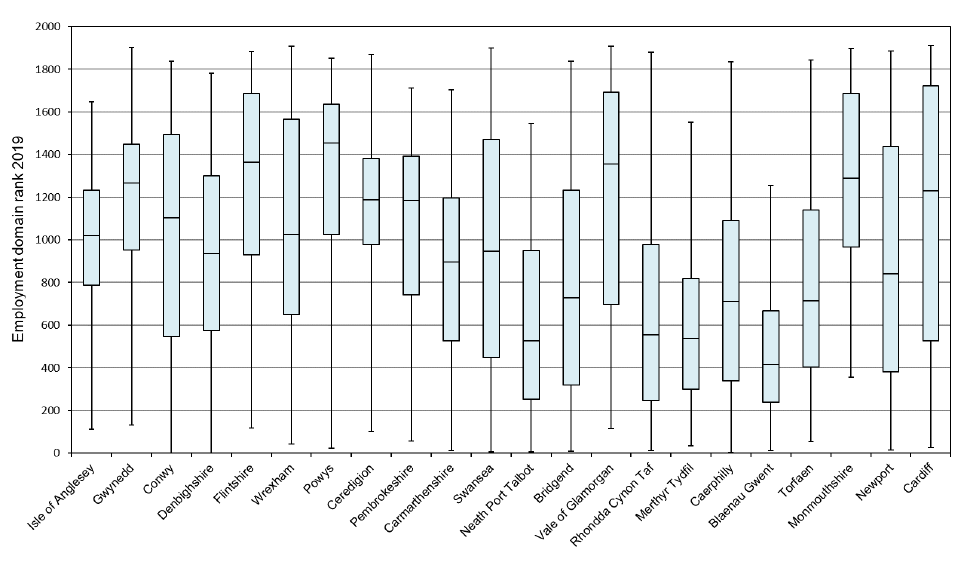
44
4.5. Employment domain local authority analysis
The chart below shows the spread of employment domain ranks for each local authority in Wales.
The blue boxes contain half the total number of areas in each local authority, centred on the median
(middle) rank for each local authority and the ‘whiskers’ show the full range of ranks. Deprivation
increases with decreasing rank (that is, towards the bottom of the plot).
Chart 5: Box plot of WIMD 2019 Employment domain ranks, by local authority

45
The table below shows, for the employment domain of WIMD 2019, the percentage of small areas
(LSOAs) in each local authority which were in the most deprived 10% of Wales, 20%, 30% and 50%
areas in Wales.
Table 10: Concentrations of WIMD 2019 employment deprived areas, by local
authority
One way of considering WIMD data at the local authority level is to look at the proportion of areas
within the local authority that are in the most deprived 10% (or 20% etc.) of all areas in Wales. This
method can be seen as identifying the concentration of the most deprived areas in a local authority,
rather than an average level of deprivation.
Local authority
Number of
LSOAs in
local
authority
% LSOAs in
most-
deprived
10%
ranks 1-191
% LSOAs in
most-
deprived
20%
ranks 1-382
% LSOAs in
most-
deprived
30%
ranks 1-573
% LSOAs in
most-
deprived
50%
ranks 1-955
Isle of Anglesey 44 4.5 13.6 18.2 43.2
Gwynedd 73 2.7 4.1 4.1 26.0
Conwy 71 7.0 14.1 28.2 43.7
Denbighshire 58 12.1 19.0 25.9 51.7
Flintshire 92 1.1 7.6 15.2 27.2
Wrexham 85 3.5 9.4 18.8 44.7
Powys 79 2.5 3.8 11.4 22.8
Ceredigion 46 4.3 6.5 6.5 23.9
Pembrokeshire 71 7.0 11.3 14.1 38.0
Carmarthenshire 112 6.3 16.1 27.7 56.3
Swansea 148 14.9 23.0 30.4 52.0
Neath Port Talbot 91 18.7 36.3 53.8 74.7
Bridgend 88 6.8 29.5 39.8 61.4
Vale of Glamorgan 79 5.1 13.9 17.7 35.4
Rhondda Cynon Taf 154 19.5 36.4 50.6 73.4
Merthyr Tydfil 36 22.2 33.3 55.6 88.9
Caerphilly 110 11.8 29.1 42.7 68.2
Blaenau Gwent 47 23.4 48.9 72.3 91.5
Torfaen 60 5.0 21.7 43.3 58.3
Monmouthshire 56 0.0 1.8 8.9 23.2
Newport 95 11.6 25.3 34.7 53.7
Cardiff 214 14.0 18.7 27.1 39.7
Wales 1909 10 20 30 50

46
The local authority with the highest proportion of areas in the most deprived 10% in Wales was
Blaenau Gwent (23.4%, or 11 areas). Merthyr Tydfil has the second highest proportion of areas in
the most deprived 10% (22.2%, or 8 areas).
Monmouthshire had no areas in the most deprived 10%. Flintshire had only 1.1% of its areas in the
10% most deprived group. Only 22.8% of the areas in Powys were in the most deprived 50% in
Wales, closely followed by Ceredigion with 23.9%.
Blaenau Gwent had the highest percentage of areas in the most deprived 50% in Wales (91.5%).
The next highest was Merthyr Tydfil, with 88.9% of its areas in the most deprived half of Wales.
4.6. Employment domain methodological changes between WIMD 2014 and WIMD
2019
The introduction of Universal Credit has had a significant impact on the measurement of the
employment domain of WIMD. Universal Credit is replacing most benefits and tax credits inputting
to this domain. Once fully rolled out in all areas, those areas become directly comparable and can
be ranked against one another even if eligibility conditions and levels of benefit differ from those
relating to benefits currently within WIMD.
However, given the geographical nature and lengthy timescale of implementation, differences
between Universal Credit and legacy benefits means we may not be comparing like with like at a
given point during the rollout.
Although rollout of Universal Credit full service did not begin in Wales until April 2017, there had
previously been implementation of Universal Credit for (mainly) single, new claimants of Job-
Seekers Allowance.
To ensure consistency of data across areas, for WIMD 2019 we have used data at a point in time
before the start of rollout of Universal Credit full service in Wales, which is the 2016-17 financial
year. This does not impact much on the currency of the data compared to previous indices. Early,
straightforward cases of Universal Credit claimants have been included.
Since WIMD 2014, other changes to the welfare system may mean that eligibility thresholds and
criteria for some benefits have changed.
We will continue to work with the Department for Work and Pensions (DWP) on options for a
suitable indicator using data on Universal Credit claimants in future indices.
4.7. Employment domain background information
DWP benefit statistics
The Department for Work and Pensions (DWP) publish a range of tools to allow you to download
and customise benefit statistics, including local area data and time series.

47
Data for England and Wales
We will continue to work with the Ministry of Housing, Communities and Local Government
(MHCLG) to publish a consistent set of employment deprivation data for areas across England and
Wales during 2020.
Workless households
Workless household are those where none of the adults aged 16 to 64 are in employment. The data
are sourced from the Annual Population Survey (APS) and Labour Force Survey (LFS). These data
enable household analyses to be carried out at a local authority level, including details of people in
workless households, children in workless households, lone parents and housing tenure. Key
results for Wales can be found in the Welsh Government’s Labour Market Statistics for
Households analysis.
Labour Market research outputs
The ONS have produced new labour market research outputs as part of work on the Administrative
Data Census. The aim is to produce small area, multivariate statistics, and they have published data
on labour market status by local authority for tax year 2011/12.
Labour market status estimates
The Welsh Government publishes estimates of employment, unemployment and economic inactivity
based on data from the Annual Population Survey (APS). These estimates are updated on a
quarterly basis but are available down to local authority level only.
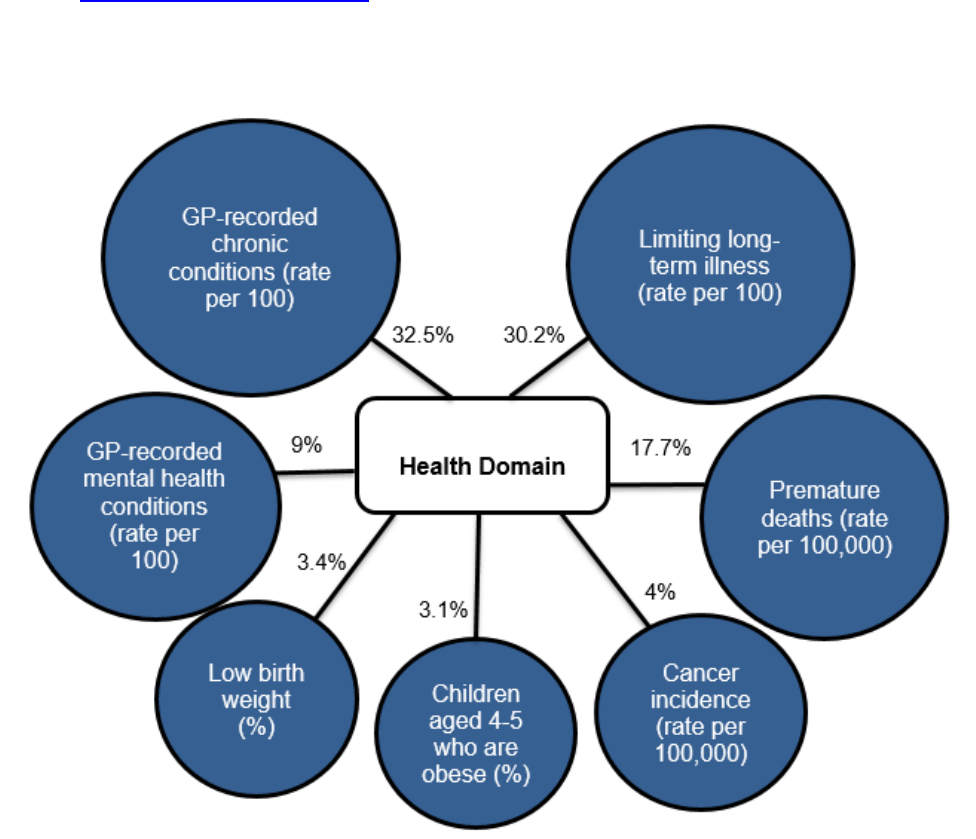
48
5. Health domain
5.1. Introduction
The purpose of this domain is to measure lack of good health. This domain does not contain any
sub-domains. Some indicators in this domain are age-sex standardised to account for population
differences across small areas.
The domain has a relative weight of 15% in the overall index. This has increased from 14% in the
2014 index, due to the addition of three new indicators; diagnosed chronic conditions, diagnosed
mental health conditions, and children aged 4-5 who are obese. The 2019 health domain indicators
are weighted as shown below. For a complete description of the construction of the domain, please
see the WIMD 2019 Technical Report.
5.2. Health Domain Indicators
The domain contains seven indicators, weighted as shown below:
49
The indicator on GP-recorded chronic conditions measures the number of people per 100
with a current diagnosis of one or more of the conditions listed below:
o Coronary Heart Disease
o Chronic Obstructive Pulmonary Disease
o Stroke and Transient Ischaemic Attack
o Peripheral Arterial Disease
o Chronic Kidney Disease
o Diabetes Mellitus (type 1 all ages, type 2/other for aged 17 plus)
o Epilepsy
The indicator on GP-recorded mental health conditions measures the number of people per
100 with a current diagnosis of one or more of the conditions listed below:
o Depression
o Low mood (patients with record of low mood and an active repeat prescription for an
anti-depressant)
o Anxiety disorder (including panic disorders)
o Dementia
o Severe mental illnesses (schizophrenia, bipolar affective disorder and other
psychoses)
The numerator for the two new indicators on diagnosed chronic and mental health conditions was
based on counts of diagnoses from the above defined lists of disease registers and sub-indicators
obtained from GP practices in Wales. These counts were de-duplicated so that patients with more
than one condition were not counted twice. Patient level data was aggregated to small areas
(LSOAs), according to patient addresses, so that prevalence is based on where people live rather
than where they are registered with a GP.
The indicator on Limiting long-term illness measures the number of people with a limiting
long-term illness per 100 people, and is based on 2011 Census data (Office for National
Statistics).
The indicator on premature deaths measures the number of deaths of those under the age
of 75 per 100,000 people and is based on the 2009-2018 average (Office for National
Statistics).
The indicator on Cancer Incidence measures the number of incidences of cancer per
100,000 people, and was based on the 2007-2016 average (Welsh Cancer Intelligence and
Surveillance Unit, Velindre NHS Trust).

50
All the above indicators are age-sex standardised to adjust for the expected prevalence of disease
within the underlying population. This allows the Index to identify areas where health deprivations
exists beyond the effect of age and sex.
The indicator on Low Birth Weight measures the percentage of live single births less than
2.5 kg (5.5lb), and was based on the 2009-2018 average (Office for National Statistics).
The indicator on children who are obese measures the proportion of reception aged children
(those aged 4 and 5) who are obese and is based on the 2012-13 to 2017-18 average, child
measurement programme.
For a full explanation of how these indicators are calculated and combined together, please see the
WIMD 2019 Technical Report.
5.3. Health domain key results
In the WIMD 2019 health domain, there were pockets of high deprivation in the South Wales
valleys and large cities, and in some North Wales coastal and border towns. This is shown in
the map below.
The local authorities with the highest concentration of areas in the most deprived 10% were
Merthyr Tydfil, followed by Blaenau Gwent. Isle of Anglesey, Ceredigion, and
Monmouthshire had no small areas in the most deprived 10%.
For the health domain, the most deprived small area in Wales was Caerau 1 (which covers
Caerau Park and the Tudor Estate) in Bridgend (ranked 6 in the WIMD 2014 health domain),
followed by Rhyl West 2 in Denbighshire (ranked 1 in the WIMD 2014 health domain).
The overall patterns of health deprivation in WIMD 2019 are fairly similar to those for WIMD
2014, with only 75 areas moving by more than one health deprivation group in either
direction.

51
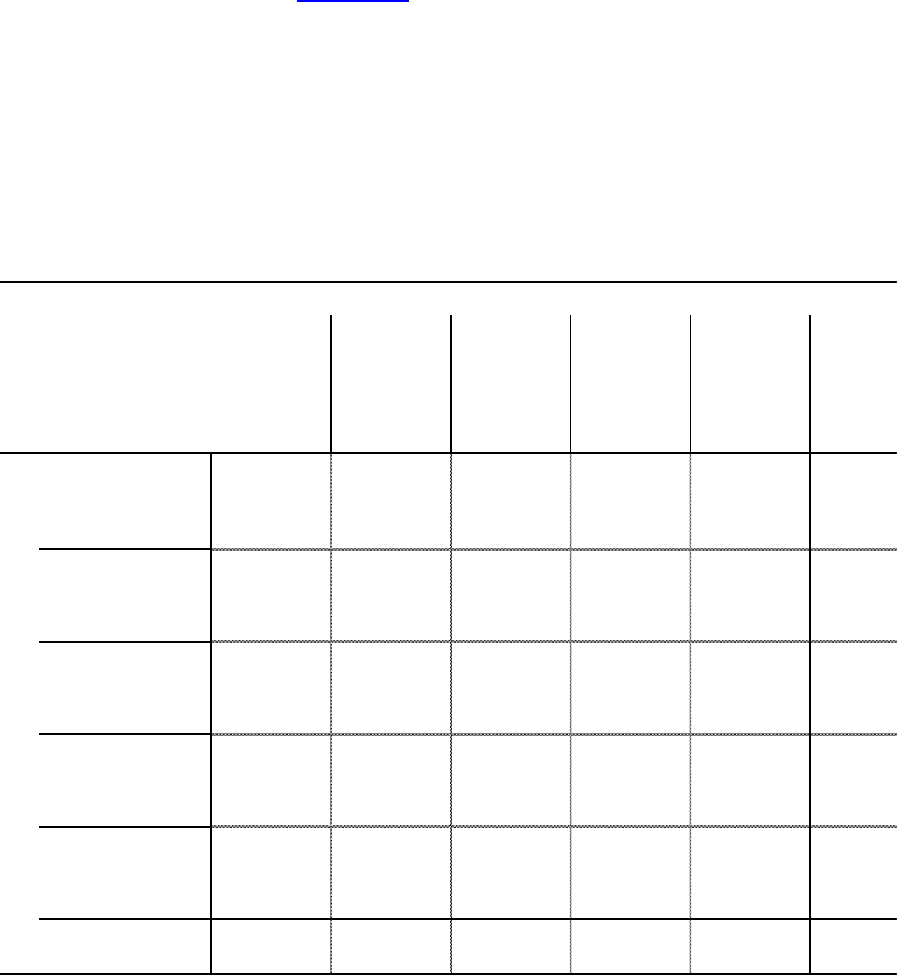
52
5.4. Health domain comparison between WIMD 2014 and WIMD 2019
The full set of domain ranks from WIMD 2019 and the underlying indicators can be downloaded
from the Welsh Government’s StatsWales web pages.
The table below shows the number of small areas (LSOAs) in each of the WIMD deprivation groups
for WIMD 2014 and WIMD 2019. The diagonal, in bold, shows the number of areas which have
remained in the same deprivation group. Above the diagonal are numbers of areas which have
moved from a more to a less deprived group. Below the diagonal are the numbers of areas which
have moved from a less to a more deprived group.
Table 11: Movement between health deprivation group between WIMD 2014 and 2019
Relatively more deprived: Seven areas have moved from outside the 20% most deprived group into
the 10% most deprived group for this domain in WIMD 2019. These areas lie in six different local
authorities, with two in Cardiff. The only area to move from outside the 30% most deprived into the
10% most deprived group was Flint Coleshill 2 in Flintshire.
Relatively less deprived: Twelve areas have moved from the 10% most deprived group to outside
the 20% most deprived group for this domain in WIMD 2019. Nine of these were either in Rhondda
Cynon Taf (5 of them) or Caerphilly (4 of them).
10% most
deprived
(ranks
1-191)
10-20%
most
deprived
(ranks
192-382)
20-30%
most
deprived
(ranks
383-573)
30-50%
most
deprived
(ranks
574-955)
50% least
deprived
(ranks
956-1909)
Total
(ranks
1-1909)
10% most
deprived
(ranks 1-191)
143 36 10 1 1 191
10-20% most
deprived
(ranks 192-382)
41 84 50 16 0 191
20-30% most
deprived
(ranks 383-573)
6 46 71 60 8 191
30-50% most
deprived
(ranks 574-955)
1 22 53 222 84 382
50% least
deprived
(ranks 956-1909)
0 3 7 83 861 954
Total
(ranks 1-1909)
191 191 191 382 954 1909
Health domain 2019
Health domain 2014
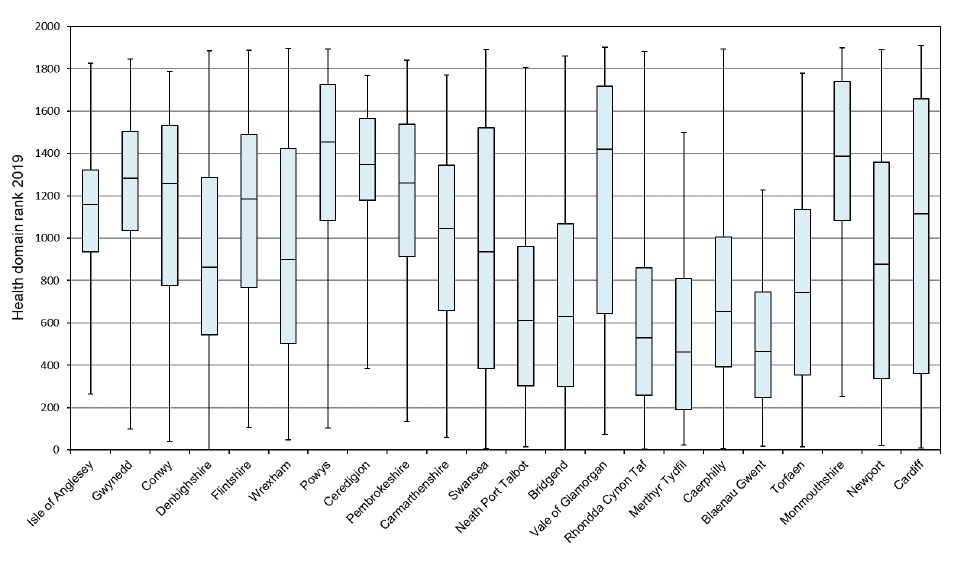
53
5.5. Health domain local authority analysis
The chart below shows the spread of health domain ranks for each local authority in Wales. The
blue boxes contain half the total number of areas in each local authority, centred on the median
(middle) rank for each local authority and the ‘whiskers’ show the full range of ranks. Deprivation
increases with decreasing rank (that is, towards the bottom of the plot).
Chart 6: Box plot of WIMD 2019 health domain ranks, by local authority

54
The table below shows, for the health domain of WIMD 2019, the percentage of small areas
(LSOAs) in each local authority which were in the most deprived 10%, 20%, 30% and 50% areas in
Wales.
Table 12: Concentrations of WIMD 2019 health deprived areas, by local authority
One way of considering WIMD data at the local authority level is to look at the proportion of areas
within the local authority that are in the most deprived 10% (or 20% etc) of all areas in Wales. This
method can be seen as identifying the concentration of the most deprived areas in a local authority,
rather than an average level of deprivation.
Local authority
Number of
LSOAs in
local
authority
% LSOAs in
most-
deprived
10%
ranks 1-191
% LSOAs in
most-
deprived
20%
ranks 1-382
% LSOAs in
most-
deprived
30%
ranks 1-573
% LSOAs in
most-
deprived
50%
ranks 1-955
Isle of Anglesey 44 0.0 6.8 11.4 27.3
Gwynedd 73 1.4 4.1 6.8 20.5
Conwy 71 4.2 11.3 16.9 36.6
Denbighshire 58 17.2 17.2 29.3 53.4
Flintshire 92 5.4 12.0 18.5 34.8
Wrexham 85 7.1 17.6 28.2 52.9
Powys 79 1.3 3.8 8.9 21.5
Ceredigion 46 0.0 0.0 4.3 8.7
Pembrokeshire 71 1.4 5.6 12.7 32.4
Carmarthenshire 112 3.6 9.8 21.4 48.2
Swansea 148 12.2 25.0 30.4 52.0
Neath Port Talbot 91 16.5 33.0 46.2 74.7
Bridgend 88 15.9 33.0 47.7 63.6
Vale of Glamorgan 79 5.1 10.1 17.7 36.7
Rhondda Cynon Taf 154 16.9 34.4 53.2 78.6
Merthyr Tydfil 36 25.0 33.3 52.8 88.9
Caerphilly 110 10.9 24.5 42.7 70.0
Blaenau Gwent 47 19.1 36.2 61.7 87.2
Torfaen 60 8.3 30.0 41.7 66.7
Monmouthshire 56 0.0 3.6 7.1 19.6
Newport 95 14.7 26.3 34.7 54.7
Cardiff 214 15.9 26.2 32.2 43.0
Wales 1909 10 20 30 50

55
The local authority with the highest concentration of areas in the most deprived 10% in
Wales was Merthyr Tydfil (25%, or 9 areas), followed by Blaenau Gwent (19%, also 9
areas). For Merthyr, 8 of the areas are in or near the town of Merthyr Tydfil itself, and one is
in Merthyr Vale.
Merthyr Tydfil and Blaenau Gwent also had the highest percentage of areas in the most
deprived 50% in Wales (both with almost 90%).
Isle of Anglesey, Ceredigion, and Monmouthshire had no small areas in the most deprived
10%. Only 8.7% of the areas in Ceredigion were in the most deprived 50% in Wales.
5.6. Health domain methodological changes between WIMD 2014 and WIMD 2019
There have been considerable developments in the health domain since WIMD 2014 with the health
status of communities now being captured through a wider range of data sources. To help illustrate
this, we have grouped our indicators into the three categories below:
Indicators that relate to children
As well as updating the measure on low birth weight, we have also included a new measure on
children aged 4 and 5 who are obese according to the Child Measurement Programme. We chose
to include this measure given the links between being an unhealthy weight in childhood and long
term health problems in adulthood.
Indicators that capture specific diagnosed conditions
In WIMD 2019, we have expanded the range of indicators from cancer incidence alone, to include
measures on the prevalence of GP-recorded chronic conditions and mental health conditions (see
section 5.2).
Indicators that capture the status of the population’s health more broadly
The indicator on limiting long term illness has not changed since 2014, since it is census-based.
The all-cause death rate, was included in WIMD 2011 and WIMD 2014 as a proxy for morbidity. We
are now including an indicator on the all-cause rate of deaths for those that are under the age of 75,
the premature death rate, instead of the previous indicator. The premature mortality measure is
more sensitive to poor health that is manifest through lower life expectancy and so is more relevant
to health deprivation in a population.
For a more detail on these indicators, see the WIMD 2019 Technical Report.
Weighting
In recognition that a greater number of health conditions are now being captured in the health
domain, its weighting in the overall index has increased slightly from 14% to 15%.

56
5.7. Health domain background information
The information below provides a list of sources of health statistics for Wales.
Welsh Government Health and Social Care Statistics
The Welsh Government publishes a comprehensive set of information on health, health services
and social services in Wales. These statistics cover a wide range of topics including NHS primary
and community activity, waiting times and NHS staff.
National Survey for Wales
The National Survey for Wales asks questions about health and use of health services. This covers
a wide range of topics which vary by survey year, and results can be found on the Survey topic
pages for Population Health and NHS & Social Care.
Public Health Wales
The Public Health Wales Observatory provides public health intelligence for decision makers and
the public. As part of this, the Public Health Outcomes Framework compiles information on health
outcomes for the people of Wales.
Welsh Cancer Intelligence & Surveillance Unit
The Welsh Cancer Intelligence & Surveillance Unit is the National Cancer Registry for Wales and its
primary role is to record, store and report on all incidence of cancer for the resident population of
Wales wherever they are treated.
Health Maps Wales
Health Maps Wales contains a wide range of health data about Welsh residents, including hospital
admissions, mortality and child health.
Office for National Statistics
The Office for National Statistics also publishes statistics on health and social care, including life
expectancy, and mortality data, collected from registrations and surveys.
Secure Anonymised Information Linkage (SAIL) databank
For future WIMD iterations, we will continue to explore the possibility of deriving health indicators
through accessing linked data available in the SAIL databank (which is supported by Swansea
University). This could include data on chronic disease, emergency stays in hospital, childhood
obesity and mental health.
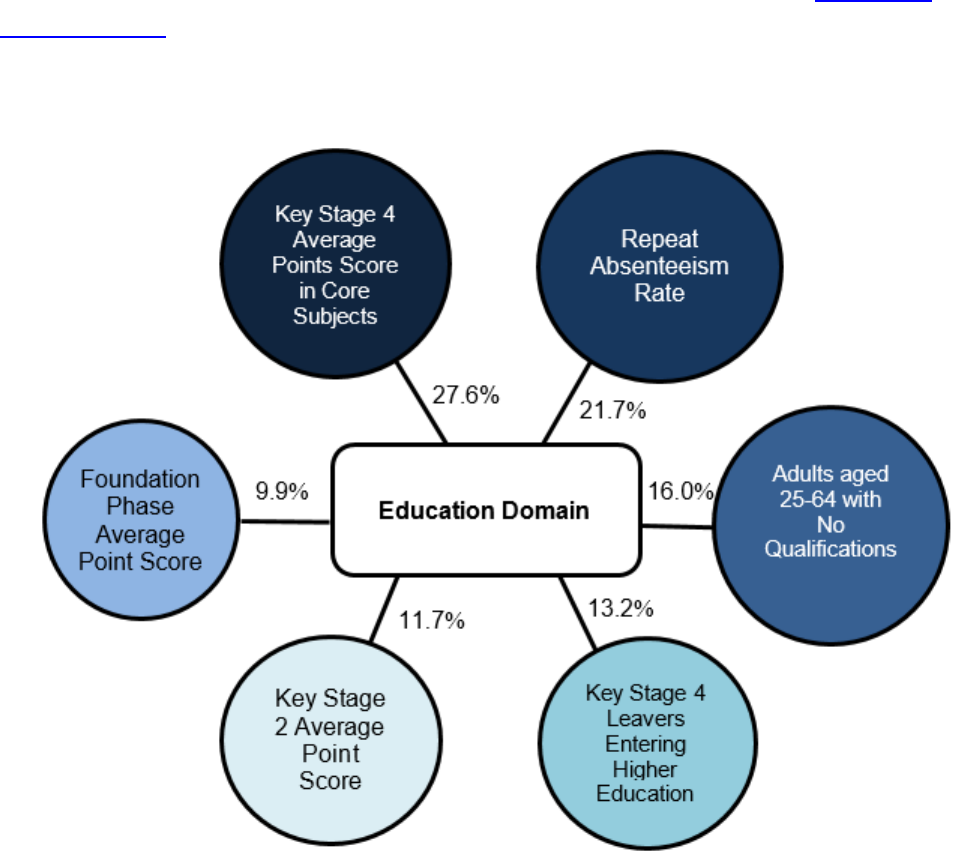
57
6. Education domain
6.1. Introduction
The purpose of this domain is to capture the extent of deprivation relating to education, training and
skills. It is designed to reflect educational disadvantage within an area in terms of lack of
qualifications and skills.
The domain has a relative weight of 14% in the overall index. The indicators are weighted as shown
below. For a complete description of the construction of the domain, please see the WIMD 2019
Technical Report.
6.2. Indicators
The domain contains 6 indicators, weighted as shown below:
Four of these indicators focus on capturing low attainment among children and young people:
The Foundation Phase Average Point Score indicator measures the average point scores of
pupils as assessed by teachers in Year 2 (final year of the Foundation Phase), and is based on
a three-year average (academic years 2015/16 – 2017/18). The data are derived from the
National Data Collection Database (NDC) and the Pupil Level Annual Schools Census
(PLASC), Welsh Government.

58
The Key Stage 2 (KS2) Average Point Score indicator measures the average point scores of
pupils as assessed by teachers in Year 6 (final year of primary school), and is based on a
three-year average (academic years 2015/16 – 2017/18). The data are derived from the
National Data Collection Database (NDC) and the Pupil Level Annual Schools Census
(PLASC), Welsh Government.
The Key Stage 4 (KS4) Average Point Score in Core Subjects indicator measures the average
point scores of year 11 pupils calculated from the grades achieved in the core subjects of
GCSE English or Welsh, GCSE Mathematics and GCSE Science (or equivalent qualifications).
It is based on a three-year average (academic years 2015/16 – 2017/18) and the data are
derived from the National Pupil Database (NPD), the Welsh Examinations Database (WED) and
PLASC, Welsh Government.
The Repeat Absenteeism indicator measures the percentage of primary and secondary pupils
missing more than 15% of school sessions, and is based on a three-year average (academic
years 2015/16 – 2017/18). The data are derived from NPD and PLASC, Welsh Government.
The other two indicators focus on capturing the lack of qualifications and skills in adults:
The KS4 Leavers Entering Higher Education indicator measures the proportion of KS4 pupils
who, at some point in the subsequent three years after leaving year 11, enter Higher Education
(defined as any programme of learning above level 3), and is based on a 4 year average
(academic years 2011/12 to 2014/15). The data is derived from the Higher Education Statistics
Agency (HESA) record, PLASC and the Lifelong Learning Wales Record (LLWR), Welsh
Government.
The No Qualifications indicator measures the numbers of adults aged 25-64 with no
qualification, and is based on 2011 Census data.
For a full explanation of how these indicators are calculated and combined together, please see the
WIMD 2019 Technical Report.
6.3. Education domain key results
The overall patterns of educational deprivation in WIMD 2019 are similar to those for WIMD
2014. This is shown in the map below.
The local authorities with the highest concentration of areas in the most deprived 10% were
Newport, Neath Port Talbot, Blaenau Gwent and Rhondda Cynon Taf.
Ceredigion, Isle of Anglesey and Monmouthshire had no areas in the most deprived 10%.
The most educationally deprived small area in Wales was Queensway 1, an area of the Caia
Park Community in Wrexham.
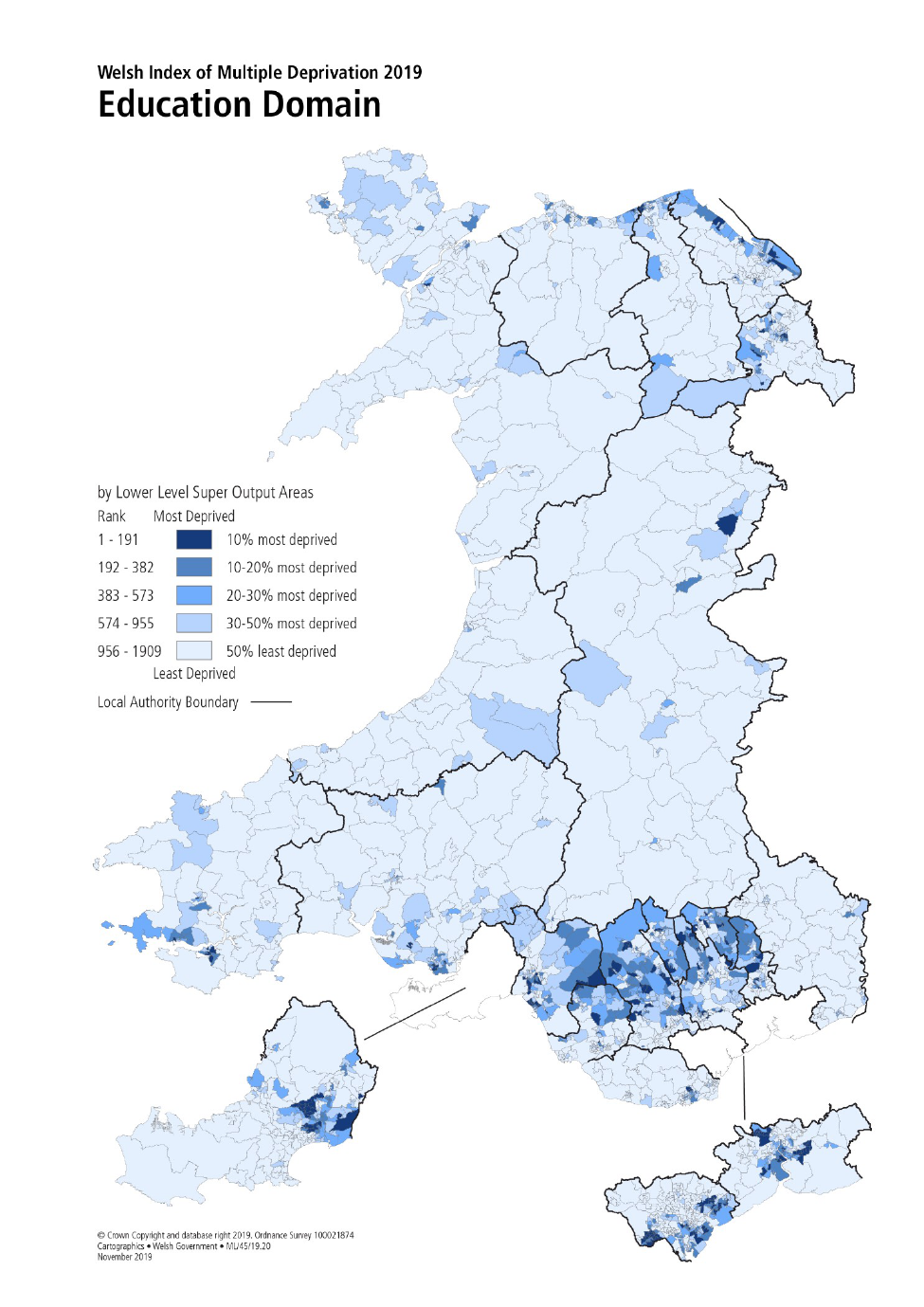
59
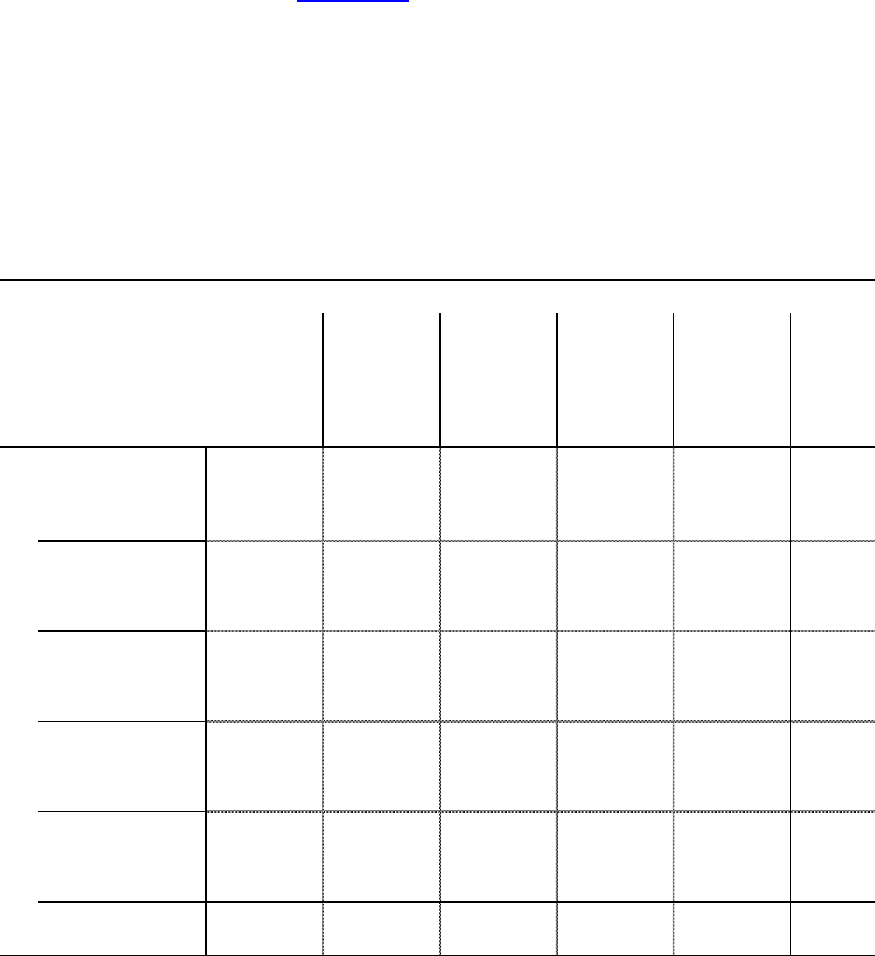
60
6.4. Education domain comparison between WIMD 2014 and WIMD 2019
The full set of domain ranks from WIMD 2019 and the underlying indicators can be downloaded
from the Welsh Government’s StatsWales web pages.
The table below shows the number of small areas (LSOAs) in each of the WIMD deprivation groups
for WIMD 2014 and WIMD 2019. The diagonal, in bold, shows the number of areas which have
remained in the same deprivation group. Above the diagonal are numbers of areas which have
moved from a more to a less deprived group. Below the diagonal are the numbers of areas which
have moved from a less to a more deprived group.
Table 13: Movement between Education deprivation groups between WIMD 2014 and
2019
Relatively more deprived: 50 areas have moved into the 10% most deprived group for this domain
in WIMD 2019. These are spread across 14 local authorities and the majority were in the 10 to 30%
most deprived areas for the domain in WIMD 2014. One area moved substantially from the least
deprived 50% in WIMD 2014.
Relatively less deprived: 50 areas have moved from the 10% most deprived group in WIMD 2019.
These are spread across 13 local authorities and the majority moved to the 10 to 20% most
deprived group. No areas moved substantially into the 50% least deprived group.
10% most
deprived
(ranks
1-191)
10-20%
most
deprived
(ranks
192-382)
20-30%
most
deprived
(ranks
383-573)
30-50%
most
deprived
(ranks
574-955)
50% least
deprived
(ranks
956-1909)
Total
(ranks
1-1909)
10% most
deprived
(ranks 1-191)
141 39 10 1 0 191
10-20% most
deprived
(ranks 192-382)
36 76 52 24 3 191
20-30% most
deprived
(ranks 383-573)
10 54 60 60 7 191
30-50% most
deprived
(ranks 574-955)
3 21 62 195 101 382
50% least
deprived
(ranks 956-1909)
1 1 7 102 843 954
Total
(ranks 1-1909)
191 191 191 382 954 1909
Education domain 2019
Education domain 2014
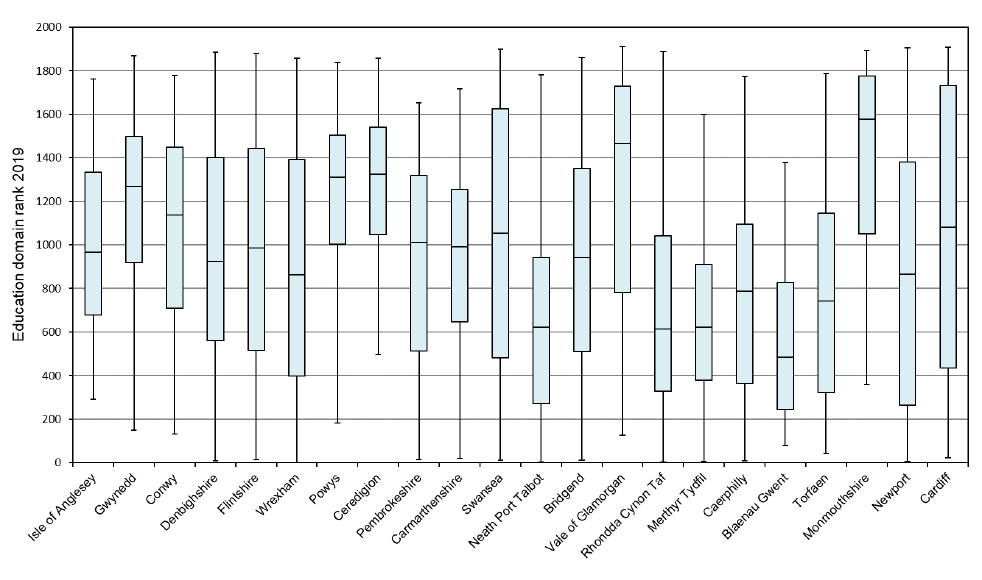
61
6.5. Education domain local authority analysis
The chart below shows the spread of education domain ranks for each local authority in Wales. The
blue boxes contain half the total number of areas in each local authority, centred on the median
(middle) rank for each local authority and the ‘whiskers’ show the full range of ranks. Deprivation
increases with decreasing rank (that is, towards the bottom of the plot).
Chart 7: Box plot of WIMD 2019 Education domain ranks, by local authority

62
The table below shows, for the education domain of WIMD 2019, the percentage of small areas
(LSOAs) in each local authority which were in the most deprived 10%, 20%, 30% and 50% areas in
Wales.
Table 14: Concentrations of WIMD 2019 Education domain deprived areas, by local
authority
One way of considering WIMD data at the local authority level is to look at the proportion of areas
within the local authority that are in the most deprived 10% (or 20% etc) of all areas in Wales. This
method can be seen as identifying the concentration of the most deprived areas in a local authority,
rather than an average level of deprivation.
Local Authority
Number of
LSOAs in
local
authority
% LSOAs in
most-
deprived
10%
ranks 1-191
% LSOAs in
most-
deprived
20%
ranks 1-382
% LSOAs in
most-
deprived
30%
ranks 1-573
% LSOAs in
most-
deprived
50%
ranks 1-955
Isle of Anglesey 44 0.0 15.9 18.2 47.7
Gwynedd 73 1.4 4.1 6.8 26.0
Conwy 71 1.4 8.5 19.7 38.0
Denbighshire 58 8.6 15.5 29.3 51.7
Flintshire 92 9.8 18.5 30.4 47.8
Wrexham 85 11.8 24.7 35.3 54.1
Powys 79 1.3 7.6 11.4 22.8
Ceredigion 46 0.0 0.0 2.2 21.7
Pembrokeshire 71 8.5 19.7 26.8 49.3
Carmarthenshire 112 7.1 12.5 21.4 48.2
Swansea 148 11.5 18.9 30.4 45.3
Neath Port Talbot 91 19.8 31.9 45.1 74.7
Bridgend 88 6.8 17.0 27.3 50.0
Vale of Glamorgan 79 3.8 10.1 15.2 32.9
Rhondda Cynon Taf 154 14.3 31.8 46.8 69.5
Merthyr Tydfil 36 11.1 25.0 41.7 77.8
Caerphilly 110 12.7 28.2 38.2 65.5
Blaenau Gwent 47 17.0 38.3 59.6 85.1
Torfaen 60 13.3 28.3 41.7 60.0
Monmouthshire 56 0.0 1.8 7.1 21.4
Newport 95 21.1 29.5 44.2 52.6
Cardiff 214 14.0 24.3 31.8 47.2
Wales 1909 10 20 30 50

63
The local authority with the highest concentration of areas in the most deprived 10% in
Wales was Newport (21.1%, or 20 areas).
The local authorities with the lowest proportion of areas in the most deprived 10% in Wales
were Ceredigion, Isle of Anglesey and Monmouthshire with 0% of their areas in the most
deprived 10%. Only 21.4% of the areas in Monmouthshire and 21.7% of the areas in
Ceredigion were in the most deprived 50% in Wales.
Blaenau Gwent had the highest percentage of areas in the most deprived 50% in Wales
(85.1%). The next highest was Merthyr Tydfil, with 77.8% of its areas in the most deprived
half of Wales.
6.6. Education domain methodological changes between WIMD 2014 and WIMD 2019
Three of the six indicators in the WIMD 2019 education domain were present in WIMD 2014:
Key Stage 2 Average Point Score
Repeat Absenteeism Rate
Number of Adults aged 25-64 with No Qualifications
A Foundation Phase Average Point Score indicator based upon the results of teacher assessments
for pupils taught in National Curriculum Year Group 2 has been included in WIMD 2019. It is
intended to complement the Key Stage 2 Average Point Score indicator to measure education
deprivation at primary school level.
The two Key Stage 4 indicators included in WIMD 2014 have been replaced with a single indicator.
This indicator has been constructed using a new methodology and is, therefore, not comparable
with the previous indicators used in WIMD 2014.
The Proportion of People aged 18-19 not entering Higher Education indicator has been replaced
with an indicator measuring the Proportion of Key Stage 4 Leavers entering Higher Education.
Whilst these indicators measure similar things, they are not directly comparable.
6.7. Education domain background information
Welsh Government Education Statistics
The Welsh Government publishes a comprehensive set of information on education and skills in
Wales. These statistics cover a wide range of topics relating to Education including schools, further
and higher education and work-based learning.
Key Stage 4
In September 2019, the Welsh Government moved to an updated ‘capped 9’ points score to
measure achievement at KS4. However, changes to KS4 measures have been implemented
gradually since 2015/16 and it was not possible to produce three comparable years of ‘capped 9’

64
points score data for WIMD 2019. Therefore the KS4 Average Point Score in Core Subjects
indicator was developed as an interim indicator but it is anticipated that the KS4 ‘capped 9’ point
score will be adopted for future iterations of WIMD.
Young people not in education, employment or Training / learner destinations
Conceptually, a measure of those not in education, employment or training (NEET) would be a
suitable measure of educational deprivation.
Headline estimates of young people who are NEET can be found in the statistical release
'Participation of young people in education and the labour market'. However, the estimates are
available at Wales level only and, as the number of those who are NEET is relatively low and this
data is collected using a sample survey, it is not possible to derive an indicator at a small area level.
Hence this indicator was not included in WIMD 2019.
There is a Welsh Government programme of work currently looking at the development of KS4 /
KS5 destinations datasets. These datasets are derived by the linking of education data-sources
alongside engagement with DfE’s Longitudinal Educational Outcomes Study (which aims to link
education datasets to employment/earning data from DWP/HMRC) and provide data on where
pupils go once they leave compulsory education. Experimental statistics produced from these
datasets can be found in the statistical release 'Consistent performance measures for post-16
learning (learner destinations): August 2015 to July 2016'.
Whilst it was not possible to use these datasets to produce a NEETs indicator for WIMD 2019, they
were used to produce the KS4 leavers entering Higher Education indicator. The ongoing
development of these datasets will be monitored and their potential for inclusion in future WIMD
releases considered.

65
7. Access to Services domain
7.1. Introduction
The purpose of this domain is to capture deprivation as a result of a household’s inability to access
a range of services considered necessary for day-to-day living, both physically and online. This
covers both material deprivation (for example, not being able to get food) and social aspects of
deprivation (for example, not being able to attend after school activities). Poor access to services is
a factor which can compound other types of deprivation that exist in an area.
The access to services domain measures travel times to a range of services as a proxy for wider
physical access to services. For WIMD 2019, the domain also considers access to digital services,
through an indicator on the availability of superfast broadband.
In terms of the travel times, measurements do not take into account the availability of the services to
the individual once they get there (e.g. availability of GP appointments), nor does it take into
account an individual’s personal choice in accessing certain services (e.g. if someone would prefer
to be educated at a faith school).
In terms of digital services, measurement takes into account reported operator data on availability of
fixed line broadband services, but does not take into account take-up.
The domain has a relative weight of 10% in the overall index. The indicators are weighted as shown
below. For a complete description of the construction of the access to services domain, please see
the WIMD 2019 Technical Report.
7.2. Access to Services domain indicators
The access to services domain contains 10 indicators.
Of these, 9 are physical access indicators, each relating to a type of service such as food shop or
school. Each indicator measures an average return travel time (in minutes) from residential
dwellings to the nearest service, by public and private transport. Public transport includes travel by:
public bus, public train, foot, and national coach. Private transport is considered to be transport by
private car. The weights to combine the public and private transport times together are calculated
for each area using data from the 2011 Census on car ownership and the number of adults aged 17
and over.
The domain also includes a new indicator, measuring access to digital services. This is calculated
as the proportion of homes and small businesses unable to receive fixed line broadband at a
download speed of at least 30Mb/s (superfast broadband). This includes properties with no
broadband coverage. The source is Ofcom’s Connected Nations update, Spring 2019. Ofcom
collects and analyses data from the main fixed broadband internet service providers on addresses
covered by their service.
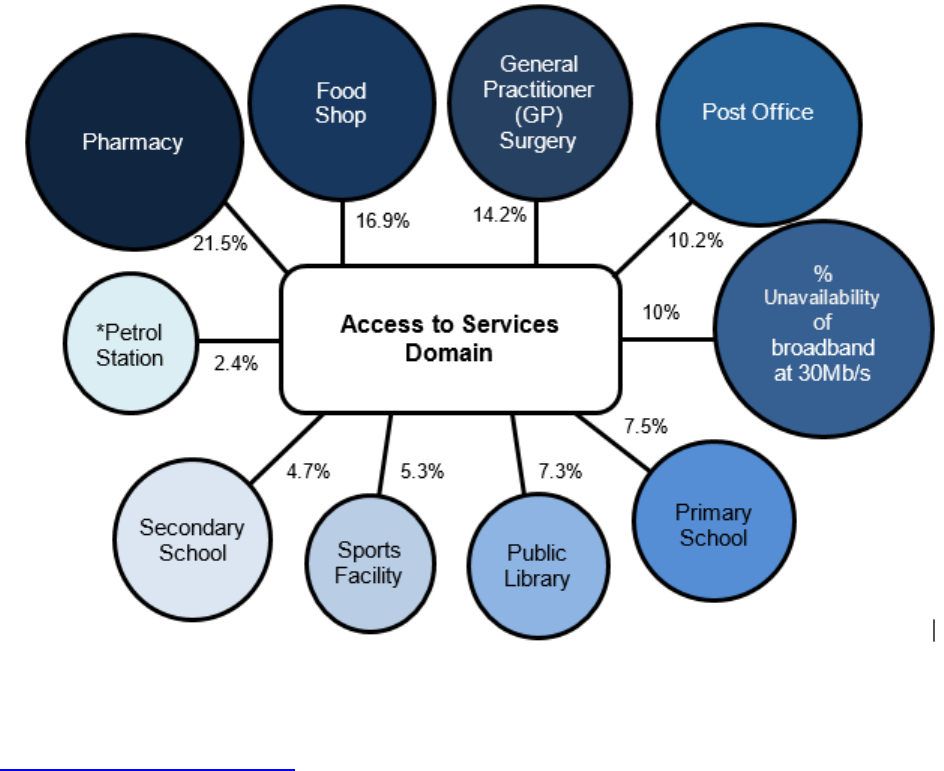
66
The physical and digital aspects are treated as two sub-domains, with the 9 travel time indicators
weighted together using factor analysis (see resultant weights below), then combined with the single
access to digital services indicator, which is given a weight of 10%.
*The average travel time to a Petrol Station indicator only considers private transport.
For a full explanation of how these indicators are calculated and combined together, please see the
WIMD 2019 Technical Report.
67
7.3. Access to Services domain key results
In the WIMD 2019 access to services domain, high deprivation was widespread across rural
areas of Wales. There were also some deprived pockets near large urban areas. This is
shown in the map below.
The local authorities with the highest proportion of small areas in the most deprived 10% in
Wales for access to services were Powys (50.6%) and Ceredigion (50.0%).
Cardiff, Neath Port Talbot, Bridgend, Rhondda Cynon Taf, Blaenau Gwent and Torfaen local
authorities had no areas in the most deprived 10%.
For the access to services domain, the most deprived small area in Wales was Cynwyl
Gaeo, Carmarthenshire, the same as for WIMD 2014. Six of the 10 most deprived areas in
WIMD 2019 were also in the 10 most deprived areas in WIMD 2014.
The overall patterns of access to services deprivation in WIMD 2019 are similar to those for
WIMD 2014.
However, there have been notable changes to relative ranks at the least deprived end. This
reflects the significant improvements in the travel time calculations (see section 7.6), as well
as possible changes to service locations, public transport and road networks since 2014,
and the inclusion of the new access to digital services indicator.
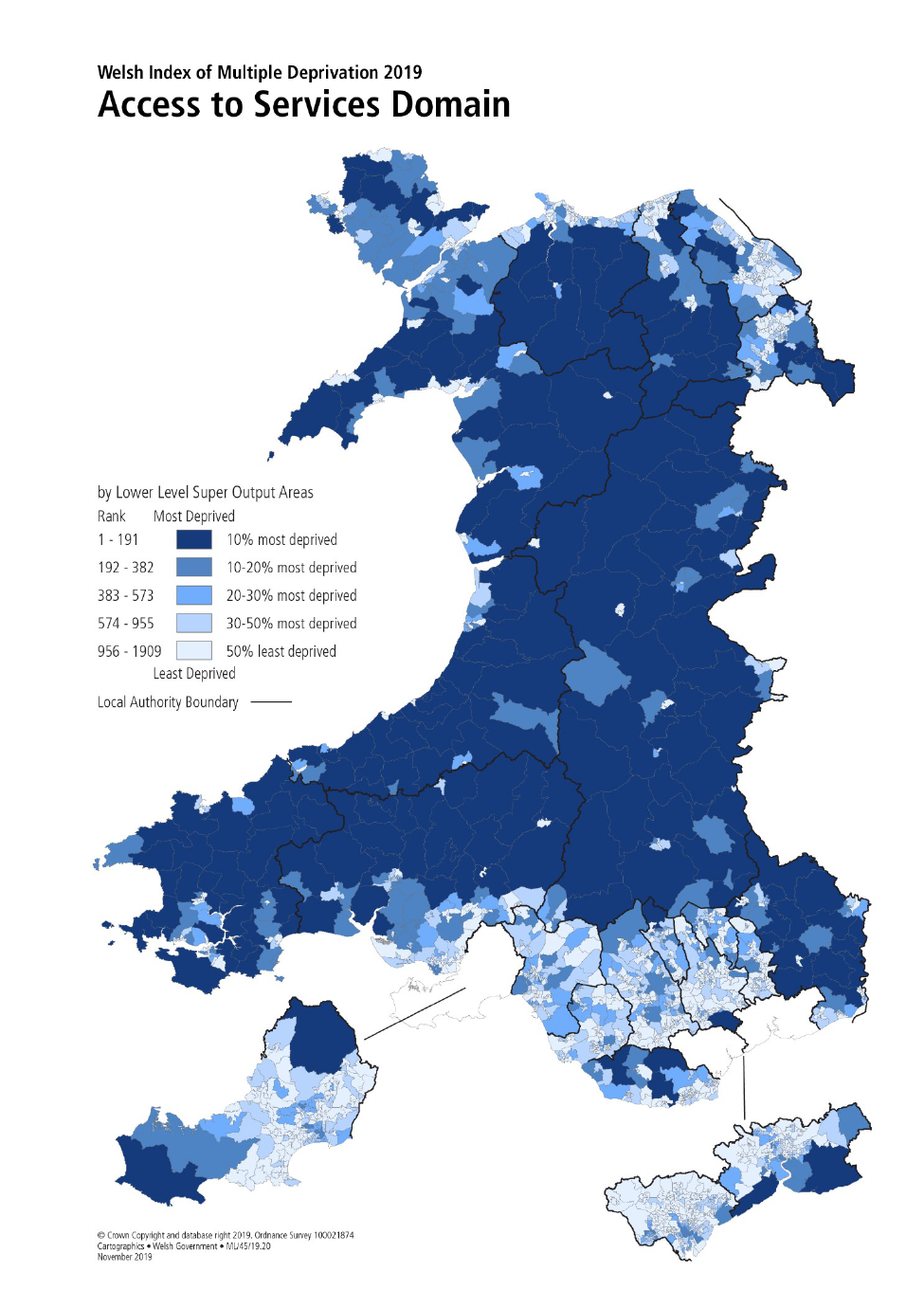
68

69
7.4. Access to Services domain comparison between WIMD 2014 and WIMD 2019
The full set of domain ranks from WIMD 2019 and the underlying indicators can be downloaded
from the Welsh Government’s StatsWales web pages.
The table below shows the number of small areas (LSOAs) in each of the WIMD deprivation groups
for WIMD 2014 and WIMD 2019. The diagonal, in bold, shows the number of areas which have
remained in the same deprivation group. Above the diagonal are numbers of areas which have
moved to a less deprived group. Below the diagonal are the numbers of areas which have moved to
a more deprived group.
Table 15: Movement between Access to Services deprivation group between WIMD
2014 and WIMD 2019
Caution should be used in interpreting the table above. Significant changes to the methodology
mean that it is difficult to interpret changes between WIMD 2014 and WIMD 2019. See section 7.6
for further details.
Relatively more deprived: Twenty-two areas have moved into the 10% most deprived group in
WIMD 2019, spread across 10 of the 22 local authorities in Wales. They were all within the 30%
most deprived areas for the domain in WIMD 2014.
Relatively less deprived: Twenty-two areas have moved from the 10% most deprived group for this
domain in WIMD 2014, one of which moved into the least deprived half, and a further 2 into the
10% most
deprived
(ranks
1-191)
10-20%
most
deprived
(ranks
192-382)
20-30%
most
deprived
(ranks
383-573)
30-50%
most
deprived
(ranks
574-955)
50% least
deprived
(ranks
956-1909)
Total
(ranks
1-1909)
10% most
deprived
(ranks 1-191)
169 19 0 2 1 191
10-20% most
deprived
(ranks 192-382)
20 89 41 31 10 191
20-30% most
deprived
(ranks 383-573)
2 29 43 72 45 191
30-50% most
deprived
(ranks 574-955)
0 30 54 110 188 382
50% least
deprived
(ranks 956-1909)
0 24 53 167 710 954
Total
(ranks 1-1909)
191 191 191 382 954 1909
Access to services domain 2019
Access to services domain 2014

70
least deprived 70% of areas in WIMD 2019. All three areas moving furthest out of the most deprived
decile were near Glynneath in Neath Port Talbot local authority.
7.5. Access to Services domain local authority analysis
The chart below shows the spread of access to services domain ranks for each local authority in
Wales. The blue boxes contain half the total number of areas in each local authority, centred on the
median (middle) rank for each local authority and the lines show the full range of ranks. Deprivation
increases with decreasing rank (that is, towards the bottom of the plot).
Chart 8: Box plot of WIMD 2019 Access to Services domain ranks, by local authority

71
The table below shows, for the access to services domain of WIMD 2019, the percentage of small
areas (LSOAs) in each local authority which were in the most deprived 10%, 20%, 30% and 50%
areas in Wales.
Table 16: Concentration of WIMD 2019 Access to Services deprived areas, by local
authority
One way of considering WIMD data at the local authority level is to look at the proportion of areas
within the local authority that are in the most deprived 10% (or 20% etc.) of all areas in Wales. This
method can be seen as identifying the concentration of the most deprived areas in a local authority,
rather than an average level of deprivation.
Local authority
Number of
LSOAs in
local
authority
% LSOAs in
most-
deprived
10%
ranks 1-191
% LSOAs in
most-
deprived
20%
ranks 1-382
% LSOAs in
most-
deprived
30%
ranks 1-573
% LSOAs in
most-
deprived
50%
ranks 1-955
Isle of Anglesey 44 15.9 45.5 50.0 65.9
Gwynedd 73 27.4 50.7 63.0 74.0
Conwy 71 12.7 16.9 28.2 54.9
Denbighshire 58 13.8 31.0 32.8 46.6
Flintshire 92 3.3 15.2 19.6 41.3
Wrexham 85 7.1 16.5 24.7 47.1
Powys 79 50.6 68.4 74.7 87.3
Ceredigion 46 50.0 63.0 80.4 87.0
Pembrokeshire 71 38.0 56.3 64.8 74.6
Carmarthenshire 112 21.4 38.4 46.4 69.6
Swansea 148 1.4 5.4 17.6 39.9
Neath Port Talbot 91 0.0 8.8 23.1 53.8
Bridgend 88 0.0 5.7 13.6 42.0
Vale of Glamorgan 79 3.8 7.6 11.4 32.9
Rhondda Cynon Taf 154 0.0 7.8 18.8 40.9
Merthyr Tydfil 36 2.8 19.4 36.1 63.9
Caerphilly 110 0.9 4.5 14.5 26.4
Blaenau Gwent 47 0.0 17.0 38.3 51.1
Torfaen 60 0.0 5.0 11.7 38.3
Monmouthshire 56 26.8 39.3 51.8 66.1
Newport 95 2.1 8.4 23.2 43.2
Cardiff 214 0.0 4.2 14.5 36.0
Wales 1909 10 20 30 50
72
The local authority with the highest proportion of small areas in the most deprived 10% in Wales for
access to services was Powys (50.6%, or 40 areas). Ceredigion was the next highest, with 50% (or
23) of its areas in the most deprived 10%. This is because these local authorities are large and
sparsely populated, with many small rural settlements.
Neath Port Talbot, Bridgend, Rhondda Cynon Taf, Blaenau Gwent, Torfaen, and Cardiff local
authorities had no small areas in the most deprived 10%. However the local authority with the
fewest areas that were among the most deprived 50% in Wales was Caerphilly (26.4% or 29 areas).
Powys and Ceredigion had just under 90% of their small areas in the most deprived 50% in Wales,
followed by Gwynedd and Pembrokeshire, with around three-quarters of their areas in the most
deprived half of Wales.
7.6. Access to Services domain methodological changes between WIMD 2014 and
WIMD 2019
As well as updating the WIMD 2014 suite of indicators measuring travel times to key services, we
have introduced a new indicator on access to digital services, weighted as 10% within the domain.
This indicator is calculated as the proportion of homes and small businesses unable to receive fixed
line broadband at a download sync speed of at least 30Mb/s (superfast broadband). This includes
properties with no broadband coverage.
Concerning calculation of updated travel times to key services, whilst the principles of methodology
have not changed between WIMD 2014 and WIMD 2019 – the technical toolkits used have
undergone rigorous change to seek to increase the accuracy, robustness and repeatability of the
data. These changes included:
Improvements to granularity of private routing, providing mapping to the doorstep of every
residential address.
Improvements to granularity of public transport routing, changing from a gridded catchment
approach in WIMD 2014 to that of an isochrone approach in WIMD 2019.
Improvements to the definition of residential dwelling to be as encompassing to the
population of Wales as possible, by using domestic council tax records.
Types of services modelled remain unchanged from WIMD 2014, and as such, data sources, the
number of sites and the definitions adhered to are mostly comparable. However, the Food shops
indicator has been enhanced to include certain chains of Frozen Food retailers who adhere to our
basic provisions definition. Leisure Centres have been renamed to Sports Facilities to encompass
the wider service offering now modelled.
Due to the above, care should be taken in interpreting changes in the travel time indicator values,
which are not strictly comparable to older data. The main effect of the update is to raise the lower

73
travel times, leading to notable movements between relative ranks at the least deprived end. More
generally, reasons for changes include:
changes to the methodology used to calculate the travel times by both private and public
transport (see above)
the opening and closure of services since 2014
changes in public transport and road networks since 2014
changes to location of residential dwellings in an area (e.g. new housing) since 2014
For a more detail, see the WIMD 2019 Technical Report.
7.7. Access to Services background information
Further related WIMD analysis
Following on from publication of WIMD 2019, related statistical articles produced following WIMD
2014 will be updated with the new data, and published in due course on our website. Links to the
WIMD 2014 versions are provided below:
A guide to analysing deprivation in rural areas
Analysis of the Access to Services Domain by type of settlement
Data Science Campus – multi-modal transport journey analysis
To improve our measurement of access to services, we have used the Data Science Campus at
ONS’s new tool to analyse multi-modal transport journeys. The tool, called “propeR” and written for
the R programming language, will improve the granularity and ease of performing public transport
travel time analysis across Wales, and beyond.
Alternative approach - floating catchment areas
The WISERD team at the University of South Wales have been undertaking research
2
into a
refinement of the approach for assessing service accessibility, called the enhanced two-step floating
catchment area (E2SFCA) method, a derivative of gravity model techniques.
Their work aims to calculate, for each location of interest, a service access figure that takes into
consideration the geographical distribution of all supply sites found within a reasonable travel
time/distance. Both the proximity and capacity of such sites are evaluated in relation to the potential
service demand placed upon each by their own local populations.
2
For example the recent articles: Measuring Spatial Accessibility to Services within Indices of
Multiple Deprivation and Investigating spatial variations in access to childcare provision using
network‐based Geographic Information System models

74
Where possible, we will continue to share inputs and methods for this domain with the WISERD
team. This will enable the production of a parallel set of outputs using the FCA method, allowing us
to assess the implications of adopting an FCA approach on future Access to Services domain data.
National Survey for Wales – access to services
In 2017-18, the National Survey for Wales asked questions about whether people are satisfied with
their ability to access the services and facilities they need. Results are summarised in a statistical
bulletin.

75
8. Housing domain
8.1. Introduction
Conceptually, the purpose of the housing domain is to identify inadequate housing, in terms of
physical and living conditions and availability. Here, living condition means the suitability of the
housing for its inhabitant(s), for example in terms of health and safety, and necessary adaptations.
Housing as a component of multiple deprivation is somewhat different to most other domains.
Generally, housing tenure, age and type tend to influence measures of housing deprivation, as
defined above. For example, different tenures of housing have varying regulations or standards
applicable to them, which can influence housing quality. Therefore we would not always expect
measures of housing deprivation to correlate strongly with overall deprivation. However, as with
poor access to services, the compounding effect of poor housing along with other components of
deprivation, such as health can be significant, and is important to capture.
The domain has a relative weight of 7% in the overall index. This has increased from 5% in the
2014 index, due to the addition of a new modelled indicator on the likelihood of poor quality housing.
For a complete description of the construction of the domain, please see the WIMD 2019 Technical
Report.
8.2. Indicators
The domain contains two indicators, weighted as shown below:
The indicator on overcrowding measures the percentage of people living in overcrowded
households (2011 Census-based bedroom measure)
The indicator on poor quality housing is a modelled indicator. It measures the likelihood of
housing being in disrepair or containing serious hazards (for example, risk of falls or cold
housing).
For further description of these indicators, and explanation of how they are calculated and combined
together, please see section 8.6, and the WIMD 2019 Technical Report.

76
8.3. Housing domain key results
In the WIMD 2019 housing domain, there were pockets of high housing deprivation in the
South Wales cities and valleys, as well as in West and North Wales. This is shown in the
map below.
The local authority with the highest concentration of areas in the most deprived 10% was
Ceredigion (28.3%). Merthyr Tydfil had the highest percentage of areas in the most deprived
50% in Wales (86.1%).
Torfaen had no areas in the most deprived 10% in Wales and in Monmouthshire only 1.8%
of small areas (or 1 LSOA) fell in this group.
For the housing domain, the most deprived area in Wales was Grangetown 9 in Cardiff,
around the North end of Corporation Road. In fact, the top four most housing deprived areas
in Wales were adjacent areas in Grangetown.
When looking at the top 10 most housing deprived areas in Wales, 8 were in Cardiff (in
Grangetown and Riverside) with the other two in Swansea and Newport (Castle 6 and
Victoria 3, respectively). Previously, all were ranked within the top 31 most deprived areas in
the WIMD 2014 housing domain.
There have been changes in the patterns of housing deprivation seen in WIMD 2019
compared to those seen in WIMD 2014. This is to be expected given the inclusion of the new
indicator on poor quality housing alongside the overcrowding measure (also used in WIMD
2014). An indicator on lack of central heating has been removed from the index, as
explained in the WIMD 2019 consultation summary.

77

78
8.4. Housing domain comparison between WIMD 2014 and WIMD 2019
The full set of domain ranks from WIMD 2019 and the underlying indicators can be downloaded
from the Welsh Government’s StatsWales web pages.
The table below shows the number of small areas (LSOAs) in each of the WIMD deprivation groups
for WIMD 2014 and WIMD 2019. The diagonal, in bold, shows the number of areas which have
remained in the same deprivation group. Above the diagonal are numbers of areas which have
moved from a more to a less deprived group. Below the diagonal are the numbers of areas which
have moved from a less to a more deprived group.
Table 17: Deprivation group movements for the Housing domain between WIMD 2014
and 2019
Relatively more deprived: Four areas have moved from the least deprived 50% group in WIMD 2014
to the 10% most deprived group in WIMD 2019. Three of these areas are in rural villages in
Flintshire, Monmouthshire and Denbighshire, with one area on the outskirts of a town in Bridgend
(Maesteg). These changes are driven by relatively high rates in the new poor quality housing
indicator.
Relatively less deprived: Twelve areas have moved from the 10% most deprived group in WIMD
2014 to the 50% least deprived group in WIMD 2019. All of these areas were in relatively urban
areas spread across Wales, with half (six) in Cardiff. Despite having relatively high rates of
overcrowding, these areas have low likelihood of poor quality housing
3
.
3
The two indicators are now weighted equally in the domain, whereas in WIMD 2014, the overcrowding
indicator was weighted higher (67%) than the (previous) other indicator on lack of central heating (33%).
10% most
deprived
(ranks
1-191)
10-20%
most
deprived
(ranks
192-382)
20-30%
most
deprived
(ranks
383-573)
30-50%
most
deprived
(ranks
574-955)
50% least
deprived
(ranks
956-1909)
Total
(ranks
1-1909)
10% most
deprived
(ranks 1-191)
105 32 15 27 12 191
10-20% most
deprived
(ranks 192-382)
46 46 35 43 21 191
20-30% most
deprived
(ranks 383-573)
19 46 26 53 47 191
30-50% most
deprived
(ranks 574-955)
17 46 63 130 126 382
50% least
deprived
(ranks 956-1909)
4 21 52 129 748 954
Total
(ranks 1-1909)
191 191 191 382 954 1909
Housing domain 2019
Housing domain 2014

79
8.5. Housing domain local authority analysis
The chart below shows the spread of housing domain ranks for each local authority in Wales. The
blue boxes contain half the total number of small areas in each local authority, centred on the
median (middle) rank for each local authority and the ‘whiskers’ show the full range of ranks.
Deprivation increases with decreasing rank (that is, towards the bottom of the plot).
Chart 9: Box plot of WIMD 2019 housing domain ranks, by local authority

80
The table below shows, for the housing domain of WIMD 2019, the percentage of small areas
(LSOAs) in each local authority which were in the most deprived 10%, 20%, 30% and 50% areas in
Wales.
Table 18: Concentrations of WIMD 2019 Housing deprived areas, by local authority
One way of considering WIMD data at the local authority level is to look at the proportion of areas
within the local authority that are in the most deprived 10% (or 20% etc.) of all small areas in Wales.
This method can be seen as identifying the concentration of the most deprived areas in a local
authority, rather than an average level of deprivation.
Local authority
Number of
LSOAs in
local
authority
% LSOAs in
most-
deprived
10%
ranks 1-191
% LSOAs in
most-
deprived
20%
ranks 1-382
% LSOAs in
most-
deprived
30%
ranks 1-573
% LSOAs in
most-
deprived
50%
ranks 1-955
Isle of Anglesey 44 2.3 20.5 27.3 47.7
Gwynedd 73 21.9 39.7 49.3 75.3
Conwy 71 8.5 18.3 28.2 46.5
Denbighshire 58 15.5 27.6 32.8 60.3
Flintshire 92 2.2 12.0 20.7 42.4
Wrexham 85 5.9 11.8 22.4 47.1
Powys 79 2.5 12.7 30.4 54.4
Ceredigion 46 28.3 47.8 58.7 78.3
Pembrokeshire 71 7.0 9.9 19.7 47.9
Carmarthenshire 112 11.6 20.5 33.9 53.6
Swansea 148 7.4 15.5 23.6 41.2
Neath Port Talbot 91 2.2 11.0 24.2 46.2
Bridgend 88 4.5 11.4 17.0 35.2
Vale of Glamorgan 79 6.3 12.7 16.5 26.6
Rhondda Cynon Taf 154 7.8 21.4 39.0 60.4
Merthyr Tydfil 36 22.2 36.1 52.8 86.1
Caerphilly 110 3.6 12.7 24.5 55.5
Blaenau Gwent 47 10.6 27.7 40.4 61.7
Torfaen 60 0.0 13.3 23.3 38.3
Monmouthshire 56 1.8 10.7 17.9 35.7
Newport 95 12.6 25.3 27.4 37.9
Cardiff 214 25.7 31.8 39.7 51.9
Wales 1909 10 20 30 50

81
The local authority with the highest proportion of areas in the most deprived 10% in Wales was
Ceredigion (28.3%, or 13 areas). These are mainly areas in sparse villages with relatively high
likelihood of poor quality housing, but also a few areas in towns (Aberystwyth, Cardigan and
Lampeter) with relatively high overcrowding rates.
Torfaen had no small areas in the most deprived 10% in Wales and in Monmouthshire only 1.8% of
areas (1 LSOA) fell in this group. Only 26.6% of the small areas in the Vale of Glamorgan were in
the most deprived 50% in Wales.
Merthyr Tydfil had the highest percentage of areas in the most deprived 50% in Wales (86.1%). The
next highest was Ceredigion, with 78.3% of its areas in the most deprived half of Wales.
8.6. Housing domain methodological changes between WIMD 2014 and WIMD 2019
In WIMD 2014 there was a lack of appropriate data available and it was not possible to measure
fully housing deprivation according to our definition. The housing domain previously included two
2011 Census indicators:
The percentage of the population living in overcrowded households (weighted 66.6%)
The percentage of people living in a household with no central heating (weighted 33.3%)
In WIMD 2019, the housing domain continues to include the indicator on overcrowding (to capture
availability and to some extent living condition), and also consists of a modelled indicator on poor
quality housing. This indicator helps to capture both physical and living conditions.
The new indicator is calculated using a model built from survey data, which makes probabilistic
predictions about individual level dwellings in Wales, using a range of administrative datasets as
inputs. This allows us to estimate the likelihood that dwellings in a given area:
contain a Category 1 hazard for excess cold, falls or other hazards under the Housing Health
and Safety Rating System (HHSRS)
or are in a state of disrepair
A dwelling is determined to have a category 1 hazard as a result of excess cold if there is a severe
threat from sub-optimal indoor temperatures. A dwelling is assessed as having a category 1 hazard
in terms of falls if there is determined to be a serious risk of falling on stairs, between levels, level
surfaces or falling associated with a bath, shower or similar facility.
A dwelling is said to be in disrepair if at least one of the key building components is old and needs
replacing or major repair due to its condition; or more than one of the other building components are
old and need replacing or major repair.
Note that there is a requirement for social housing to maintain the Welsh Housing Quality Standard
(WHQS), and therefore in areas where there is a high proportion of social housing, the modelled
data tends to show a lower likelihood of poor quality housing.

82
This is the first instance of using modelled data in any domain of WIMD. This exercise has improved
the range of information on housing available at the local area, using indicators which align closely
with our definition of housing deprivation. Our quality assurance process, which involved local
authority officials, suggests that the model is reasonably accurate. One drawback of using this
approach on an ongoing basis would be possible limitations in reflecting the impact of recent
housing interventions or other changes. If informing decisions, modelled data should be used
alongside robust, up-to-date local data or intelligence wherever possible. We will seek to explore
alternative (non-modelled) sources for future indices, as outlined in our consultation summary.
As a result of the indicator changes that better capture housing deprivation, the housing domain has
been given an increased weight in the overall index in WIMD 2019. The domain now has a relative
weight of 7% in the overall index, increasing from 5% in the 2014 index.
Full technical information on the domain is available in the Technical Report.
8.7. Housing domain background information
Homelessness
Homelessness can be considered to be the most extreme form of deprivation in relation to access
to housing. Data relating to statutory homelessness are available at Local Authority level. Rough
Sleeper data are also available at Local Authority level.
Housing Conditions Evidence Programme
Established in 2016, the Housing Conditions Evidence Programme (HCEP) is a strategic
programme of investment in evidence about the condition and energy efficiency/ performance of
housing in Wales. It encompasses:
the Welsh Housing Conditions Survey, which collects information about the condition and
energy efficiency of all types and tenures of housing in Wales, and was last conducted in
2017-18.
the Housing Stock Analytical Resource for Wales, which aims to bring together a range of
data on the characteristics, fabric, condition and energy efficiency of the housing stock in
Wales. This resource is still at an early stage of development, but will be considered in future
index iterations, subject to the continuation of the HCEP.
Fuel Poverty
As defined in the Welsh Government’s Fuel Poverty Strategy, a household in Wales is in fuel
poverty if they spend 10% or more of their income (including Housing Benefit, Income Support for
Mortgage Interest or council tax benefits) on energy costs in order to adequately heat their homes.
Fuel poverty has a significant impact on the health, social and economic well-being of
householders. Fuel Poverty estimates for Wales for 2018 have been published and modelled Local
Authority analysis will be published in due course. However data are not currently available at small
area level.

83
Energy Efficiency
Information on Standard Assessment Procedure (SAP) ratings could be regarded as a broad proxy
for Housing quality. Homes with poor energy efficiency performance are more difficult/expensive to
heat. An Energy Performance Certificate (EPC) is required for properties when constructed, sold or
let. The EPC provides details on the energy performance of the property and what can be done to
improve it. EPC data has been published by the Ministry for Housing, Communities and Local
Government. Although coverage of EPC records across LSOAs was quite good, it is not complete
and poses risk of bias. Many records are several years out of date.
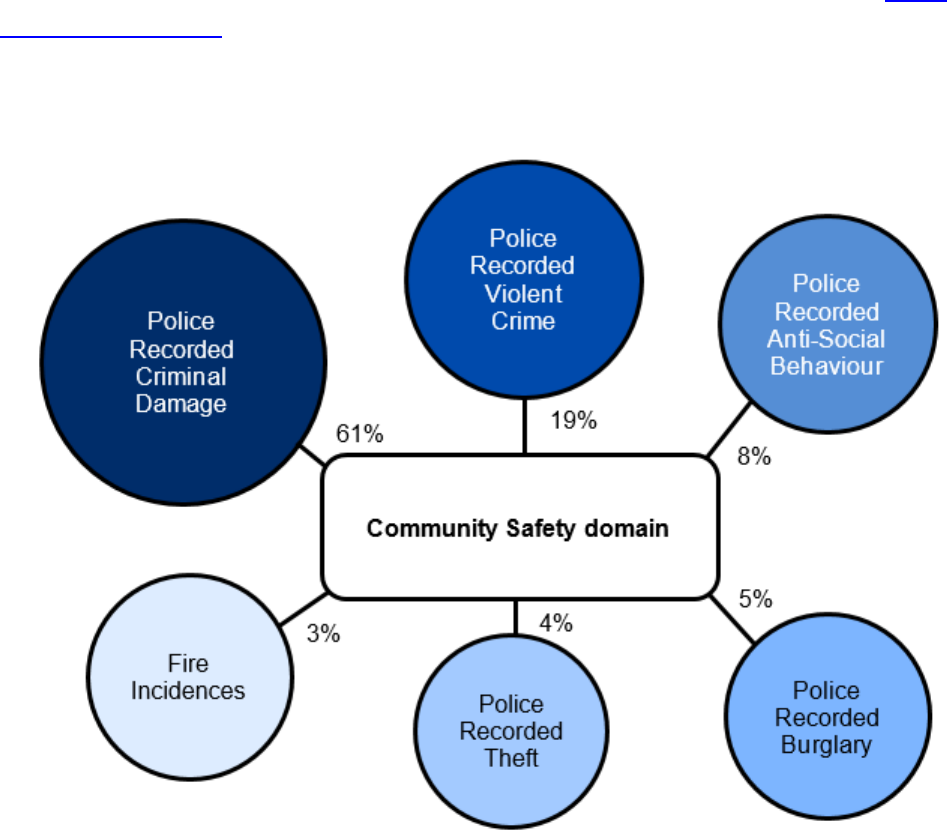
84
9. Community Safety domain
9.1. Introduction
This domain is intended to consider deprivation relating to living in a safe community. It covers
actual experience of crime and fire, as well as perceptions of safety whilst out and about in the local
area. The domain has a relative weight of 5% in the overall index. The indicators are weighted as
shown below. For a complete description of the construction of the domain, please see the WIMD
2019 Technical Report.
9.2. Indicators
The domain contains 6 indicators, weighted as shown below:
Five of these indicators are derived from Police Recorded Crime data:
The indicator on Police Recorded Criminal Damage measures the number of reported incidents
of criminal damage as a percentage of the resident population, excluding the prison population,
and is based on a two-year (2017-18 and 2018-19) average.
The indicator on Police Recorded Violent Crime measures the number of reported incidents of
violent crime as a percentage of the resident population, excluding the prison population, and is
based on a two-year (2017-18 and 2018-19) average.

85
The indicator on Police Recorded Theft measures the number of reported incidents of theft as a
percentage of the resident population, excluding the prison population, and is based on a two-
year (2017-18 and 2018-19) average.
The indicator on Police Recorded Burglary measures the number of reported incidents of
burglary as a percentage of the number of dwellings and business addresses, and is based on a
two-year (2017-18 and 2018-19) average.
The indicator on Anti-Social Behaviour incidences measures the number of reported incidents of
anti-social behaviour as a percentage of the resident population, excluding the prison population,
and is based on a two-year (2017-18 and 2018-19) average.
The sixth indicator uses fire incidence data.
The indicator on Fire Incidences measures the number of fire incidents attended as a percentage
of the resident population, and is based on a two-year (2017-18 and 2018-19) average. The data
are derived from the Fire and Rescue Services (FRS) reporting, compiled by Welsh Government.
For a full explanation of how these indicators are calculated and combined together, please see the
WIMD 2019 Technical Report.
9.3. Community Safety domain key results
In the WIMD 2019 community safety domain, there were pockets of high deprivation in the
South Wales valleys, the large cities in South Wales, and the coastal and border towns in
North Wales. This is shown in the map below.
The local authorities with the highest concentration of areas in the most deprived 10% were
Newport (35.8%) followed by Blaenau Gwent (27.7%). Monmouthshire had the lowest
proportion of areas in the most deprived 10% (1.8%, or 1 LSOA).
For the community safety domain, the most deprived small area in Wales was Cathays 10, in
Cardiff city centre, which includes Cathays Park and Bute Park.
The overall patterns of community safety deprivation in WIMD 2019 are similar to those for
WIMD 2014.
At a Wales level, there was a notable increase in the violent crime indicator and smaller
increases in the criminal damage and fire incidences indicators. Whereas decreases were
observed in the burglary, theft and anti-social behaviour indicators.
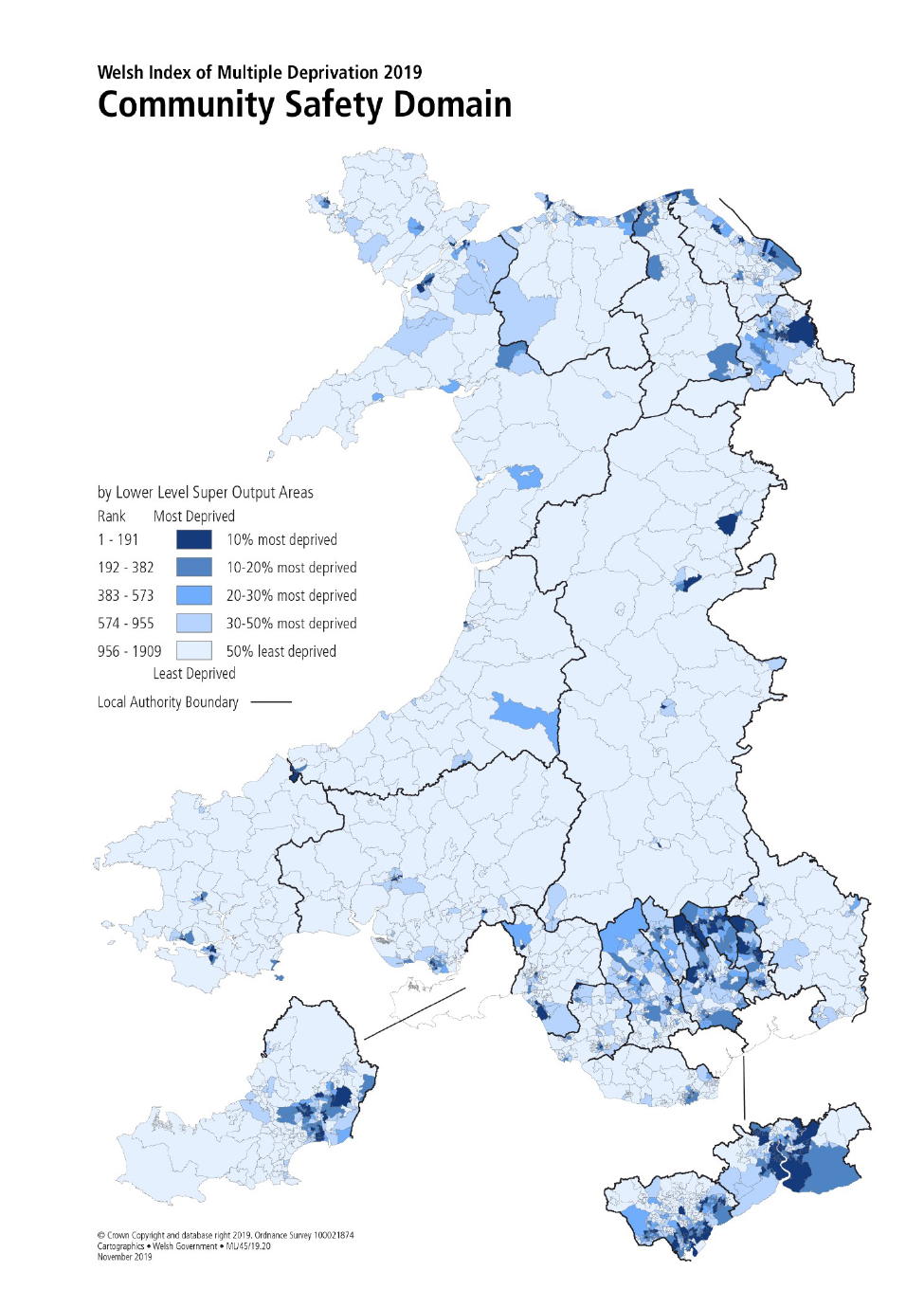
86

87
9.4. Community safety domain comparison between WIMD 2014 and WIMD 2019
The full set of domain ranks from WIMD 2019 and the underlying indicators can be downloaded
from the Welsh Government’s StatsWales web pages.
The table below shows the number of small areas (LSOAs) in each of the WIMD deprivation groups
for WIMD 2014 and WIMD 2019. The diagonal, in bold, shows the number of areas which have
remained in the same deprivation group. Above the diagonal are numbers of areas which have
moved from a more to a less deprived group. Below the diagonal are the numbers of areas which
have moved from a less to a more deprived group.
Table 19: Movement between Community Safety deprivation groups between WIMD
2014 and 2019
Relatively more deprived: 65 areas have moved into the 10% most deprived group for this domain
in WIMD 2019. These are mostly in urban city and town areas, with Newport and Caerphilly having
the largest share. One area in Neath Port Talbot moved from the 50% least deprived group due to
notable increases in all crime types.
Relatively less deprived: 65 areas have moved out of the 10% most deprived group for this domain
in WIMD 2019. These are spread across most local authorities with Cardiff comprising the majority.
One area, in the Vale of Glamorgan, moved from the 10% most deprived group in WIMD 2014 to
the 50% least deprived group in WIMD 2019. This was driven primarily by decreases in the criminal
damage, anti-social behaviour and theft indicators.
10% most
deprived
(ranks
1-191)
10-20%
most
deprived
(ranks
192-382)
20-30%
most
deprived
(ranks
383-573)
30-50%
most
deprived
(ranks
574-955)
50% least
deprived
(ranks
956-1909)
Total
(ranks
1-1909)
10% most
deprived
(ranks 1-191)
126 40 15 9 1 191
10-20% most
deprived
(ranks 192-382)
38 62 50 34 7 191
20-30% most
deprived
(ranks 383-573)
18 46 50 61 16 191
30-50% most
deprived
(ranks 574-955)
8 33 62 166 113 382
50% least
deprived
(ranks 956-1909)
1 10 14 112 817 954
Total
(ranks 1-1909)
191 191 191 382 954 1909
Community safety domain 2019
Community safety domain 2014
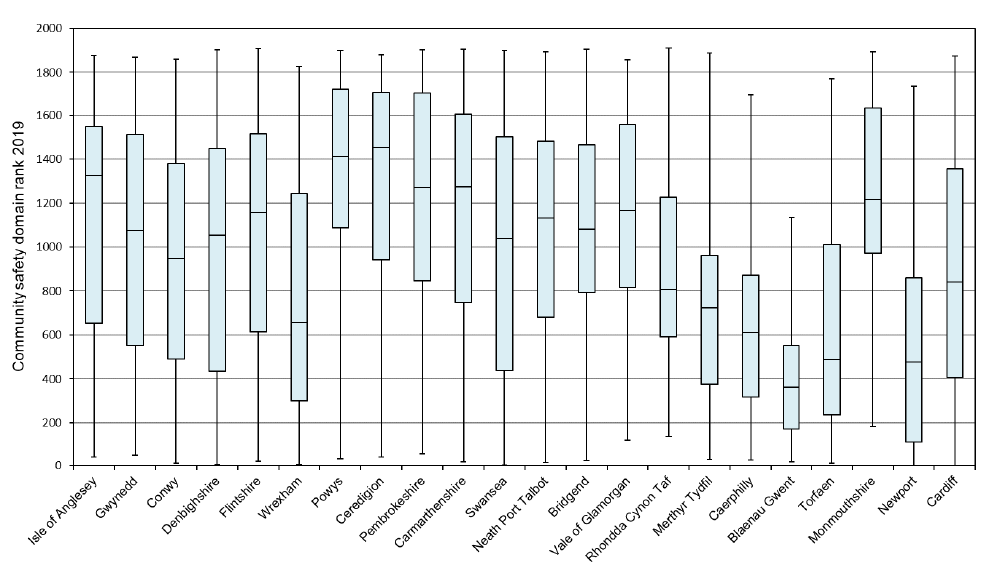
88
9.5. Community safety domain local authority analysis
The chart below shows the spread of community safety domain ranks for each local authority in
Wales. The blue boxes contain half the total number of areas in each local authority, centred on the
median (middle) rank for each local authority and the ‘whiskers’ show the full range of ranks.
Deprivation increases with decreasing rank (that is, towards the bottom of the plot).
Chart 10: Box plot of WIMD 2019 Community Safety domain ranks, by local authority

89
The table below shows, for the community safety domain of WIMD 2019, the percentage of small
areas (LSOAs) in each local authority which were in the most deprived 10%, 20%, 30% and 50%
areas in Wales.
Table 20: Concentrations of WIMD 2019 Community Safety deprived areas, by local
authority
Local authority
Number of
LSOAs in
local
authority
% LSOAs in
most-
deprived
10%
ranks 1-191
% LSOAs in
most-
deprived
20%
ranks 1-382
% LSOAs in
most-
deprived
30%
ranks 1-573
% LSOAs in
most-
deprived
50%
ranks 1-955
Isle of Anglesey 44 6.8 15.9 22.7 40.9
Gwynedd 73 6.8 12.3 27.4 41.1
Conwy 71 8.5 16.9 28.2 50.7
Denbighshire 58 10.3 22.4 29.3 39.7
Flintshire 92 8.7 13.0 25.0 39.1
Wrexham 85 18.8 31.8 47.1 68.2
Powys 79 5.1 7.6 11.4 20.3
Ceredigion 46 6.5 13.0 15.2 26.1
Pembrokeshire 71 8.5 16.9 21.1 31.0
Carmarthenshire 112 5.4 12.5 17.0 33.9
Swansea 148 10.1 21.6 27.7 47.3
Neath Port Talbot 91 5.5 11.0 18.7 37.4
Bridgend 88 2.3 10.2 12.5 40.9
Vale of Glamorgan 79 2.5 12.7 20.3 34.2
Rhondda Cynon Taf 154 3.2 9.7 23.4 58.4
Merthyr Tydfil 36 5.6 27.8 38.9 75.0
Caerphilly 110 14.5 30.0 46.4 77.3
Blaenau Gwent 47 27.7 53.2 78.7 97.9
Torfaen 60 15.0 38.3 58.3 71.7
Monmouthshire 56 1.8 5.4 7.1 23.2
Newport 95 35.8 47.4 54.7 75.8
Cardiff 214 11.2 22.9 36.9 57.5
Wales 1909 10 20 30 50

90
One way of considering WIMD data at the local authority level is to look at the proportion of areas
within the local authority that are in the most deprived 10% (or 20% etc) of all areas in Wales. This
method can be seen as identifying the concentration of the most deprived areas in a local authority,
rather than an average level of deprivation.
The local authority with the highest concentration of areas in the most deprived 10% in
Wales was Newport (35.8%, or 34 areas).
The local authority with the lowest proportion of areas in the most deprived 10% in Wales
was Monmouthshire (1.8%, or 1 LSOA). Only 20.3% of the areas in Powys were in the most
deprived 50% in Wales.
Blaenau Gwent had the highest percentage of areas in the most deprived 50% in Wales
(97.9%). The next highest was Caerphilly, with 77.3% of its areas in the most deprived half
of Wales.
9.6. Community Safety domain methodological changes between WIMD 2014 and
WIMD 2019
Minor changes have been made to the methodology for constructing the crime and incident
numerators. These changes include the adoption of the same geographical aggregation technique
and constraining technique as used in the Crime Domain of the English Indices of Deprivation 2019.
The two-stage quality assurance process with the police forces also mirrors that adopted in the
Crime Domain of the English Indices of Deprivation 2019. For further details, please see the WIMD
2019 Technical Report.
In addition, small changes to the detailed categories composing each of the recorded crime
indicators were necessitated due to changes to the Home Office Counting Rules since the
publication of WIMD 2014.
9.7. Community Safety domain background information
Police Recorded Crime
Since the publication of WIMD 2014, there has been a renewed focus on the quality of crime
recording by the police. This follows the inspections of forces by Her Majesty’s Inspectorate of
Constabulary (HMIC), the Public Administration Select Committee (PASC) inquiry into crime
statistics and the UK Statistics Authority’s decision to remove the National Statistics designation
from police recorded crime statistics in January 2014.
This renewed focus is thought to have led to improved compliance with the National Crime
Recording Standard (NCRS), leading to the recording of a greater proportion of crimes coming to
the attention of the police. It was considered and agreed by the community safety domain group that
police recorded crime data remained the best source of crime data available for WIMD 2019 at the
small area level.

91
Police.UK
The Police.UK website allows users to explore and compare crime and outcomes of crime in local
areas.
Additional Crime Data: The Crime Survey for England and Wales
The Crime Survey for England and Wales measures the extent of crime in England and Wales by
asking people whether they have experienced any crime in the past year. The Crime Survey
records crimes that may not have been reported to the police and it is therefore used alongside the
police recorded crime figures to show a more accurate picture of the level of crime in the country.
An additional element that the Crime Survey provides is information on perceptions of crime and
anti-social behaviour. This is a key element of community safety deprivation, in terms of feeling safe
whilst out and about in your local area. Data and further information on the Crime Survey for
England and Wales can be found on the Office for National Statistics' website. These data are not
included in WIMD 2019, as the data are not statistically robust below a Wales level.
Feeling unsafe – National Survey for Wales
The National Survey for Wales asks about feeling unsafe after dark in your local area. Perceptions
of safety are included in the definition of community safety deprivation. Further information and data
can be found on the Welsh Government website.
Violence Against Women, Domestic Abuse and Sexual Violence.
Earlier this year the Welsh Government consulted on a range of indicators to underpin its Violence
Against Women, Domestic Abuse and Sexual Violence (VAWDASV) strategy. The responses to this
consultation have been reviewed and ongoing stakeholder engagement is currently being
undertaken to further inform indicator development.
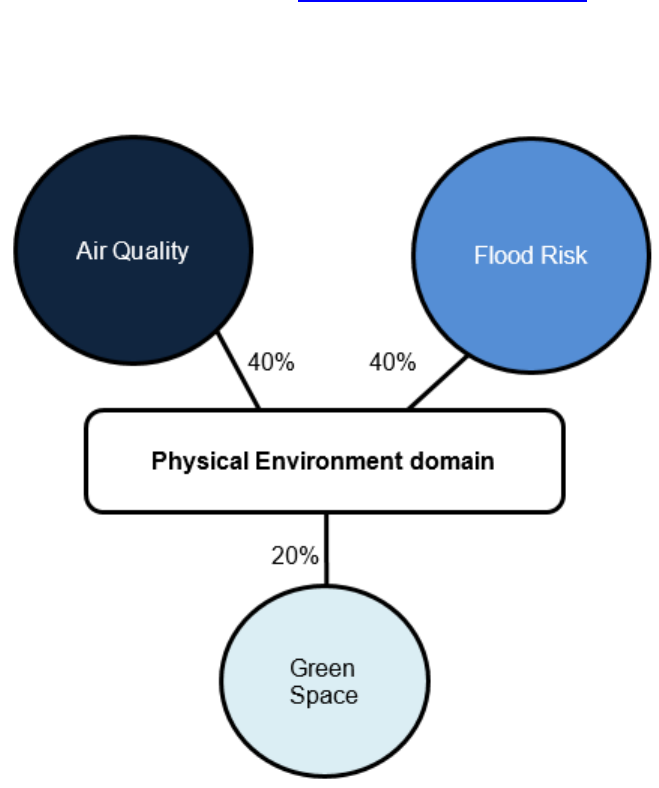
92
10. Physical Environment Domain
10.1. Introduction
The purpose of this domain is to measure factors in the local area that may impact on the wellbeing
or quality of life of those living in an area. The domain has a relative weight of 5% in the overall
index. The sub domains and indicators are weighted as shown below. For a complete description of
the construction of the domain, please see the WIMD 2019 Technical Report.
10.2. Indicators
The domain contains three sub domains, weighted as shown below:
The air quality sub-domain comprises three indicators which measure the population weighted
average concentration values of the key pollutants Nitrogen dioxide (NO
2
), Particulates < 10 µm
(PM
10
) and Particulates < 2.5 µm (PM
2.5
) respectively. The indicator values are based on pollutant
levels from 2017 DEFRA air concentration grids and are population-weighted then combined to form
an air quality sub domain score.
The flood risk sub domain score is based on the proportion of households at risk of flooding from
rivers, the sea or surface flooding and is sourced from Natural Resources Wales’ Flood Risk
Assessment Wales (FRAW) dataset.

93
The green space sub domain is comprised of two equally weighted indicators:
Proximity to accessible natural green space indicator which measures the proportion of
households in each area that are within a 5 minute walk / 300 metres of an accessible,
natural green space, and
Ambient green space score which measures the ambient greenness of an area using the
mean household Normalised Difference Vegetation Index (NDVI) score within a 300 metre
buffer around each residential dwelling.
Further guidance to help interpretation and understanding of the green space sub-domain indicator
data can be found in section 10.6. A full explanation of how these indicators are calculated and
combined together can be found in the WIMD 2019 Technical Report.
10.3. Physical Environment domain key results
In the WIMD 2019 physical environment domain, there were pockets of high deprivation in
and around the large cities in South East Wales and, to a lesser extent, the South Wales
valleys. On the whole, deprivation levels were lower in the North Wales local authorities.
This is shown in the map below.
The local authorities with the highest concentration of areas in the most deprived 10% were
Newport (43.2%) and Cardiff (43.0%). Whereas Blaenau Gwent, Conwy, Isle of Anglesey,
Pembrokeshire and Wrexham had no areas in the most deprived 10%.
In the physical environment domain, the most deprived small area in Wales was Penylan 5
in Cardiff, the area around Waterloo Gardens and part of Newport Road.
The overall patterns of physical environment deprivation in WIMD 2019 are notably different
to those for WIMD 2014. However, this is partly due to a number of methodological changes
between WIMD 2014 and WIMD 2019. These changes have been designed and
implemented to better reflect deprivation in terms of physical environment and how it impacts
on peoples’ wellbeing or quality of life. Further information can be found in section 10.6.
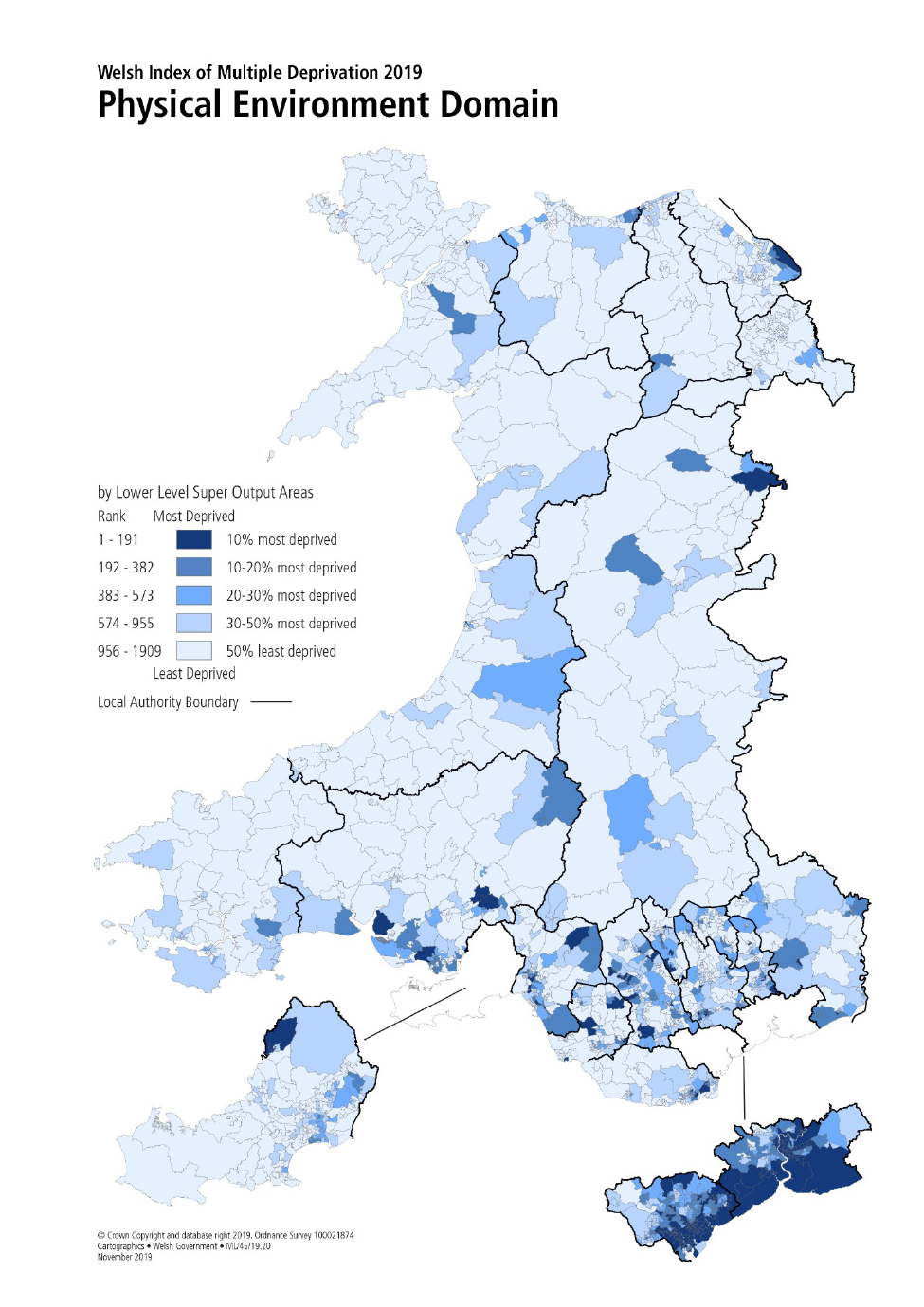
94

95
10.4. Physical Environment domain comparison between WIMD 2014 and
WIMD 2019
The full set of domain ranks from WIMD 2019 and the underlying indicators can be downloaded
from the Welsh Government’s StatsWales web pages.
The table below shows the number of small areas (LSOAs) in each of the WIMD deprivation groups
for WIMD 2014 and WIMD 2019. The diagonal, in bold, shows the number of areas which have
remained in the same deprivation group. Above the diagonal are numbers of areas which have
moved from a more to a less deprived group. Below the diagonal are the numbers of areas which
have moved from a less to a more deprived group.
Table 21: Movement between Physical Environment deprivation group between
WIMD 2014 and 2019
Caution should be used in interpreting the table above. A number of methodological changes to the
domain mean that it is difficult to interpret changes between WIMD 2014 and WIMD 2019. See
section 10.6 for further details.
Relatively more deprived: 99 areas have moved into the 10% most deprived group for this domain
in WIMD 2019. Over half of these areas were in Cardiff or Newport with the remainder spread
across 13 other local authorities. The movements were driven by changes in all of the sub domains.
However, the 13 areas moving from the least deprived 50% into the 10% most deprived were
10% most
deprived
(ranks
1-191)
10-20%
most
deprived
(ranks
192-382)
20-30%
most
deprived
(ranks
383-573)
30-50%
most
deprived
(ranks
574-955)
50% least
deprived
(ranks
956-1909)
Total
(ranks
1-1909)
10% most
deprived
(ranks 1-191)
92 29 18 26 26 191
10-20% most
deprived
(ranks 192-382)
47 37 26 31 50 191
20-30% most
deprived
(ranks 383-573)
22 38 27 42 62 191
30-50% most
deprived
(ranks 574-955)
17 51 58 96 160 382
50% least
deprived
(ranks 956-1909)
13 36 62 187 656 954
Total
(ranks 1-1909)
191 191 191 382 954 1909
Physical Environment domain 2019
Physical Environment domain 2014

96
primarily attributable to a combination of the inclusion of surface flooding in the flood risk sub
domain and/or the introduction of the green space sub domain.
Relatively less deprived: 99 areas have moved out of the 10% most deprived group for this domain
in WIMD 2019. These areas were spread across 17 local authorities. However, nearly a third of
these areas (31) were in Flintshire which was notably affected by the methodological changes to the
sub-domains (in particular, the inclusion of the green space sub-domain and the exclusion of the
proximity to waste disposal and industrial site sub-domain). Twenty-six areas moved 5 or more
deciles and these movements were primarily due to the introduction of the green space sub-domain.
Changes to the air quality sub-domain were also a contributory factor.
10.5. Physical environment domain local authority analysis
The chart below shows the spread of physical environment domain ranks for each local authority in
Wales. The blue boxes contain half the total number of areas in each local authority, centred on the
median (middle) rank for each local authority and the ‘whiskers’ show the full range of ranks.
Deprivation increases with decreasing rank (that is, towards the bottom of the plot).
Chart 11: Box plot of WIMD 2019 physical environment domain ranks, by local
authority

97
The table below shows, for the physical environment domain of WIMD 2019, the percentage of
small areas (LSOAs) in each local authority which were in the most deprived 10%, 20%, 30% and
50% areas in Wales.
Table 22: Concentrations of WIMD 2019 Physical Environment deprived areas, by
local authority
Local authority
Number of
LSOAs in
local
authority
% LSOAs in
most-
deprived
10%
ranks 1-191
% LSOAs in
most-
deprived
20%
ranks 1-382
% LSOAs in
most-
deprived
30%
ranks 1-573
% LSOAs in
most-
deprived
50%
ranks 1-955
Isle of Anglesey 44 0.0 0.0 0.0 2.3
Gwynedd 73 1.4 2.7 2.7 16.4
Conwy 71 0.0 2.8 12.7 21.1
Denbighshire 58 1.7 5.2 5.2 25.9
Flintshire 92 1.1 5.4 9.8 23.9
Wrexham 85 0.0 0.0 3.5 8.2
Powys 79 1.3 3.8 8.9 26.6
Ceredigion 46 2.2 2.2 6.5 23.9
Pembrokeshire 71 0.0 1.4 4.2 36.6
Carmarthenshire 112 3.6 21.4 32.1 47.3
Swansea 148 1.4 4.7 16.2 35.8
Neath Port Talbot 91 8.8 26.4 33.0 59.3
Bridgend 88 4.5 9.1 22.7 39.8
Vale of Glamorgan 79 6.3 10.1 24.1 59.5
Rhondda Cynon Taf 154 7.1 20.1 35.1 63.0
Merthyr Tydfil 36 13.9 22.2 33.3 52.8
Caerphilly 110 6.4 15.5 25.5 57.3
Blaenau Gwent 47 0.0 8.5 23.4 48.9
Torfaen 60 6.7 13.3 30.0 68.3
Monmouthshire 56 5.4 30.4 42.9 67.9
Newport 95 43.2 68.4 80.0 95.8
Cardiff 214 43.0 67.3 85.0 98.6
Wales 1909 10 20 30 50
98
One way of considering WIMD data at the local authority level is to look at the proportion of areas
within the local authority that are in the most deprived 10% (or 20% etc) of all areas in Wales. This
method can be seen as identifying the concentration of the most deprived areas in a local authority,
rather than an average level of deprivation.
The local authority with the highest concentration of areas in the most deprived 10% in
Wales was Newport (43.2%, or 41 areas) closely followed by Cardiff (43.0%, or 92 areas).
This is primarily attributable to the impact of the air quality and green space sub-domains.
The local authorities with the lowest proportion of areas in the most deprived 10% in Wales
were Blaenau Gwent, Conwy, Isle of Anglesey, Pembrokeshire and Wrexham who had none
of their areas in the most deprived 10%. Only 2.3% of the areas in Isle of Anglesey were in
the most deprived 50% in Wales.
Cardiff had the highest percentage of areas in the most deprived 50% in Wales (98.6%). The
next highest was Newport, with 95.8% of its areas in the most deprived half of Wales.
10.6. Physical environment domain methodological changes between WIMD
2014 and WIMD 2019
Air Quality sub-domain
The indicators in the air quality sub domain were simplified to focus on the pollutants Nitrogen
dioxide (NO
2
), Particulates < 10 µm (PM
10
) and Particulates < 2.5 µm (PM
2.5
). This change was
intended to align the sub-domain more closely with the national well-being indicators and to reflect
that these three pollutants are of prime concern to health nationwide. However, the exclusion of
certain pollutants (for example, Sulphur Dioxide) may contribute to historically heavily industrial
areas seeming to be less deprived than in WIMD 2014.
Flood Risk sub-domain
The WIMD 2019 flood risk sub-domain was calculated using a beta version of the Flood Risk
Assessment Wales (FRAW) dataset as provided by Natural Resources Wales. This dataset differs
significantly in terms of modelling methodology and inputs from the National Flood Risk Assessment
(NaFRA) flood risk dataset used to inform WIMD 2014.
In particular, the FRAW dataset includes information on flood risk from rivers, the sea and surface
water flooding. However, this is a change from WIMD 2014 where the flood risk sub-domain data
did not consider surface water flooding.
The inclusion of risk arising from surface water flooding has resulted in higher levels of deprivation
due to flooding being observed in certain local authorities. In particular, a number of areas in
Merthyr Tydfil and Rhondda Cynon Taf become markedly more deprived when surface water
flooding is considered.

99
Green Space sub-domain
The green space sub-domain has been developed to replace the proximity to waste disposal and
industrial sites sub-domain that was previously included in WIMD 2014.
The proximity to waste disposal and industrial sites sub-domain was originally developed as a proxy
measure to capture the general quality of life arising from living in a particular area. However, it had
some known limitations as it estimated the impact of regulated waste disposal and industrial sites
but did not capture proximity to non-regulated sites (which arguably will have more impact on the
surrounding environment).
Natural green space is considered to have a positive impact on people’s well-being and the green
space sub-domain has been developed to capture deprivation arising from its absence. Given that
the green space sub domain and the proximity to waste disposal and industrial sites sub domain are
measuring conceptually distinct things, we would expect to see differences between them.
Note that both indicators in the green space sub domain focus on the area immediately surrounding
the residential dwellings within an area as opposed to the LSOA area in its entirety. This aligns with
the methodologies underpinning the air quality and flood risk sub-domains (which are population-
weighted and focussed on households in flood risk areas respectively).
Further to this, the green space sub-domain specifically looks at proximity to accessible, natural
green space – i.e. sites that could confidently be described as ‘natural feeling’ places to which the
public have right of access.
Therefore, some rural or semi-rural areas may have higher levels of green space deprivation than
expected due to the inaccessibility of green space in the area and/or the absence of green space in
close proximity to residential dwellings in the area.
We will continue to monitor ongoing developments in the measurement of green space and, where
appropriate, consider refinements to this sub domain for the next iteration of WIMD.
10.7. Physical Environment domain background information
Air quality
Further information on the UK Government’s Pollution Climate Mapping (PCM) model which
calculates average pollutant concentrations for each square kilometre of the UK can be found on
the DEFRA website. Information on national well-being indicator 5 (Levels of Nitrogen Dioxide
pollution in the air) can be found on the Welsh Government Well-being of Wales website.
Flood risk
A range of reports, evidence and data on flooding can be found on the Natural Resources Wales
website.

100
Green space
Data on people’s perceptions of and satisfaction with local green space is collected as part of the
National Survey for Wales. Headline results can be found in the National Survey for Wales Results
Viewer.
A Green Space Index including data for Wales has been published by Fields in Trust.

101
Annex A: Further background to WIMD
1. Development and User engagement
During 2018, statisticians at the Welsh Government worked with seven expert topic groups to
review indicators used in WIMD 2014 and to consider potential new indicators for WIMD 2019. Each
topic group included analytical experts from the Welsh Government, local authorities, other public
bodies (for example, Natural Resources Wales, Public Health Wales) and policy representatives
from the Welsh Government. An Advisory Group including key users of the Index from public bodies
and third sector organisations also helped shape the proposals.
A public consultation on proposed indicators for WIMD 2019 was held between October and
December in 2018. The purpose of this consultation was to expose proposals for the domains and
indicators for WIMD 2019 to critical review. Responses were received from a range of different
organisations and individuals. A summary of these responses, and changes made in light of
consultation responses, was published in April 2019.
We will continue to share information with users about WIMD 2019, and seek input to future
iterations through seminars, conferences and bespoke events. We welcome any feedback on any
aspect of these statistics which can be provided by email to stats.inclusion@gov.wales.
2. Key quality information
WIMD is a complex statistical product drawing on a range of data sources, some National or Official
Statistics themselves, others based on administrative datasets. A brief summary of quality
information is provided below along with links to further information. More detailed documentation of
WIMD 2019 quality information will be made available in future, based on the Office for Statistics
Regulation’s Administrative Data Quality Assurance Toolkit.
Relevance
Our Consultation documents outline the rationale behind the choice of indicators to reflect different
aspects of deprivation.
Accuracy
WIMD 2019 follows on from the previous iterations of the index and has been designed to ensure
the reliability of results. Our Consultation document includes details of the indicator criteria applied.
WIMD 2019 brings together 47 independent indicators from a wide range of data sources, which
ensures robustness of the overall results. Areas that are very deprived according to WIMD are likely
to be very deprived on a number of the domains. Due to the variety of data inputs, there is little
chance that an area is identified as very deprived due to a bias in any one of the underlying
indicators.

102
In terms of the accuracy of the processing of the underlying data, there was an agreed Quality
Assurance plan for WIMD 2019 which outlined several stages of data checks, including:
Replicating results for any new or changed indicators with different analysis tools
Sense-checking data with the expert topic groups, and local authority representatives
Timeliness and punctuality
We use the latest available information for all indicators. Our Technical Report described the time
period associated with each indicator, and this has also been brought together in a spreadsheet for
ease of reference.
Accessibility and clarity
In 2016 we surveyed users about our WIMD 2014 results package, and since users were broadly
content with the 2014 offering, we have continued to produce the same range of outputs, with
improvements where possible. We have published results in a range of formats to help different
types of users access and interpret WIMD results. Full details and signposting is available on the
WIMD webpages.
Comparability and coherence
Our Guidance provides further information about indices of deprivation for the other three countries
of the UK, and why results should not be compared across countries.
3. National Statistics status
The United Kingdom Statistics Authority has designated these statistics as National Statistics, in
accordance with the Statistics and Registration Service Act 2007 and signifying compliance with the
Code of Practice for Statistics.
National Statistics status means that official statistics meet the highest standards of trustworthiness,
quality and public value.
All official statistics should comply with all aspects of the Code of Practice for Statistics. They are
awarded National Statistics status following an assessment by the UK Statistics Authority’s
regulatory arm. The Authority considers whether the statistics meet the highest standards of Code
compliance, including the value they add to public decisions and debate.
It is Welsh Government’s responsibility to maintain compliance with the standards expected of
National Statistics. If we become concerned about whether these statistics are still meeting the
appropriate standards, we will discuss any concerns with the Authority promptly. National Statistics
status can be removed at any point when the highest standards are not maintained, and reinstated
when standards are restored.
These statistics last underwent a full assessment against the Code of Practice in 2010.

103
Annex B: List of all indicators included in WIMD 2019
Additional information is available in the Technical Report.
Indicator
Units
Denominator
Indicator
Year(s)
Data Source
Income Domain
Percentage of population in receipt
of income-related benefits
Percentage
Small Area
Population
Estimates 2016
(minus 2016
prison
population),
ONS
Defined as those who are either:
(a) An adult, or dependent child of
an adult, in receipt of income
related benefits
2016/17
Department
for Work and
Pensions
(DWP)
(b) An adult, or dependent child of
an adult, in receipt of Working and
Child Tax Credits, with income less
than 60% of the Wales median
Aug-15
Her Majesty’s
Revenue and
Customs
(HMRC)
(c) An Asylum Seeker (as defined
by Section 95)
Jun-17
Home Office
(HO)
(d) People on Universal Credit
(except those “working with no
requirements”)
2016/17
DWP
Employment Domain
Percentage of working-age
population in receipt of employment
related benefits (job-seekers
allowance, employment support
allowance, or Universal Credit and
not in employment)
Percentage
Small Area
Population
Estimates 2016
(minus 2016
prison
population),
ONS
2016/17
DWP
Health
People with a GP-recorded
diagnosis of a Chronic condition
(indirectly age-sex standardised)
[Coronary Heart Disease, Chronic
Obstructive Pulmonary Disease,
Stroke and Transient Ischaemic
Attack, Peripheral Arterial Disease,
Chronic Kidney Disease, Diabetes
Mellitus, or Epilepsy]
Rate per
100
Small Area
Population
Estimates 2018
(minus 2018
prison
population),
ONS
31st
March
2019
NHS Wales
Informatics
Service
Limiting Long-Term Illness
(indirectly age-sex standardised)
Rate per
100
LSOA
population,
Census
2011
2011 Census,
Office for
National
Statistics
(ONS)

104
Indicator
Units
Denominator
Indicator
Year(s)
Data Source
Health (continued)
Premature Death Rate (death of
those under the age of 75)
Rate per
100,000
Small Area
Population
Estimates, ONS
2009-18
(10 year
average)
Death
Registrations,
ONS
People with a GP-recorded diagnosis
of a mental health condition
[Depression, Low mood (with active
repeat prescription for an anti-
depressant), Anxiety disorder
(including panic disorders),
Dementia, Severe mental illnesses
(schizophrenia, bipolar affective
disorder and other psychoses)]
Rate per
100
Small Area
Population
Estimates 2018
(minus 2018
prison
population),
ONS
31st
March
2019
NHS Wales
Informatics
Service
Cancer Incidence (indirectly age-sex
standardised)
Rate per
100,000
Small Area
Population
Estimates, ONS
2007-16
(10 year
average)
Welsh Cancer
Intelligence and
Surveillance
Unit, Velindre
NHS Trust
Low Birth Weight, Single Births (live
births less than 2.5 Kg)
Percentage
Number of
singleton live
births
2009-18
(10 year
average)
Birth
Registrations,
ONS
Children aged 4-5 who are Obese
Percentage
Number of
children aged 4-
5, CMP
2012/13 -
2017/18
Child
Measurement
Programme
(CMP), Public
Health Wales
Indicator
Units
Denominator
Indicator
Year(s)
Data Source
Education
Foundation Phase Average Point
Score
Point score
Total number of
pupils in
National
Curriculum Year
Group 2
Academic
Years
2015/16 -
2017/18
Pupil Level
Annual School
Census
(PLASC), NDC
Key Stage 2 Average Point Score
Point score
Total number of
pupils in
National
Curriculum Year
Group 6
Academic
Years
2015/16 -
2017/18
PLASC, NDC
Key Stage 4 Average Point Score for
Core Subjects
Point score
Total number of
pupils in
National
Curriculum Year
Group 11
Academic
Years
2015/16 -
2017/18
PLASC, NPD,
WED

105
Indicator
Units
Denominator
Indicator
Year(s)
Data Source
Education (continued)
Repeat Absenteeism
Percentage
Total numbers of
Primary and
Secondary pupils
Academic
Years
2015/16 -
2017/18
PLASC, NPD
Proportion of Key Stage 4 leavers
entering Higher Education
Percentage
Proportion of Key
Stage 4 leavers
entering Higher
Education
Academic
Years
2011/12 -
2014/15
PLASC, HESA,
LLWR
Number of adults aged 25-64 with
No Qualifications
Percentage
Total population
aged 25-64,
Census
2011
2011 Census,
ONS
Access to Services Domain
Physical Access – average return
travel times to key services by
public and private transport: food
shops, GP surgeries, primary
schools, secondary schools, post
office, public library, pharmacy,
sports facility, petrol station (private
transport only)
Minutes
N/A
Mar-19
Welsh
Government
Digital Access - % Unavailability of
broadband at 30Mb/s
Percentage
Number of
premises
Jan-19
The Office of
Communications
(Ofcom)
Housing
Percentage of people living in
overcrowded households (bedroom
measure)
Percentage
Number of people
living in
households,
Census
2011
2011 Census,
ONS
Likelihood of poor quality housing
(being in disrepair or containing
serious hazards)
Percentage
(likelihood)
Number of
residential
dwellings
2017/18
Building
Research
Establishment
Two sub-indicators are also
published, the likelihood that
dwellings:
• contain a Category 1 hazard for
excess cold, falls or other hazards
under the Housing Health and
Safety Rating System (HHSRS)
• are in a state of disrepair (at least
one of the key building components
is old and needs replacing or major
repair due to its condition; or more
than one of the other building
components are old and need
replacing or major repair)

106
Indicator
Units
Denominator
Indicator
Year(s)
Data Source
Physical Environment
Population weighted average
concentration values of Nitrogen
dioxide (NO
2
)
Values
N/A
2017
DEFRA,
ONS
Population weighted average
concentration values of
Particulates < 10 µm (PM
10
)
Values
N/A
2017
DEFRA,
ONS
Population weighted average
concentration values of
Particulates < 2.5 µm (PM
2.5
)
Values
N/A
2017
DEFRA,
ONS
Proximity to Accessible, Natural
Green Space – measuring the
proportion of households within
300 metres of an accessible,
natural green space
Percentage
Number of
households in
LSOA
2017
OS
MasterMap
Topography
Layer,
AddressBase
Plus
Ambient Green Space Score –
measuring the mean household
Normalised Difference Vegetation
Index (NDVI)
Score
N/A
n/a -
Aerial
Imagery
captured
over re-
visional
time
series
WISERD
Flood Risk
Score
(between 1
and 100)
N/A
2017
FRAW, NRW
Community Safety
Police Recorded Criminal
Damage
Rate (per
100)
Small Area
Population
Estimates
2017 (minus
2017 prison
population),
ONS
2017/18,
2018/19
Welsh Police
Forces
Police Recorded Violent Crime
Police Recorded Anti-Social
Behaviour
Police Recorded Burglary
Police Recorded Theft
Fire Incidents
Rate (per
100)
Small Area
Population
Estimates
2017 (minus
2017 prison
population),
ONS
2017/18,
2018/19
Incident
Recording
System
(IRS), Welsh
Government
